- AROUND THE SAILING WORLD
- BOAT OF THE YEAR
- Email Newsletters
- America’s Cup
- St. Petersburg
- Caribbean Championship
- Boating Safety
- Ultimate Boat Giveaway


2024 Boat of the Year: HH44
- By Dave Reed
- December 18, 2023
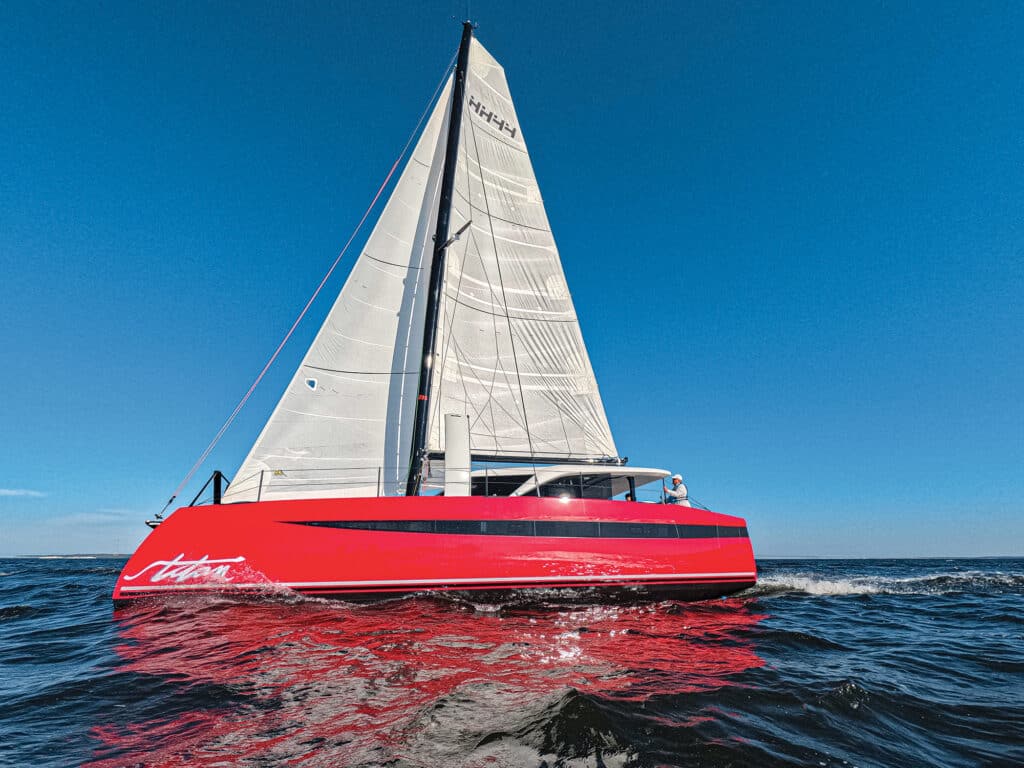
On a cool late-October morning in Annapolis, Maryland, Sailing World ’s Boat of the Year judges stepped on board the gleaming red HH44 built by the Hudson Yacht Group in China. With them for the test sail was HH Catamarans president Seth Hynes and commissioning skipper Chris Bailet, who had tuned the rig and bent on the boat’s Dacron delivery sails. (The race sails were delayed in shipping.) It was their first time sailing the boat too, and like the judges, they were eager to see what it could do.
As the crew slipped dock lines and motored away in silence, the boat’s twin 10-kilowatt electric engines propelled the sleek catamaran through the mooring field in silence. If not for the sound of water gurgling from the transoms and the apparent wind blowing across the foredeck, the judges could barely tell they were underway.
The mainsail was then carefully hoisted inside the lazy jacks, and the halyard held firm with an innovative Karver KJ cone (a conical rope-holding device that acts like a restricter). They bore away and unfurled the non-overlapping jib, which snapped full, and the boat immediately accelerated.
“Once we got going, it was 5, 6, 7 knots and then—boom—we’re right up to 10,” Stewart says. And with that they were laying tracks all over the Chesapeake Bay, making good pace on all points of sail, even without a reaching sail to deploy. (That too was stuck in transit.)

After two hours of straight-lining, tacking, jibing, and enjoying the comforts of the interior in a 10- to 15-knot southerly and sharp Chesapeake chop, I extracted the judges from the boat and asked, “So?”
“Boat of the Year,” was veteran Boat of the Year judge Chuck Allen’s immediate response. “That thing is wicked.”
Greg Stewart and Mike Ingham confirmed with nods of approval and big grins. There was no need to debate any further: The HH44 had earned the first award of what will be more to come. This $2 million crossover catamaran is the performance sailor’s retirement race boat. [Editor’s note: The judges’ estimated price was based on an expected racing inventory and associated hardware, but according to HH Catamarans, the new 2024 pricing is as follows: The HH44-OC will start at $995K and is approximately $1.3m fully optioned with EcoDrive and sails). The HH44-SC will start at $1.45m and be approximately $1.6 million fully optioned with EcoDrive and sails.]
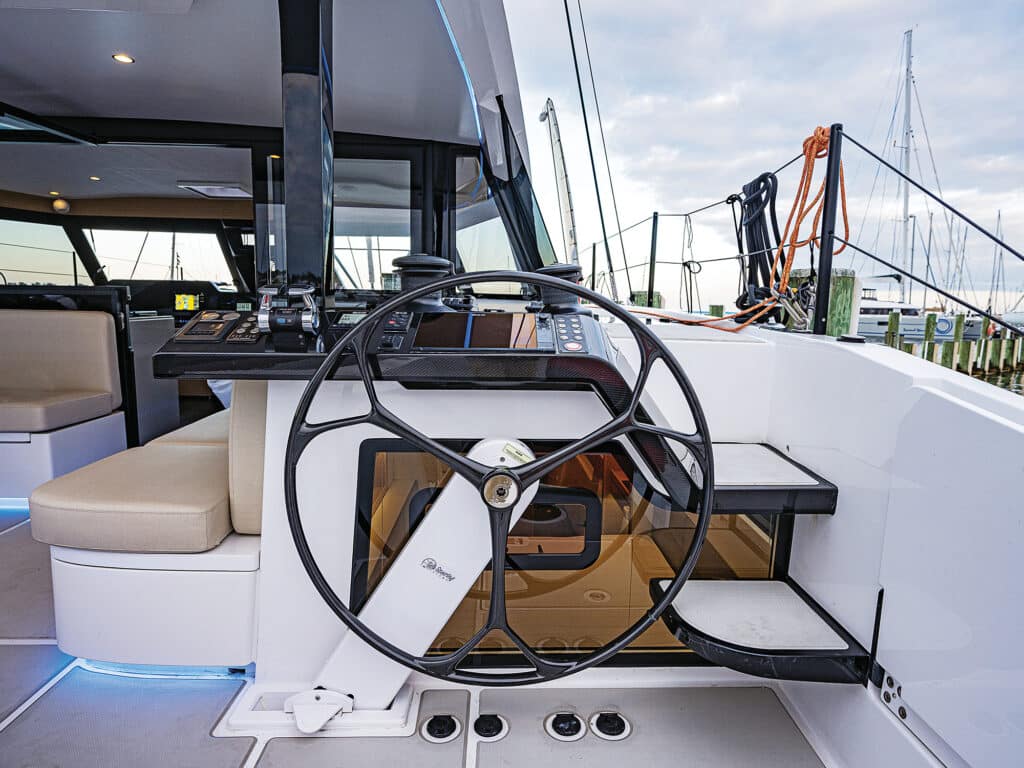
With a stated 37 of these 44-footers on order as of late October and a waiting list of three-plus years, HH44s will someday be scattered about in cruising grounds around the world, says Hynes. But it’s only a matter of time—and it will be sooner than later—before owners gather and give the racing thing a go.
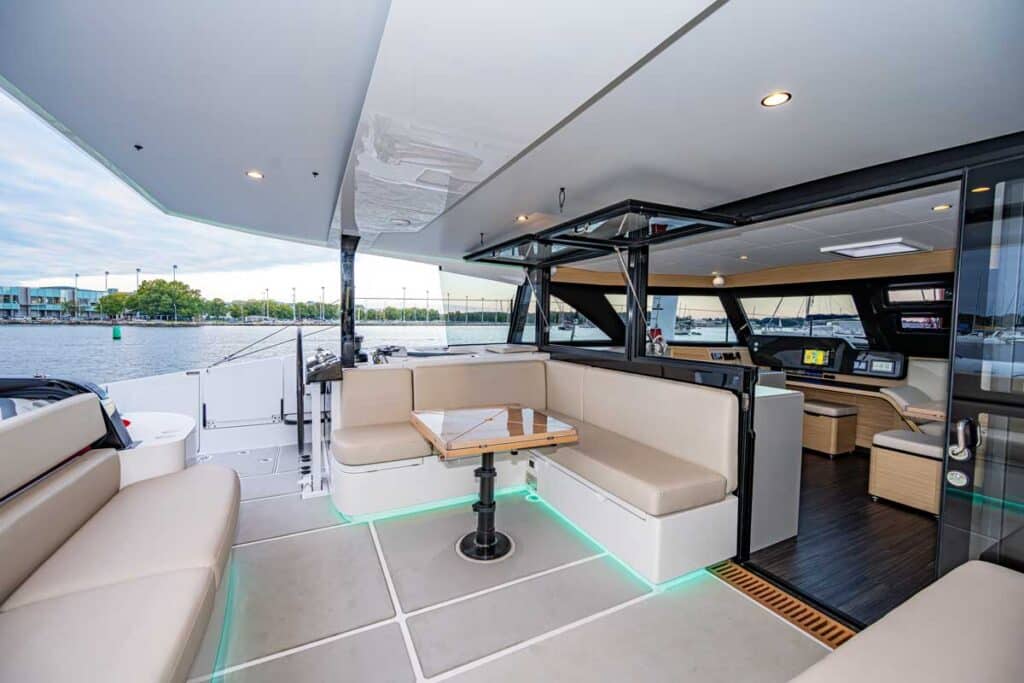
The HH44 is the smallest of the builder’s new lineage of hybrid-powered performance catamarans (there is a 52-footer in the works), so it is positioned as an entry point into big-cat sailing. This model does not require a professional captain or crew because simplicity and owner-operator considerations are prevalent throughout the boat, which is designed by young naval architect James Hakes, son of Paul Hakes, one of the company founders. Chinese entrepreneur Hudson Wang is the other “H” of HH Catamarans.
“It had a great groove upwind. The self-tacking jib was really easy to deal with, and for the mainsail it was just a few feet of ease on the mainsheet, adjust the powered traveler up to center, trim on and go.”
“James brought the hybrid idea with him, and Hudson was willing to take a risk and look at doing something kind of game-changing in the industry with our parallel-hybrid approach,” Hynes says. Morrelli & Melvin was intimately involved in every performance aspect of the boat, from the appendages to the final hull profile.
“It’s a diesel engine with a shaft drive, and then independent of that is an electric motor with a belt to the shaft, so they’re really independent of each other,” Hynes explains.
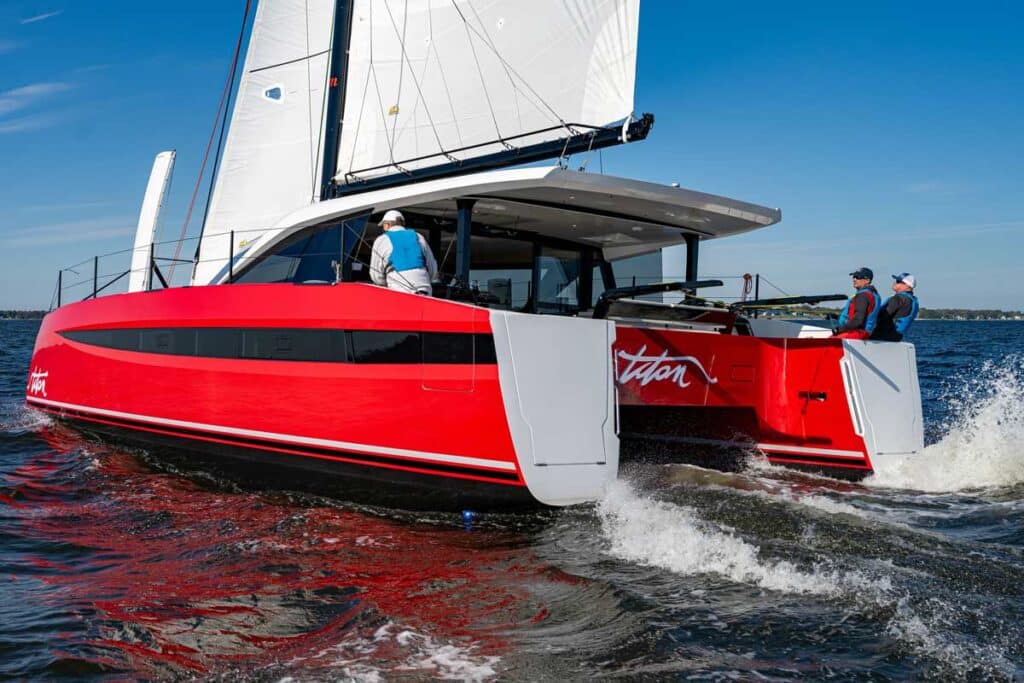
HH isn’t the first or only builder to use the system from Hybrid Marine, but Hake’s approach to the boat overall is inextricably linked to maximizing solar coverage, which means a clean roof and placing the helm stations down in the cockpit. To address the known challenges of cockpit steering in such catamarans, the steering wheels pivot inboard and outboard to allow for better forward visibility and communication with anyone on the foredeck dealing with sails, anchors or dock lines.
Placing the steering stations in the cockpit eliminates the tiered wedding-cake look of most big catamarans these days. More importantly, doing so allows them to lower the sail plan. “That allows for more sail area and less stress on the standing rigging,” Stewart says. “Plus, it looks so much better.”
There are 4,432 watts worth of solar panels piled onto the coach roof, which Hynes says has plenty of juice to get by off the grid, even in low-light conditions. “At full battery capacity, you can run the boat at full throttle using the two 10-kilowatt electric motors and get 7 knots of boatspeed for approximately two hours,” he says. “In light air, you can even keep your leeward electric motor running to build yourself some apparent wind. That’s what’s great about this system: You can sail quietly when no one else can sail at all.”
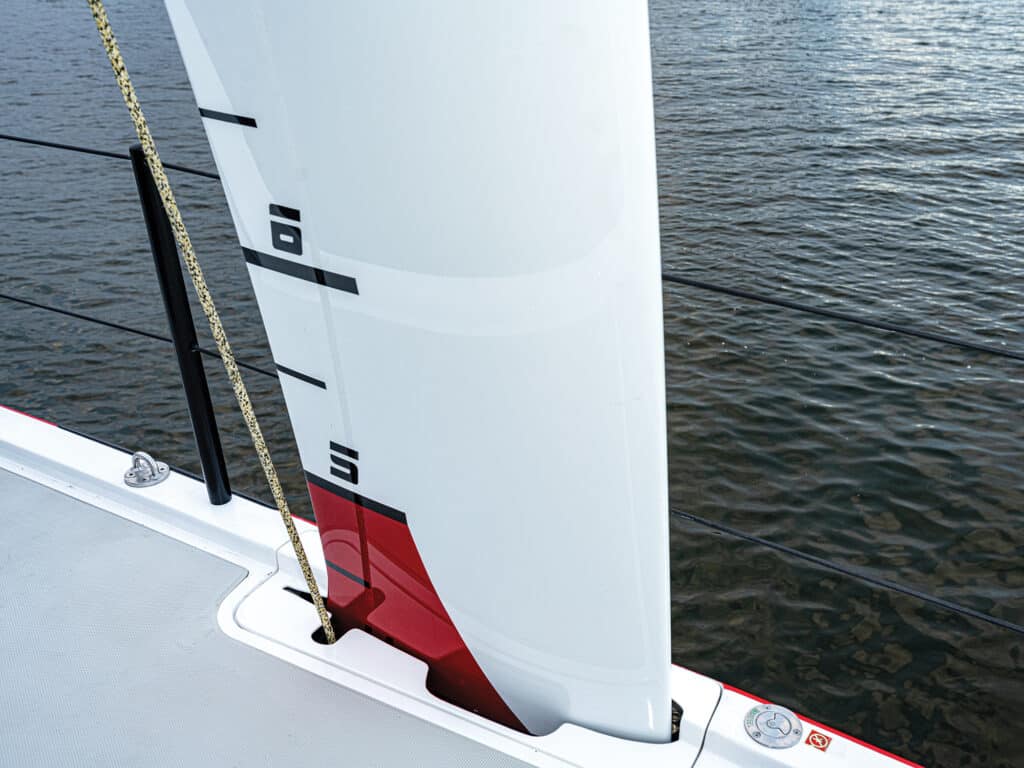
The port helm station is where a lot of the boathandling happens; there are powered halyard winches and a meticulous array of labeled jammers. Tails disappear into a deep trough forward of the pedestal. The wheels are sized just right, Stewart says. “Initially, I was steering from the weather wheel and I could see fine, and when I went to the leeward wheel, I could easily see the telltales. It had a great feel to the helm—light and responsive with no slop or tightness.”
In Allen’s sailing assessment of the HH44: “It had a great groove upwind. The self-tacking jib was really easy to deal with, and for the mainsail it was just a few feet of ease on the mainsheet, adjust the powered traveler up to center, trim on and go. There is some choreography to learn with the steering wheel, though. You have to move the wheel inboard to get better access to the sail and daggerboard controls during the tack. But once you’re done, you pop the wheel right back out to the outboard position. We didn’t have a screecher to really light it up downwind, but even with the Dacron jib and main, the boat took off. I was really impressed.”
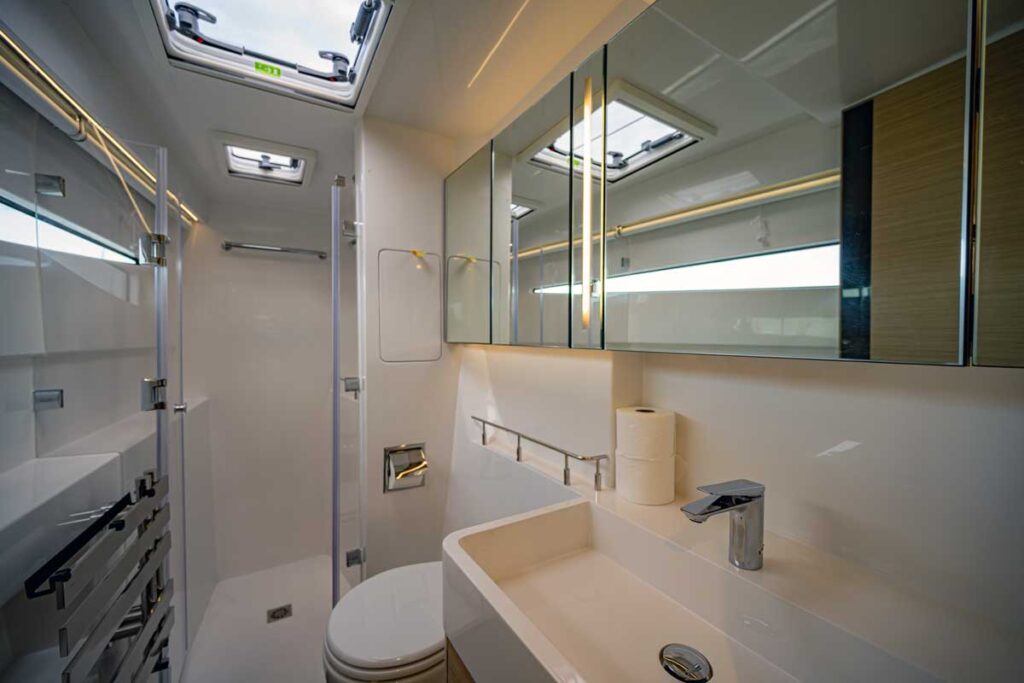
One wish for Stewart would be a sliver of a coach roof window for quick sail-trim checks, but he understood the priority of using every inch of solar-panel coverage.
Not having a sail-trim window wasn’t an issue for Ingham, however. “Most of the time, you’ll trim it to your best guess, take a step outboard and up the stairs right next to the wheel, and check yourself on the trim. It’s all push buttons anyway, so you’re not having to reload a winch or anything like that every time you make an adjustment.”
Even as the morning’s fresh breeze abated, the boat continued to perform beyond expectations, Stewart says. “As we got down to 5 knots of wind, the boat was still quick through the tacks. We didn’t have to back the jib at all, and it sailed at good angles upwind. I was impressed with how well it tacked, and how well it tracked with only one daggerboard down.”
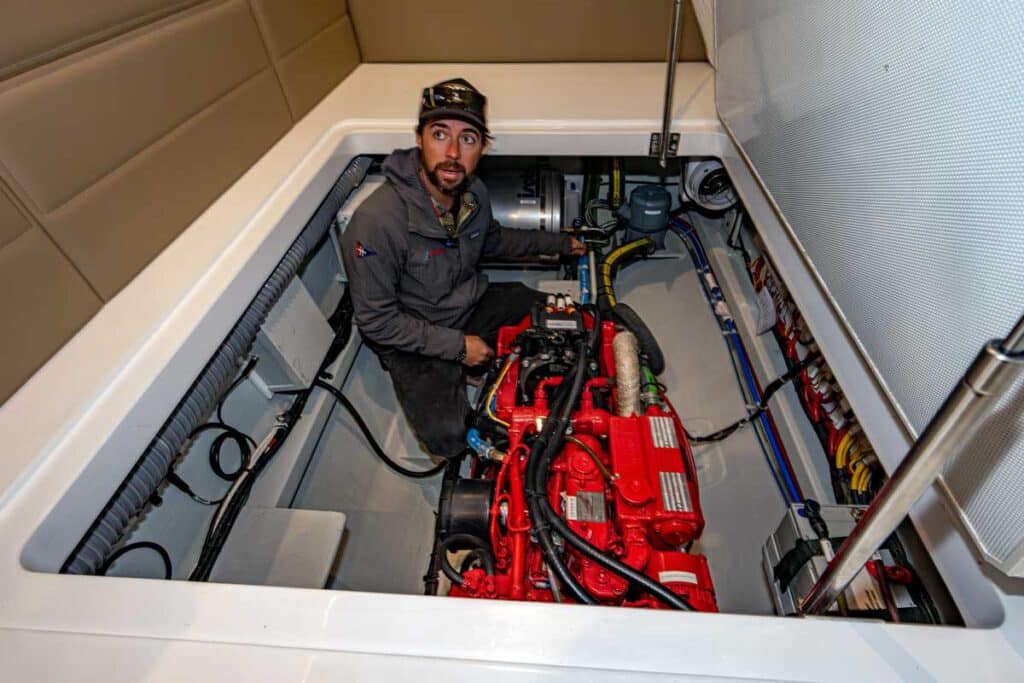
Stewart, a naval architect himself, also appreciated the boat’s modern styling and “sexy-looking profile,” especially the uncluttered interior. “It’s a nice departure from other similar-size catamarans,” he says. “I like the styling—it caught my eye the very first time I saw the rendering. The transom angle and the reverse bow give it nice aesthetics and the buoyancy you need. The curved boards worked well and are integrated nicely on with the boat. Overall, it’s a great-looking package, and it would be a lot of fun to do some races on.”
“We will definitely end up racing in the Caribbean and doing some fun events for owners,” Bailet says. “The cool thing about this boat is you can take a smaller crew of friends and race competitively, and it isn’t going to cost you $50,000 in paid crew and housing. You can race this boat with three or four people, no problem. Doublehandling is pretty easy too, but if you really wanted to go banging around the buoys, with this boat it would be easy.”
- More: 2024 Boat of the Year , HH Catamarans , Print January 2024 , Sailboats
- More Sailboats

Sporty and Simple is the ClubSwan 28

Nautor Swan Has A New Pocket Rocket

Pogo Launches its Latest Coastal Rocket

A Deeper Dive Into the Storm 18

Mistakes And Misfires On the Final Day of Cup’s Preliminary Regatta

Emirates Team New Zealand Remain the Bullies of Barcelona

Start-Box Sparring in Barcelona on Day 2 of Preliminary Regatta

Real-time Wind Overlay Feature Added to Cup Broadcast

- Digital Edition
- Customer Service
- Privacy Policy
- Terms of Use
- Cruising World
- Sailing World
- Salt Water Sportsman
- Sport Fishing
- Wakeboarding
Yachting World
- Digital Edition

First look: HH44 – smallest offering yet
- Toby Hodges
- September 5, 2023
Big solar capacity, fixed keels or daggerboards, protected helms and drop down transom platforms are just some of the key feature that make the HH44 stand out

Product Overview
The old adage that the many benefits of a cruising catamaran are achieved at the cost of its sailing qualities is no longer true and a growing proportion of buyers are seeking performance boats that are responsive and fun to sail. This part of the multihull market has of course existed for a long time, with the likes of Outremer, Catana and more recently Gunboat and Marsaudon Composites proving that lightweight ultra-fast catamarans can be safe and comfortable, yet also exhilarating.
HH Catamarans has grown rapidly since the yard was founded in 2012 by entrepreneur and boating enthusiast Hudson Wang. He has since ploughed some US$50 million into the company, including 1.2 million square feet of manufacturing space with state of the art production equipment, predominately at Xiamen in south-western China.
Wang has also recruited top talent, including Kiwi boatbuilder Paul Hakes, who as CEO has brought his knowledge of building very high end raceboats to a cruising audience who want an equal level of attention to detail in an impeccably finished yacht that also offers a high level of comfort and without sacrificing speed.
The latest model to hit the water, the HH44, will be the smallest in the range and therefore available to a wider audience, even if the price tag still ranges upwards of US$1 million ex VAT. Nevertheless this hasn’t deterred 35 owners ordering boats off-plan before the first one left the yard.
This Morrelli & Melvin design is not as ultra high performance as some of the earlier and larger HH models. This is especially true in the OC (Ocean Cruising) versions of the HH44, which have an easily handled format with aluminium mast, white gelcoat finish and mini-keels as standard instead of daggerboards. Nevertheless displacement is one third lower than that of many catamarans of this size, which promises enjoyable and rewarding sailing, as well as markedly reducing time spent under power when passagemaking.
SC (Sports Cruising) models include current race boat technology, including carbon C-foils and rig, a painted hull finish, plus over 4kW of solar panels.
They also have a parallel hybrid EcoDrive system developed by Isle of Wight company Hybrid Marine. This is intended to provide all the key benefits of an electric boat – including silent, fume-free motoring, instant torque when manoeuvring, and hydro-regeneration while sailing – without sacrificing the reassuring backup of diesel engines.
The first boat, an SC model painted in a striking metallic silver, was scheduled to hit the water this summer. Demand has been such that HH is currently building an additional set of moulds and two production lines will run for the HH44 at its Cebu facility in the Philippines.
HH44 specifications
LOA (transoms raised): 14.23m / 46ft 8in LWL: 13.28m / 43ft 7in Beam: 7.15m / 23ft 6in Draught (fixed keels): 1.52m / 5ft 0in Displacement (OC model): 8,750kg / 19,290lb Payload approx: 4,750kg / 10,000lb Mainsail: 74.2m2 / 799ft2 Solent jib: 51.1m2 / 550ft2 Base price 44-OC: US$957,000 ex vat Base price 44-SC: US$1,325,000 ex VAT Builder: hhcatamarans.com
If you enjoyed this….
Yachting World is the world’s leading magazine for bluewater cruisers and offshore sailors. Every month we have inspirational adventures and practical features to help you realise your sailing dreams. Build your knowledge with a subscription delivered to your door. See our latest offers and save at least 30% off the cover price.
You are using an outdated browser. Please upgrade your browser to improve your experience.
- Sailing Blogs
- List Your Catamaran For Charter
- List Your Catamaran For Sale
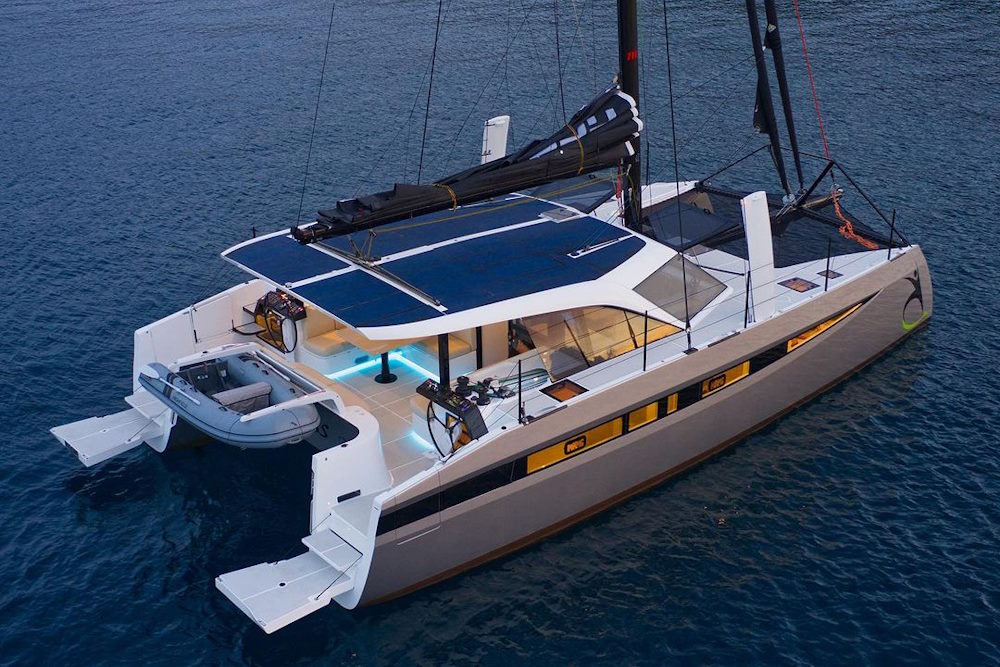
The first HH44 was launched in 2023 and premiered at the Cannes International Yachting Festival. This innovative design is the “baby” of the HH Catamarans range and has some interesting features such as her closed transoms, swing aft helms and a side boarding gate aft.
She’s a very pretty cat and will turn heads in the marina. This is HH’s first hybrid electric-powered catamaran although you can also opt for standard diesel power with shaft drives.
There are 2 versions, like much of the HH range. The Sports Cruising model: HH44-SC and the Ocean Cruising model: HH44-OC. The SC version is a “no-compromise-boat” with C-shaped carbon daggerboards, a carbon rig, a painted hull finish and 4,232 watts of solar with EcoDrive.
The OC saves you some money with the same hull, interior fit and finish quality as the sportier SC but with an aluminium mast, e-glass longeron, white gelcoat finish and mini-keels as standard.
Many of the ideas on this boat have been driven by a desire to maximise solar generation. There are 4,232W of peak solar on the cabin top alone with an option for more on the davits.
To maximise the solar, they have positioned the helms aft in a traditional sporty set-up. That way, there’s plenty of surface area up top to load on solar.
To help you stay protected in weather, these swing inboard, under the long coach-roof.
There are foldaway seats that tuck into the sides allowing you to either steer the boat from an outboard position with the wind in your hair and your sails’ tell-tales in full view.
Or swing the helms inboard and steer from the protected three-seat sofa on the aft beam.
To make it easy to board the boat in the marina, there is a side gate aft for when you come in along the dock.
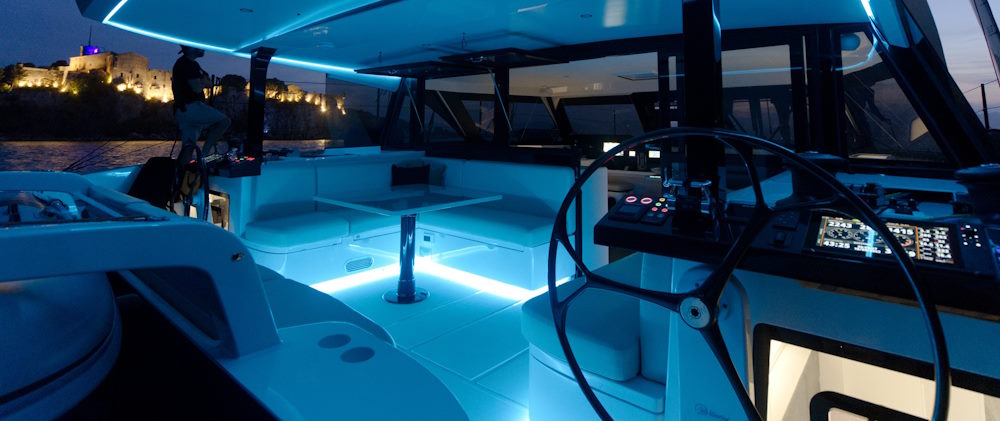
The HH44 has been designed to sail. The whole idea behind this catamaran is to get sailing in light winds (you should match wind speed on a beam reach) and to maximise your SOG over a wide range of conditions.
So she has a self-tacking staysail, a solent, a fractional reacher and a furling gennaker. The boom is very low over the coach-roof which keeps the centre of effort from the mainsail low.
There is a traveller aft on the coach-roof to manage your mainsail shape. The HH44 points well into the wind (45 TWA) thanks to her C-shaped daggerboards which provide a bit of lift at speed.
All the lines come back to the helm, so she is set up for short-handed sailing.
- Light, rigid and fast, the HH44 is a great sailor
- Swing aft helms give you flexibility while opening up the living space in the aft cockpit
- The finish on this boat is excellent
- Those closed transoms create a safe enclosed living space. They’ll also save you money in the marina
- A great looking boat that should hold her value well in the market due to the high demand
- The EcoDrive strikes a great balance between electric motoring with back-up diesels for safety
- With those aft helms, visibility is reduced towards the opposite bow, although the sight lines through the salon windows is good.
- This is not a cheap yacht
- The forward cabin is cosy. There is an option for a Pullman berth here (or convert to a workspace)
- The bow lockers seem small, although they are deep
Light Construction
Carbon and epoxy have been used to build as strong and stiff a yacht as possible while minimising the weight.
All of the lines run under the decks, so you have clear walkways around the boat. Stanchions are 900mm tall and a continuous, unbroken toe rail runs the length of the deck with all hull and deck joints fused and hidden.
Living Space
Moving inside, you’ll notice that the aft cockpit and salon forms one fully protected space with a large sofa on the aft beam and her closed transoms make this a safe family boat.
The angular cabin has two large, forward-facing windows that open fully from the the generously sized (187 sq ft or 17.4m2) salon. The standing height is over 2m (6’6”) high throughout.
One of the things that sets the HH44 apart from her competition is the quality of the finish on this semi-custom yacht. She has foam core furniture and exceptional joinery throughout, and Bosch electric appliances as standard.
There are two options for a BBQ, one which replaces the aft sofa with a large LPG BBQ & Dive Tank station or you can mount an LPG Grill in the aft fishing rod holder, keeping the aft sofa. There is an outlet on the aft beam so you can run an electric BBQ.
In the salon, there is an L-shaped sofa with a table forward to starboard and a large nav station/workstation to port.
Tuck yourself into the U-shaped galley behind the nav station or pull out some cold ones from the fridge on the starboard side. The ventilation at anchor is excellent with those huge forward windows.
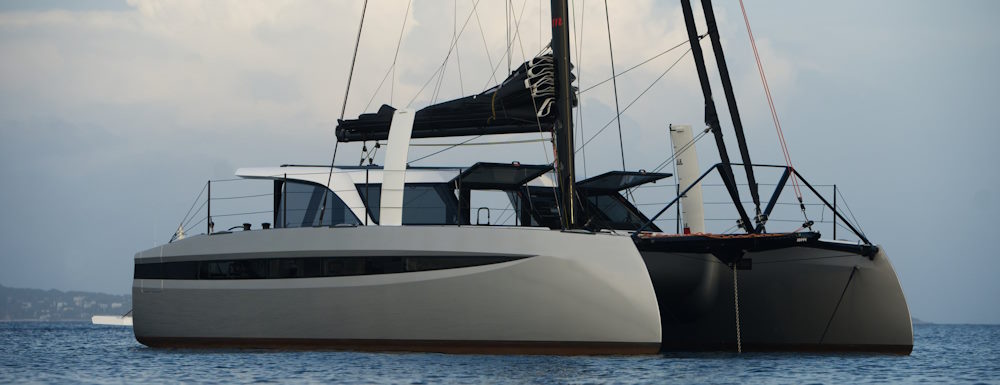
The starboard hull is the owner’s side and consists of the master cabin aft and a walk-in shower and head forward. The finish has an Italian feel to it and it is very light down here with a large window aft in the owner’s cabin.
This is a 44 foot performance cat, so there is not as much room down her as you’d find in a cruising cat, but she has ample space in the aft cabin and the storage is well organised.
HH offers three different forward cabin combinations. One is the standard layout with a single berth.
The second has a Pullman berth above the standard bed that folds away when not needed.
A third option does away with the beds and replaces them with a large work bench with shelves (for pantry storage or tools) and an extra Fridge/Freezer unit.
If you go for the option with the EcoDrive, the House Bank is powerful enough to run the A/C overnight without the need to run a generator. There is enough power to run the A/C in the master cabin for over three days.
EcoDrive, her Electric/Diesel Parallel Hybrid System The HH44 was designed from scratch to work with a parallel electric/diesel hybrid, with a minimum of 4,232W of peak solar array on the cabin top and hydro-regeneration while sailing.
EcoDrive gives you silent fume-free motoring at 7.5kts, fast torque for manoeuvring, and hydro-regeneration while sailing. Plus you have parallel, trusty diesel engines for safety.
A diesel engine is paired with a large electric motor, much like an alternator sits on a traditional diesel engine. A belt links the two units and a camshaft allows you to flip between the two power systems, giving you good redundancy. And remember, you have 2 of these systems on board!
The system is designed to offer from 1.5 to 3 hours of electric propulsion: more than enough time to exit the marina or anchorage and hoist the sails.
This boat has been designed to get sailing in light winds which ultimately is the key to an eco-friendly sailing yacht. And you will be recharging your batteries as you sail.
You can also fit the HH44 with traditional standalone diesel engines with shaft drives.
The HH44 is an innovative design that will appeal to sailors setting out across long distances who want to sail more and beat well to windward when needed. This yacht is in a different price league to something like an Aventura 37 of course, but there are two options here: the Sports Cruising and the Ocean Cruising models.
She’s a comfortable boat, although there is a trade-off on space down below particularly in the forward cabins.
With the EcoDrive option and a bow locker full of sails, you’ll be able to minimise your diesel usage on this boat while crossing oceans safely and quickly.
What is the price of an HH44? How much do they cost? The sportier HH44-SC starts at $1,325,000. Meanwhile the HH44-OC version starts at $957,000 USD. The total cost will vary depending on your options, but you should budget an additional $300k, perhaps more for the SC.
How much solar is there on the HH44? The HH44 has a generous 4,232W of peak solar as standard on the SC on the cabin top. You can fit 1,200W watts over the Davits, but this comes with a weight penalty.
What is the length of the boat with transoms up? With the transoms up, the LOA from davits to Bow Sprit is 14.23m (46.68 feet), so fine for a 15m berth.
What size tender can you carry? The optimum sized tender is 3-3.5m (10-11 foot). The davits are carbon fibre and will soak up a high load.
Technical Specification
| D/L | 111.5 |
|---|---|
| Mainsail | 72.4m2 / 779sqft. |
| SA/D | 26.3 |
| Power | 2 x 30HP+10kW hybrid |
| Draft (Boards up) | 0.7m / 2.5' |
| Beam | 7.15m / 23.46' |
| Solent | 44.1m2 / 475sqft |
| Gennaker | 148.9m2 / 1603sqft |
| Staysail | 23.9m2 / 257sqft |
| Bridgedeck | 825mm / 2.7' |
| SA/D* | 26.3 |
| Displ. Light | 10.2 T / 22,487 lbs |
| Reacher | 84.8m2 / 913sqft |
| Disp. Max | 14.5 T / 31,967 lbs |
| LOA | 15.31m / 50.2' |
| LWL | 13.37m / 43.86 |
| Draft Boards Dn | 3m / 9.84' |
Contact Katamarans
Share your details with us and we’ll be in touch to discuss further.
" * " indicates required fields
- Privacy Overview
- Strictly Necessary Cookies
- Cookie Policy
This website uses cookies so that we can provide you with the best user experience possible. Cookie information is stored in your browser and performs functions such as recognising you when you return to our website and helping our team to understand which sections of the website you find most interesting and useful.
Strictly Necessary Cookie should be enabled at all times so that we can save your preferences for cookie settings.
If you disable this cookie, we will not be able to save your preferences. This means that every time you visit this website you will need to enable or disable cookies again.
More information about our Cookie Policy
- BOAT OF THE YEAR
- Newsletters
- Sailboat Reviews
- Boating Safety
- Sails and Rigging
- Maintenance
- Sailing Totem
- Sailor & Galley
- Living Aboard
- Destinations
- Gear & Electronics
- Charter Resources
- Ultimate Boat Giveaway

Sailboat Review: HH Catamarans HH44
- By Herb McCormick
- June 26, 2024

There are many outstanding, even outrageous, things one can say about the HH44-SC catamaran. It’s the latest in a series of upscale boats conceived by HH CEO Paul Hakes, with structural engineering by the naval-architecture duo of Melvin & Morrelli and built in China by the Hudson Wang manufacturing conglomerate, which sold more than three dozen hulls on drawings and renderings alone, before a single boat was built. The waiting list is now about two years long.
I’m no math whiz, but with the boat’s sticker price, all up, of over $1.6 million, it’s safe to say that HH Catamarans had something like $50 million of orders on the books in advance of a sole customer actually pushing the button on an electric winch to raise the hefty, full-battened mainsail. Which leads to a pretty simple question: Who are those guys?
In an interview I conducted with Morrelli several years ago, he spoke about the sort of buyer drawn to the HH brand: “It’s unbelievable to me the percentage of newbie owners we attract to HH. More than 50 percent are first-time boat owners, guys who are buying $2 million and $3 million boats. I find that a bit shocking, but they were successful at something at some point in their life, and they’re trying to roll that success and confidence into something else.”
Allow me to take that one step further, because I’ve met a few HH owners, and I believe that the boat is catnip to a certain type of tech-savvy consumer. They definitely find the boat’s clean lines and tantalizing performance sleek and sexy, but they also are passionately drawn to the forward-thinking technology itself. I’ve heard folks refer to certain products in the marine sector as something Elon Musk might’ve dreamed up, but the HH44 may in fact be the closest thing there is to a Tesla of sailboats. I’d bet dollars to doughnuts that more than a few HH owners have one of those parked in their driveway.
What, exactly, are those folks getting for their seven figures? There are two versions of the boat: the HH44-OC (Ocean Cruising), a dedicated bluewater cruising cat with mini keels instead of daggerboards; and the HH44-SC (Sports Cruising), a no-holds-barred rocket ship with C-shaped carbon boards, a solar array, and the company’s EcoDrive auxiliary propulsion package, which we’ll delve into shortly. The SC is the model we tested for the 2024 Boat of the Year contest. Spoiler alert: We were fairly blown away by the boat, and honored it with a Judges Special Recognition Award . Our sister publication, the performance-oriented Sailing World , named it overall Boat of the Year and described it as “the performance sailor’s retirement race boat.”

Aesthetically, in theme and execution, the HH44-SC presents a futuristic appearance. There’s a fixed bowsprit forward; ample freeboard in the relatively narrow hulls (at least compared with your average cruising cat from mainstream builders); a slash of integrated hull windows that offer natural light in the staterooms and double as a nice visual accent; a pair of drop-down swim platforms in the transoms; and a set of dinghy davits in between. The coachroof extends well aft and doubles as a hardtop Bimini over the cockpit, while serving as the base for the traveler and mainsheet arrangement, and as the base for more than 4,000 watts of mounted solar panels.
Quick aside: The hulls are painted, and I reckon that more than a few owners will go with colors not usually found in genteel yacht surroundings. Our test boat, Titan , the first HH44-SC off the line, is bound for the Caribbean with a magnificent bright-red exterior. The intent is clear: You can go garishly or go home.
Forward-facing windows in the main cabin can be opened to allow the fresh breeze to course through. M&M employed forward cockpits for steering and sailhandling in many of their previous designs, but eschewed that layout here. Instead, there’s a set of Jefa helm stations well aft that can rotate outboard for increased visibility when driving upwind, or that can be tilted inboard under the Bimini top in inclement conditions or to access line handling by gaining proximity to the winches. It’s a versatile, well-reasoned solution that I like a lot. I wish more cats were laid out similarly.
Below, a dedicated en suite owner’s stateroom runs the length of the starboard hull. A pair of double-berth staterooms to port share a central head and shower.
So, that serves as the basic overview of the 44-footer. But what about the technology? The big stories there are the propulsion and construction.
The most eye-opening feature is the hybrid auxiliary setup. Boat of the Year judge Tim Murphy is the educational director for the American Boat and Yacht Council and our go-to expert for all technical matters. Here’s his take on the system developed by UK firm Hybrid Marine: “It had the most sophisticated house systems and propulsion we’ve seen in the contest, starting with their parallel hybrid drive, a system unlike any we’ve inspected on any boat before this one.”
Electric motors are built onto the back of the twin 30 hp Beta Marine diesels (or optional Yanmar 40 hp engines) with a coupling to the transmission. The electric motors can effectively be used as a pair of 5 kW generators to charge the battery bank. Adding regeneration while sailing provides up to 2 kW per shaft at 10 knots of boatspeed. An additional 43 kWh of energy is produced by the solar array on the cabin top.

What this translates to is silent operation under power in full electric mode, augmented by hydrogeneration to top off batteries while sailing, with the good old-fashioned reliability of those diesel engines as a backup, or for motoring through high pressure on passages.
It’s a boat that covers a lot of bases, though Murphy is also quick to note that it will be interesting to see how all this translates to real-world operations, given that it’s new tech. He wouldn’t be surprised if, at the outset, there are growing pains bringing it all online (though company representatives note that the system has been used in European canal boats for more than 10 years).
HH president Seth Hynes says: “At full battery capacity, you can run the boat at full throttle using the two 10-kilowatt electric motors and get 7 knots of boatspeed for approximately two hours. In light air, you can even keep your leeward electric motor running to build yourself some apparent wind.”
Murphy is also impressed with the build quality: “It’s thermal-foam construction with panels of Corecell foam core that’s heated up to make the complex shapes of the hull with no slits or kerfs in between. So you’re using those flat sheets to construct complex curves, and then you’re using the best resin available—which is epoxy—in the laminate, which also employs carbon cloth. This is infused epoxy construction, post-cured after that fact, so they are very, very high-quality hulls.”
Carbon reinforcements are also used in high-load areas such as the wing deck, coachroof and daggerboard trunks. The Marstrom rig on the HH44-SC is all carbon (the OC version has a standard aluminum mast with the option to upgrade).
At the end of the day, the reason one is attracted to a light, fast cat is pretty simple: performance. HH has been well-represented in previous Boat of the Year competitions, with its HH66, HH55 and HH50 all previous nominees (the latter two won awards in 2018 and 2021, respectively). To be honest, I’ve always been startled by the fact that many of these cats have gone to first-time boat owners with varying degrees of experience. I’ve been sailing for decades, and I’d be fairly intimidated to head offshore with a shorthanded crew on the larger HH cats, which are not simple vessels, but rather extremely powerful boats where things can escalate quickly if the first domino falls.
One doesn’t need to be Superman, however, to sail the scaled-down HH44. Our test boat arrived in Annapolis, Maryland, with only a set of basic working sails (main, self-tacking staysail), so we didn’t get the full-on, off-wind power-reaching sleigh ride that is essentially the boat’s reason for being, but the sailing was still fast and sprightly. (A hat tip to the HH commissioning team, who had the boat sailing just two days after it was offloaded from a freighter in New Jersey.) Closehauled, with the deep, nearly 10-foot boards deployed, the boat tracked like a train and quite easily flirted with 10 knots of boatspeed. I can only imagine what it would be like to set a kite, then turn and burn, but it’s safe to say that you’ll regularly be registering double-digit boatspeeds. HH reps say that our test boat hit 23 knots on the delivery south to the Caribbean.
All in all, the HH44-SC is quite a machine to behold. The story of production-boat building, starting way back in the 1960s, has been an ongoing evolution—piece by piece, boat by boat. Now this very cool cat has penned its own chapter. There’s really nothing else like it.
Herb McCormick is a CW editor-at-large and was a 2024 Boat of the Year judge.
The “HH” in HH Catamarans represents the initials of Chinese businessman and manufacturer Hudson Wang, who founded the company, and CEO Paul Hakes, a New Zealand boatbuilder who joined forces with Wang in 2012 to launch the brand. There are currently eight models in the HH lineup, ranging in size from 44 feet to 88 feet, including the HH50, which was named the Best Luxury Cruiser in the 2021 Boat of the Year contest . The HH Catamarans design team of Melvin & Morrelli is well-known for their America’s Cup contenders, maxi offshore cats such as the 125-foot PlayStation , the pioneering Gunboat cruising cats, and the current line of Rapido performance trimarans.
- More: catamaran , hh catamarans , performance cruiser , Print July 2024 , Sailboat Reviews , Sailboats
- More Sailboats

Sailboat Preview: Elan GT6 Explorer

For Sale: 1984 Camper & Nicholsons 58

Alubat Updates OVNI Models

For Sale: Little Harbor 63 Ketch

From Paradise to Medical Emergency: A Bahamas Nightmare Turns Lesson Learned

Free Medical Advice: The Unwarranted, Unprofessional Edition

Gatekeepers of the Waterway

Rigging Redo: Our Switch to Synthetic
- Digital Edition
- Customer Service
- Privacy Policy
- Terms of Use
- Email Newsletters
- Cruising World
- Sailing World
- Salt Water Sportsman
- Sport Fishing
- Wakeboarding

HH44 Catamaran: The sailing TIE-Fighter
- April 19th, 2024
- Sailing Yacht
Safe the best for last, as they say, right? And as such I´d like to write my final article from this year´s La Grande Motte Multihull show about a very special catamaran. HH Catamarans is neither a newcomer on the boating market – actually, the company was founded some 12 years ago by the renowned boatbuilders Mr. Hudson and Mr. Hakes – hence the name “HH” Catamarans. Nor is their no-compromise approach new.
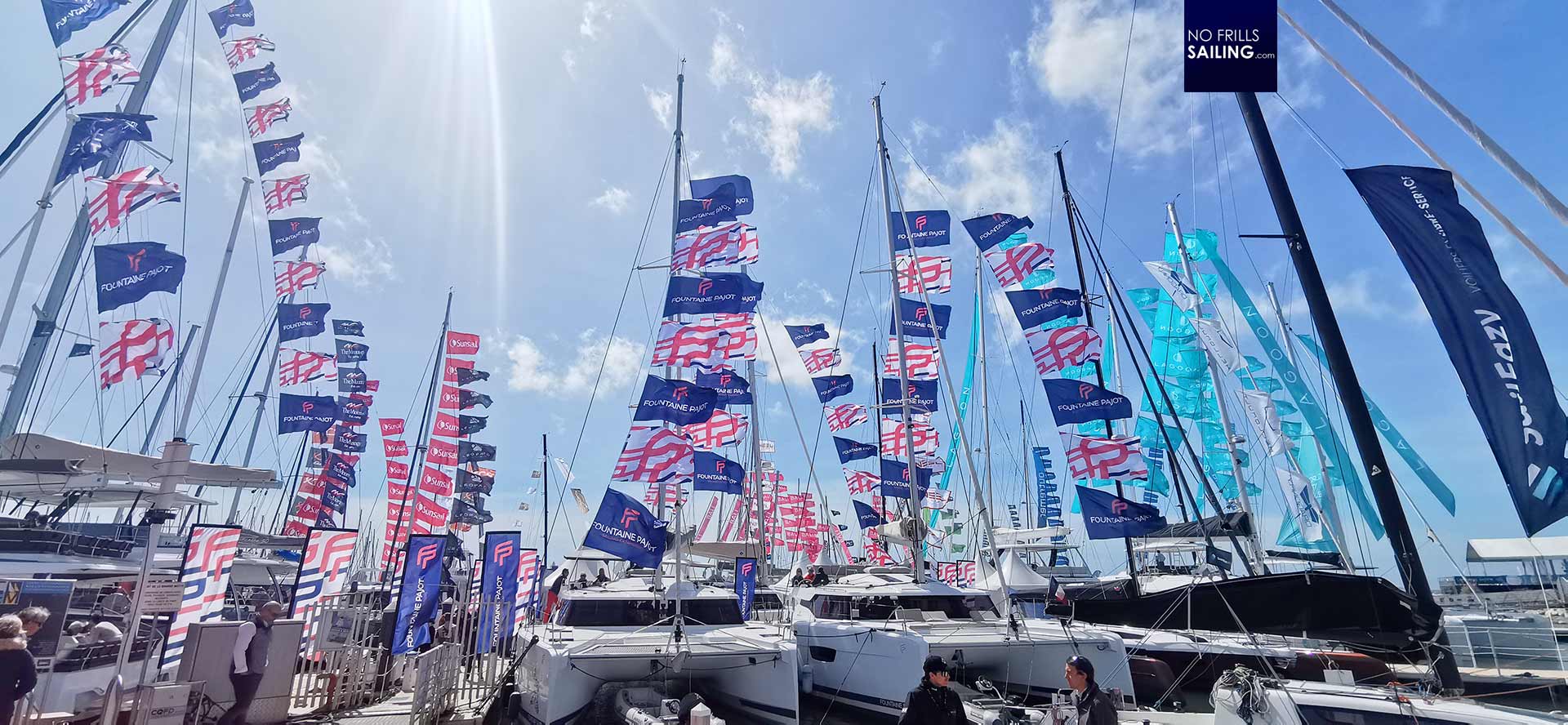
Honestly, I´ve seen them around but never really approached this brand or boat. Maybe that is because “HH” is an awkward name to speak, but surely because I did not really know what HH Catamarans was all about and frankly, what an awesome build their boats really are! In this, join me for a really cool walkthrough in a yacht that sets the bar a bit higher. Quite a bit!
Emerging Player: HH Catamarans
First things first: Yes, these are boats which are built in China. But, like with so many other things, it is not the origin of a product that is deciding but the briefing and budget given to the makers. In terms of HH Catamarans, the company has set up a state-of-the-art production plant in Xiamen that is owned and run by the company (not a rented production facility!). I haven´t been there but from what one can see online and by talking to the guys present at the HH Cats stand, this is the best from the best. Most advanced CNC , infusion and Carbon Fiber processing technology on the market. Cheap China? Not at all! This 44-footer comes with a plus one million price tag: An HH Catamaran is absolute top shelf luxury.
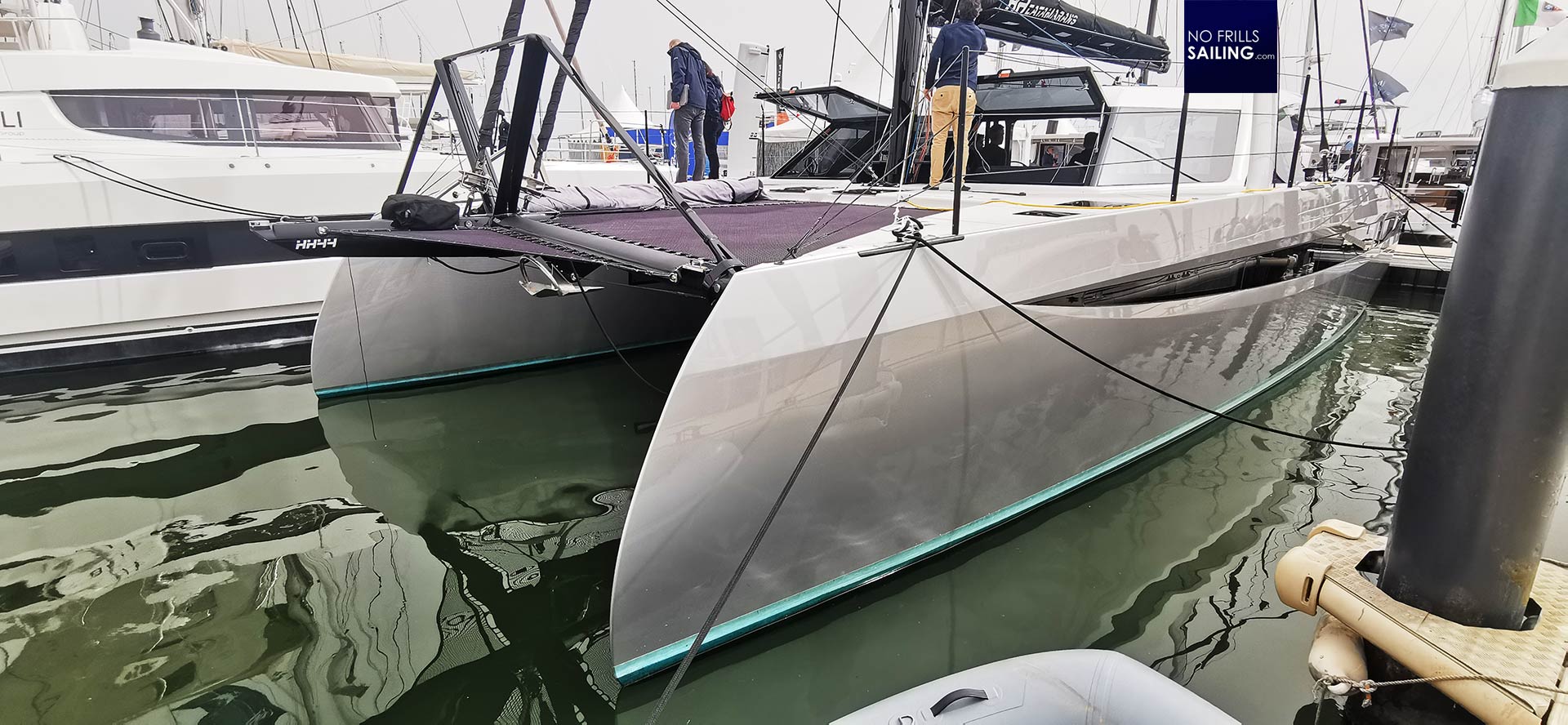
As apparently the stand and the catamaran was full the whole boat show, I walked by several times hoping for a calm spot to not being interfered with when taking pictures. Which was really hard. Even before opening and after closing times, the cat was full of people checking it out. Which is a good sign. And I can understand why it attracts so many people: Nearing myself from bow, the design and lines are really breathtaking!
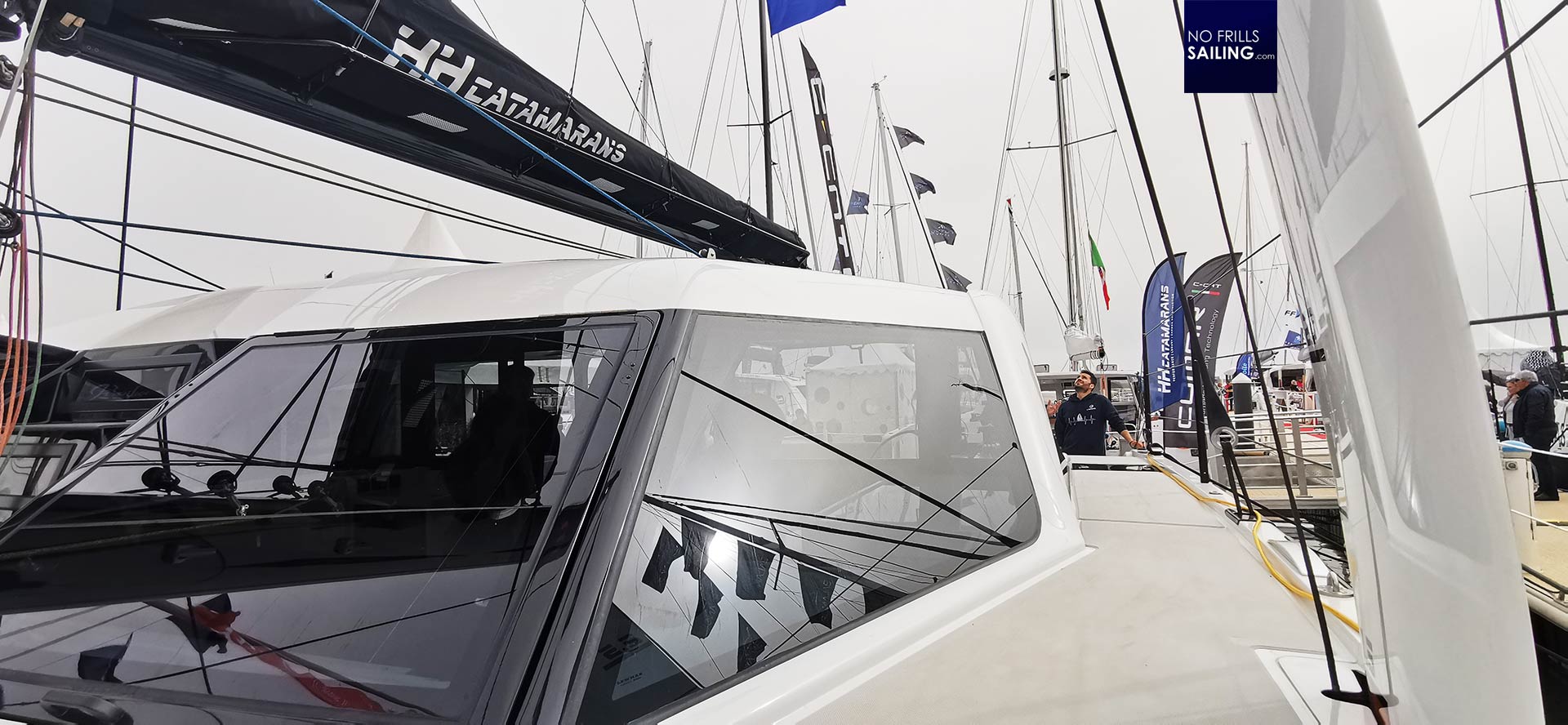
The extra-slim hulls and the negative stems make for a fine, slicing entry. The freeboard is very high and distance from the middle section to the waterline pleasantly high: A sign for a very seakind and fast catamaran. I liked the angled shapes very much, instantly I am reminded of the “Star Wars” starship design of the famous TIE-Fighters by the Empire – a daring look for sure. The high class paint of the hull sets it apart from the white deck-salon. A starship, ready to fly.

This enthusiasm changes a bit when I look from a stern angle at the boat. Again, I am reminded of another starship, this time Captain Jean-Luc Picard´s ENTERPRISE D, which looks awesome seen from some angles and doesn´t work anymore from others. The reason for this strange look of the HH 44 are the closed aft sections. The boat appears to have been sort of “cut off” or “sawn away” at the stern – but later more to this, because there is a not so stupid reason.
A hidden gem
Anyways, right on the last day of the “Multicoque 2024” it was my last chance to do the walkthrough and so I went over. Again, even for a traditionally lame last boat show Sunday, the yacht was full of people. So I thank all the guys who allowed me to have them on my pictures here, and so I started my tour.
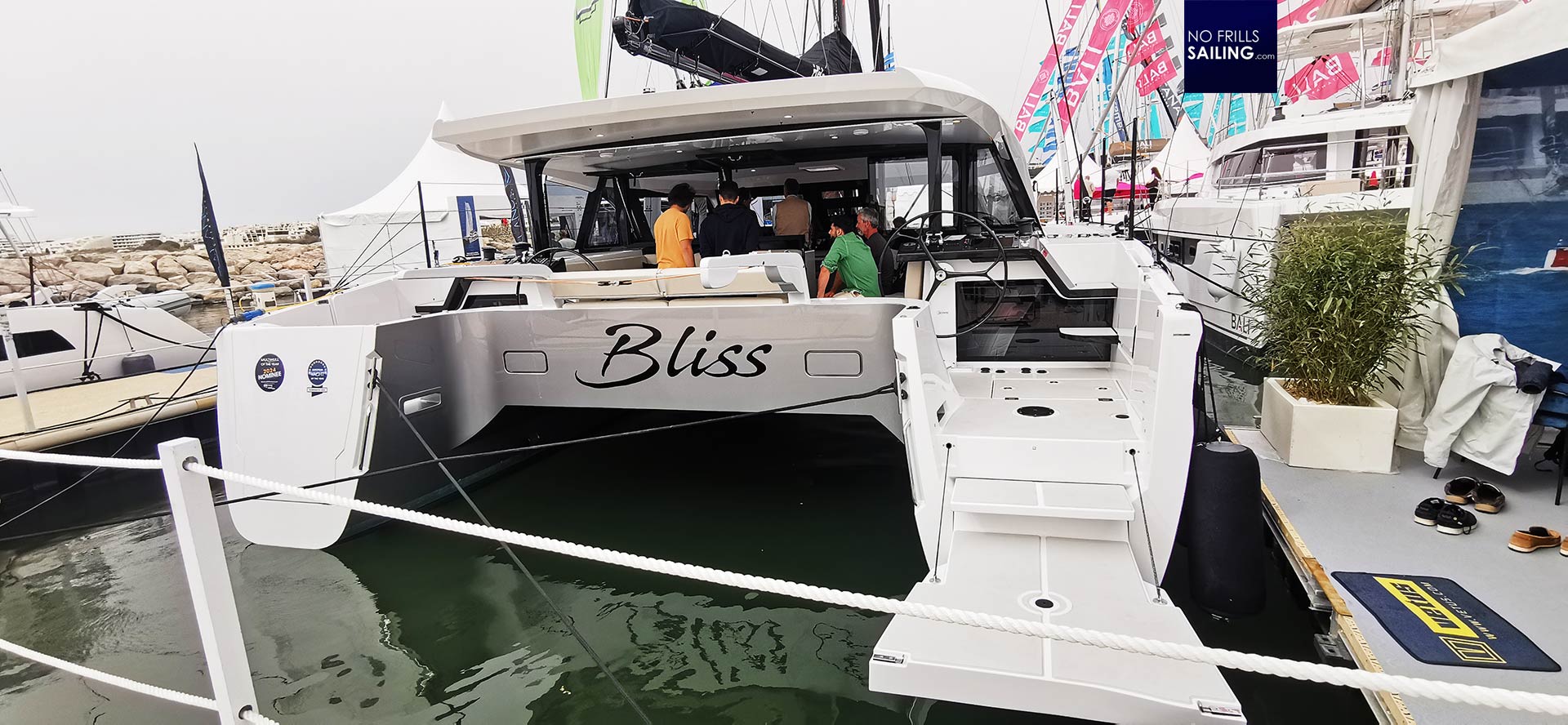
The HH 44 is the smallest entry level catamaran of the range. The shipyard offers a staggering palette of eight models, ranging from 44 over 50, 52, 60, 66, 80 and a huge 88 feet flybridge super-catamaran. The model shown at La Grande Motte was a used boat, so not brand new anymore, but there were no visible signs of wear. Also, the HH 44 is offered in two principal versions: A cruising catamaran and a high-performance cruiser with daggerboards as displayed at La Grande Motte. Setting my foot into the salon, I quickly realized that this is truly a hidden gem.
A starship for sure!
To stay a bit with the starship-theme, it doesn´t feel like being on a boat. Her design – lightweight sandwich and painted carbon structures – is kept in shiny gloss-white and hard black contrasts. Only a few other colors, like the LED-lighting or slightly crème-colored leather cushion derive from the black/white design. I like it, it really feels like being on a starship.
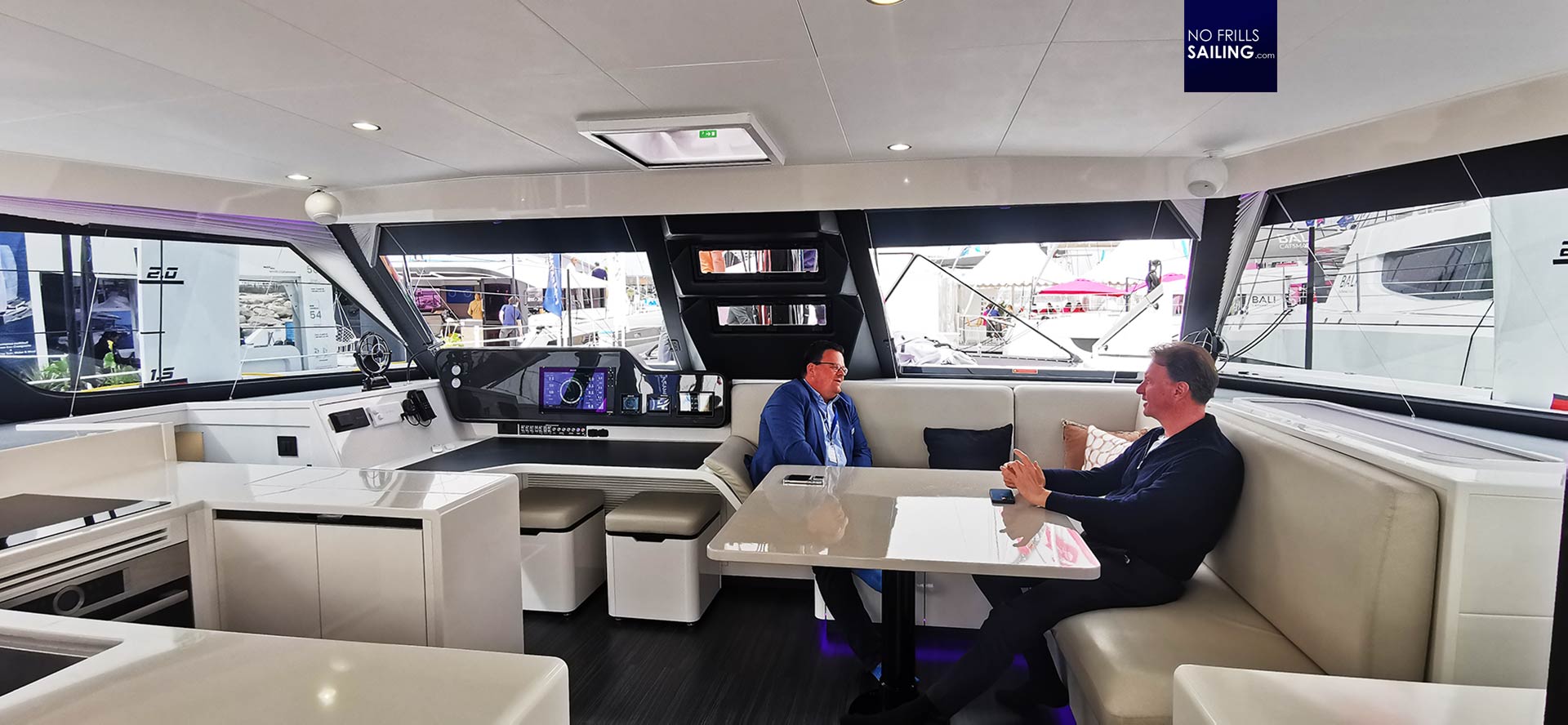
The salon offers a classy layout with a nice wide L-settee around a reasonably sized dinner table. The windows to the front, the sides and abaft are huge and offer a true 360-degree roundsight. Having a lightweight build utilizing the latest material for stiffness, there are literally no bigger solid walls, it really feels like as if the roof is hovering above the deck.
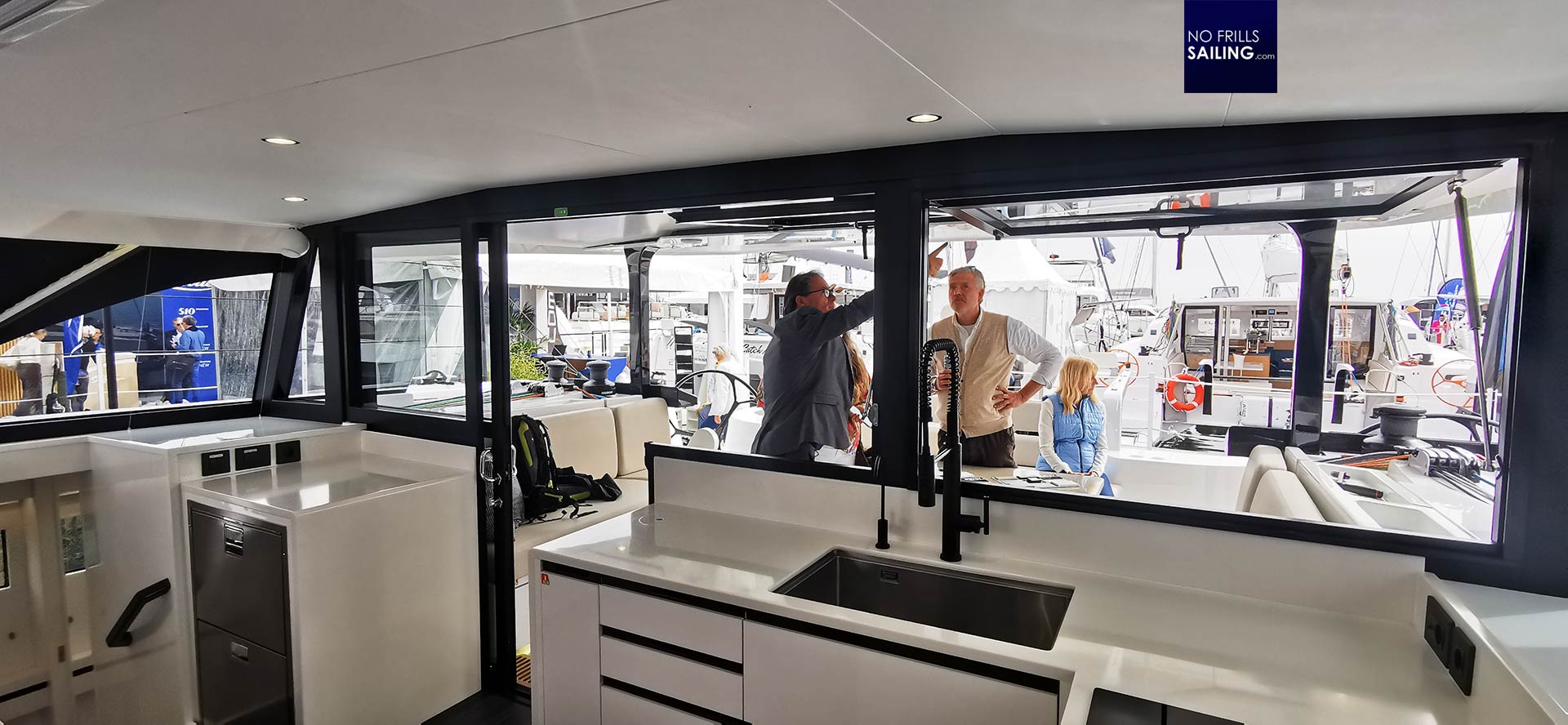
To make a connection from the “inside” to the “outside”, which is the large aft cockpit under a rigid roof, the large galley window can be folded up and secured under the roof, the sliding door is also removed. In this, a ship´s cook facing backwards will have most fun when providing a meal. Dishes and food can quickly be shuffled out or hauled back in after a meal. Right onto the worktop where a large single sink is located. That this catamaran is a different level indeed can be seen at some really nice details.
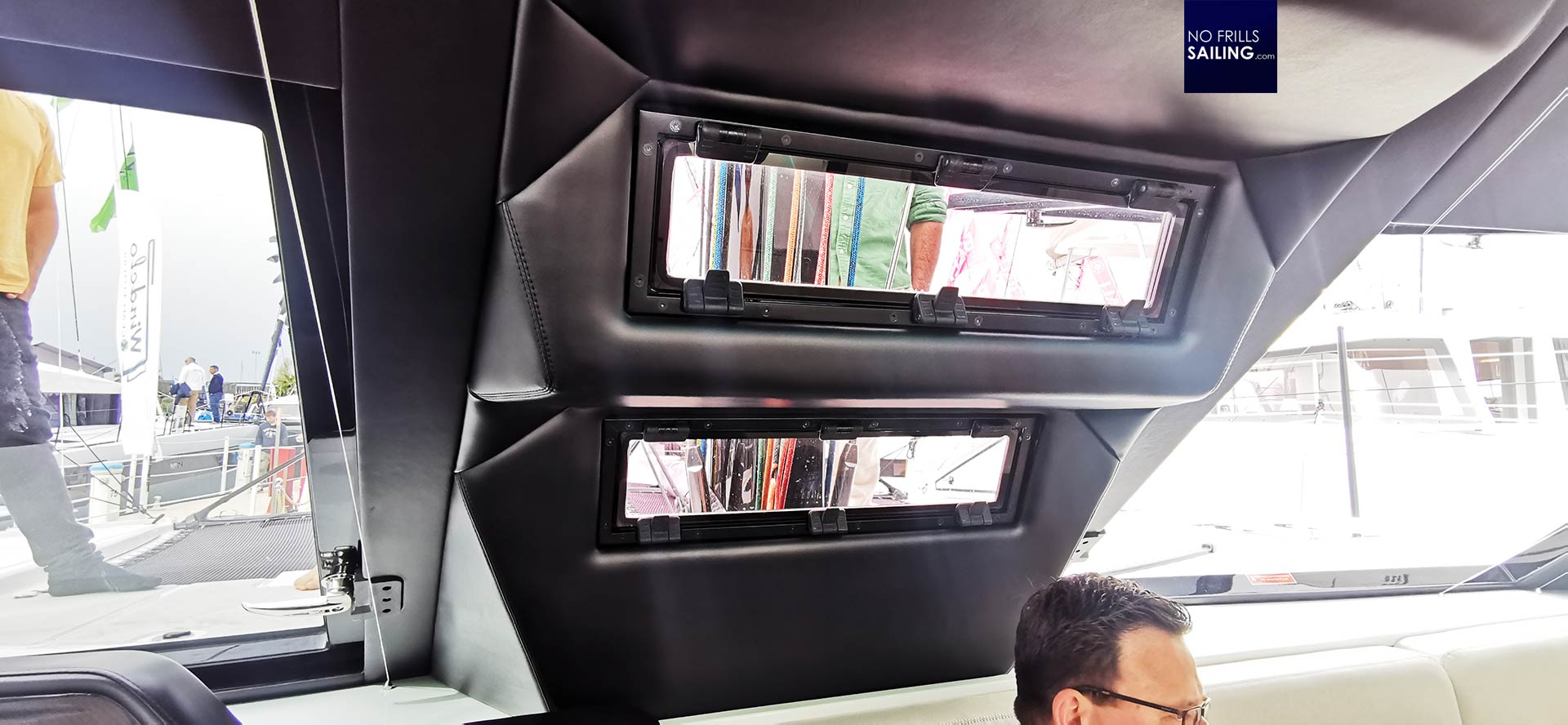
For example, the integrated steps to go onto the roof are – at the inside – nicely stitched and wrapped in padded leather. Wow! I absolutely loved how nicely the sunshades work which are made of up to three moving fans going seamlessly up and down. Everything is made of a nice, “heavy” quality – there are literally no cheap plastic clasps installed in the boat.
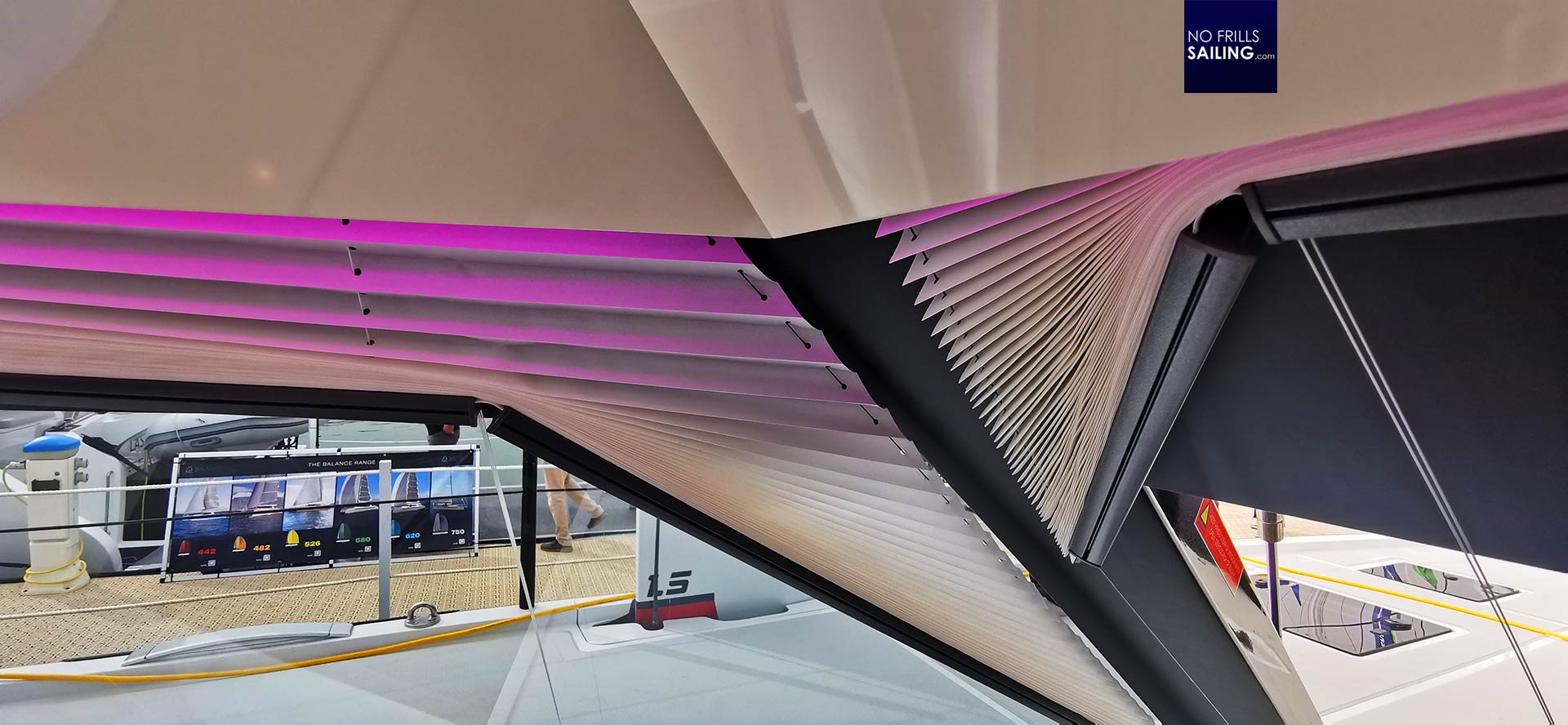
For a 44-footer, die salon made a great impression on me. The layout is classy and very practical. It holds also a fine balance between providing as much (free) space as possible and at the same time having a safe (less empty volume) room to roam about even in heavy seas violently moving the boat. Comparing the HH 44 salon to “our” Excess 14 , which has roughly the same measurements, this one has less room and feels more “filled”, but on the other hand, comes with a very cruising- and owners-sailed optimized layout.
Design meets practical solutions
Looking at some key features, the distinction between an owner-optimized and vacation-optimized boat becomes apparent. For example the nav-station. This is an indisputable feature in a cruising catamaran, but of course, for boats predominantly used as vocational ships which as well must work fine in charter business , a dedicated nav-station will be as small as possible. This is different from a catamaran or boat (same goes for monohulls) which are intended and thought-through for sailor and owners-couple usage.
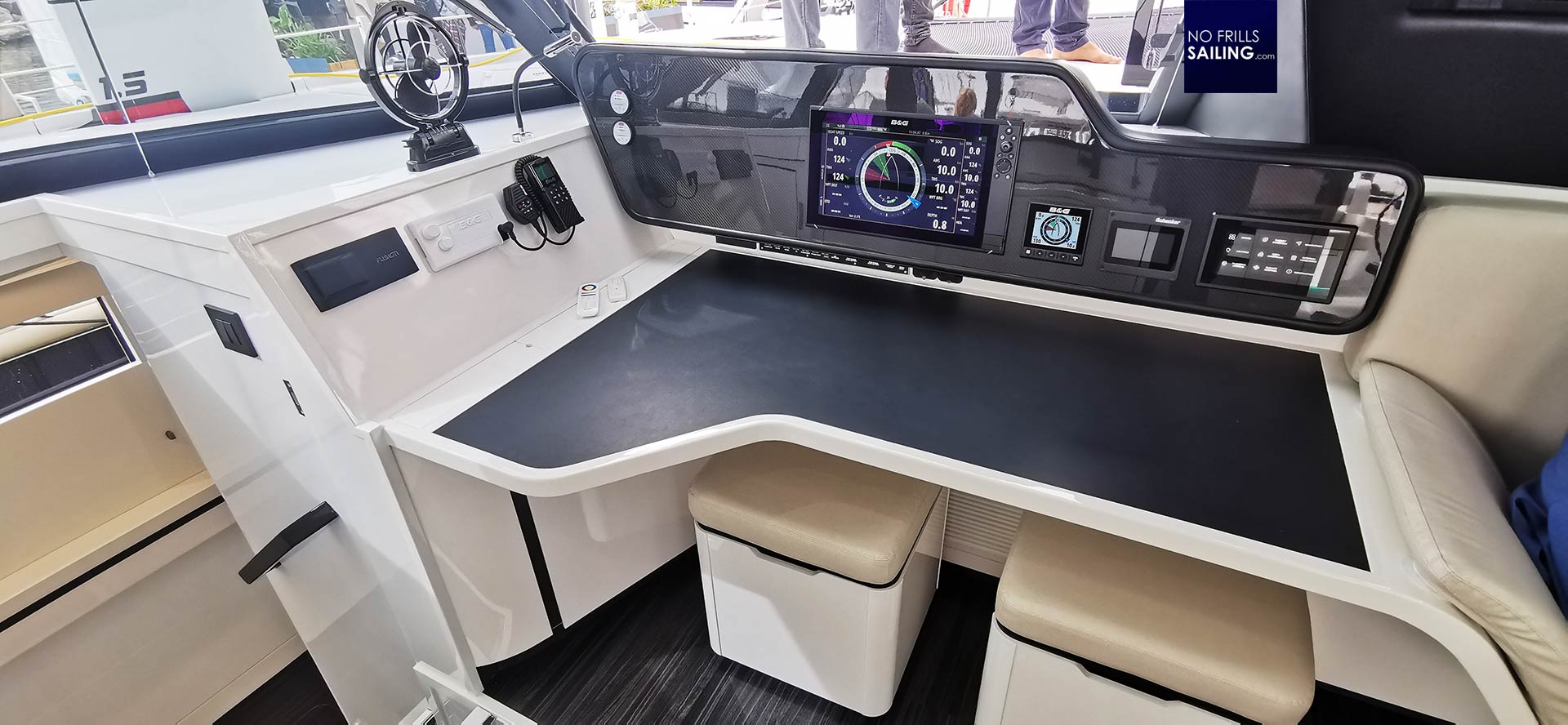
If you liked the huge role model nav station on the Outremer 52 , you will simply love the one on the HH 44! The desk is big enough so that two persons can take a seat on the lightweight, very practical poufs . I personally like the pivoting stool on the Outremer 52 more, but I´m sure the yard could fit something like this here as well. Also, all electronic displays and controls of the boat to be found outside are mounted as daughter displays in here. A fully operational control-bridge – best for a heavy weather watch!
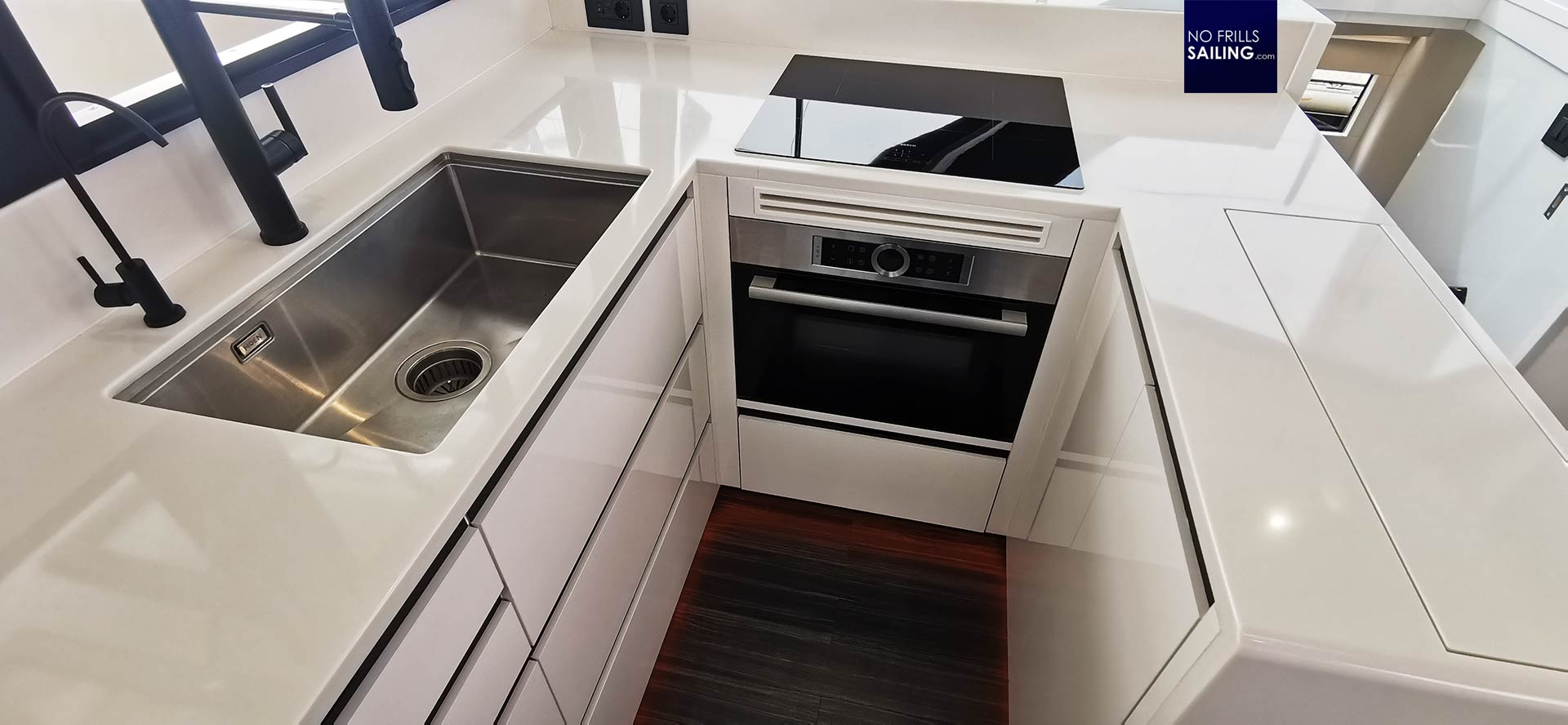
Another deciding detail – this time much, much better solved than on the (much bigger) Outremer 52 and many other catamarans I´ve seen is the galley. It´s a U-shape, which not just provides so much extra stowage, but also a safe standing position to prepare food or doing the dishes. A ship´s cook can wedge in here and there´s no danger of falling through an all-open salon.
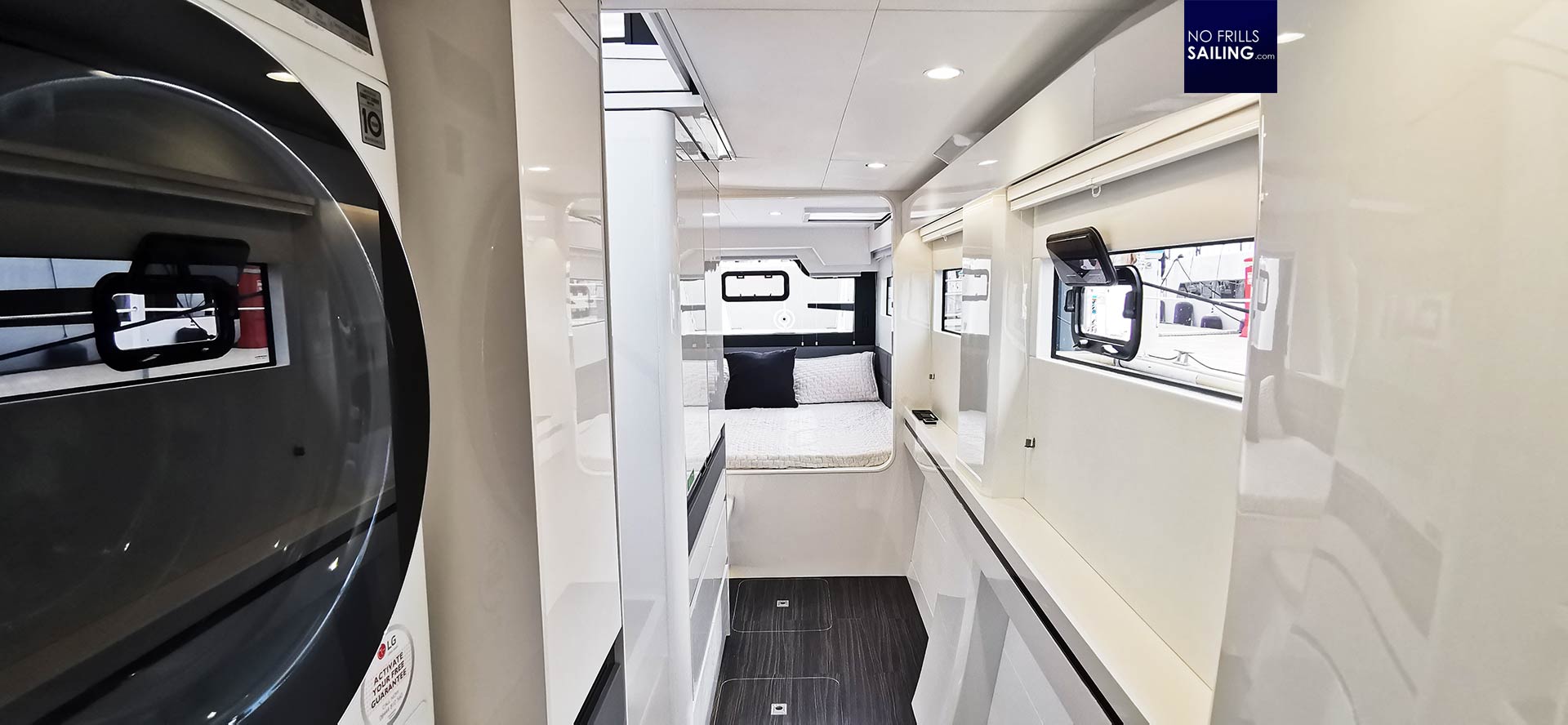
The boat is loaded with such amenities and practical solutions. The point is that you will never have the feeling that something has be done afterwards or as some sort of concession to some weird client´s requests, but it feels like the boat has been constructed around these things. Best seen where the large washing/drying machine is installed. They haven´t taken out a cabinet and just somehow fitted a washing machine, the whole area was planned to fit it. And to look nice, on top.
A Cathedral of light: Cabins aboard the HH 44
Let´s stay down below for a while because this is there the HH Catamaran really gets exciting. First of all, the black/white design in combination with huge and manifold windows and deck opening hatches makes for a wonderfully light suffused interior. There are windows literally everywhere you look – and a friendly light atmosphere. Many other boats are like “traps”, rather boosting seasickness than curing it.
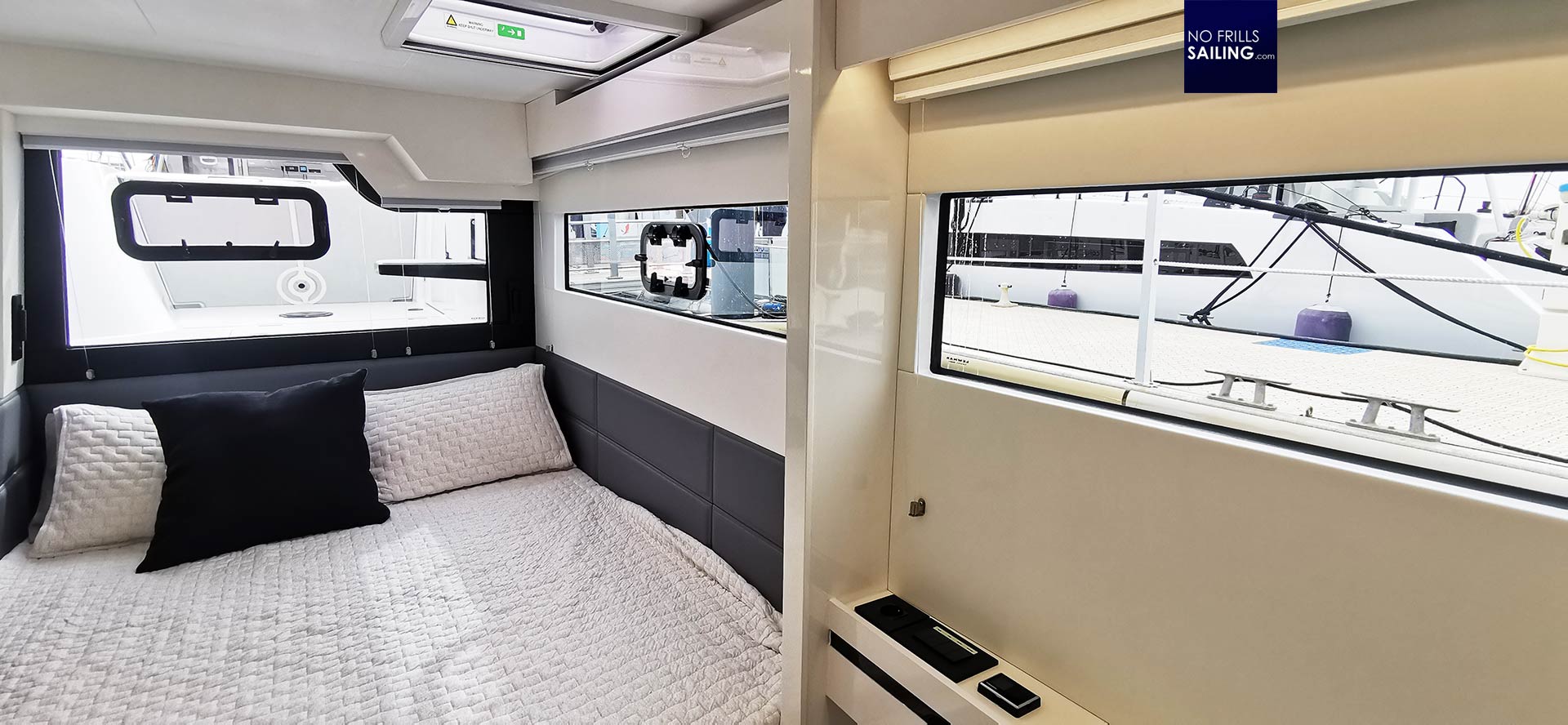
This light-concept is best understood when checking the aft sections of the hulls: Huge rectangular bed which utilized all of the area between the hulls´ walls instead of island beds (which in my opinion are nice to look at in a catalogue but are a waste of space and unsafe in heavy seas). But the best are the windows … just look at this:
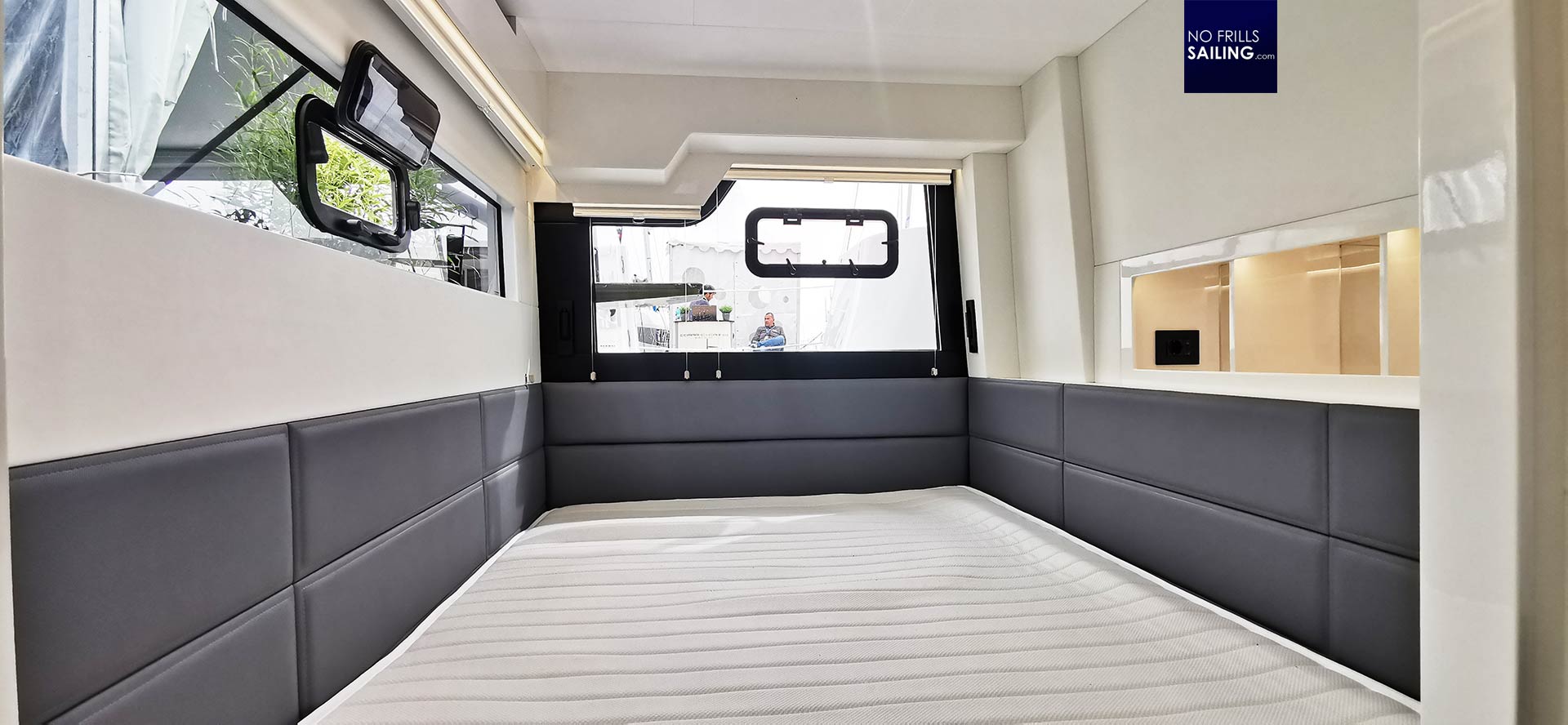
Owners and VIP-guests sleeping aft will enjoy a sunroom-like openness. I cannot remember having seen a boat´s cabin that offers such a huge amount of transparent area, being here whilst underway on the blue Ocean must be a tremendous experience. The only downside – as with so many boats – is that the hull windows are so high that you cannot look out whilst laying in bed. I guess that´s a safety issue, but it would have had an extra boosting comfort effect for sure.
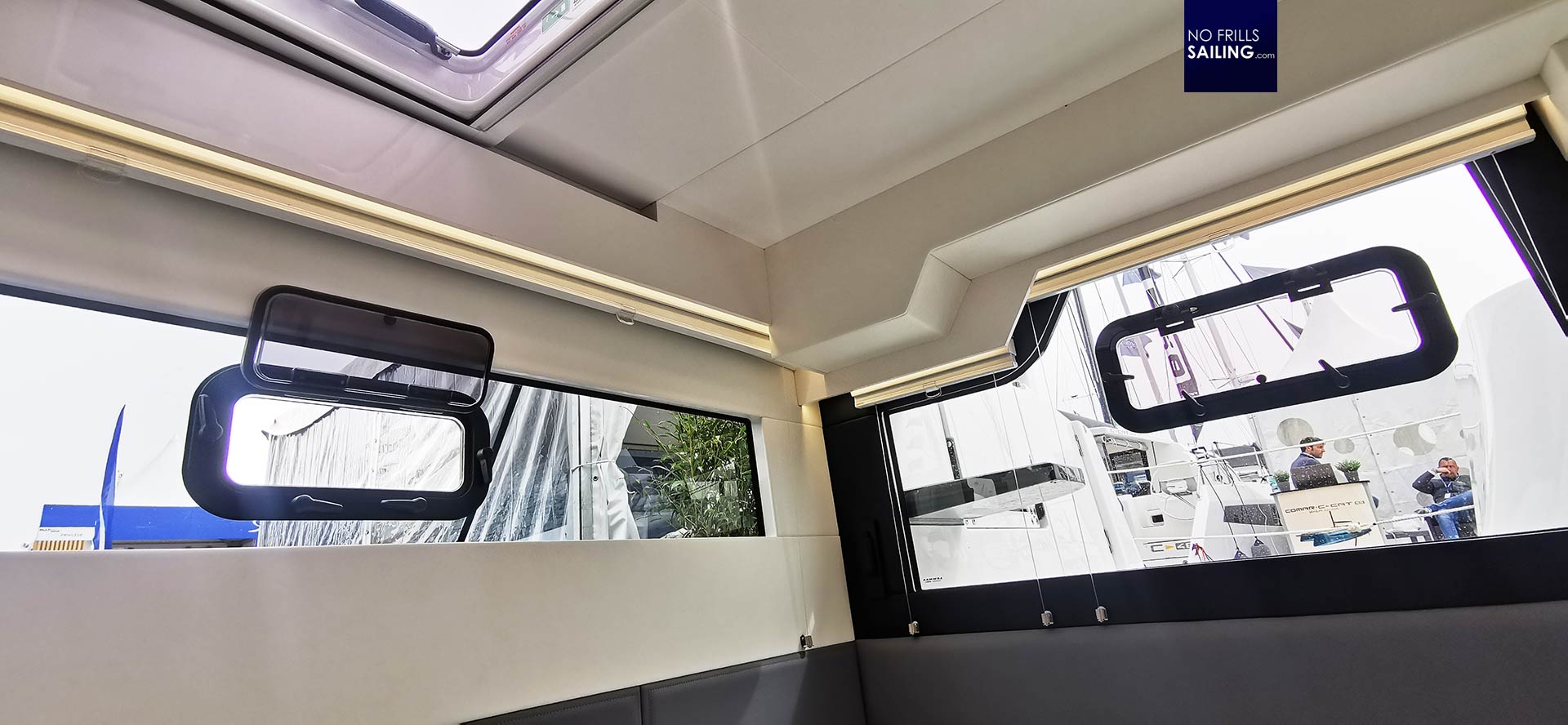
Have no fear for your privacy, all windows on the HH 44 are tempered so that nobody can peep inside. This is especially important for the aft cabin´s windows which are directly en par with the cockpit: Essentially, any helmsman would have a front row seat and look through a +70 inch TFT-screen onto the owner´s berth. Normally, you don´t want this. The beds aren´t just big, spacy and cozy. Underneath, parts of the really advanced propulsion system are installed.
Hybrid propulsion and autonomous energy generation
Sustainability in boat building is a huge thing currently and I support this. Big companies are investing a lot in research and development, smaller startups try out their ideas and approaches. Of course, full electric or hydrogen-based propulsion is a thing of the future, but the first brands have launched their hybrid boats already. The HH 44 is such a yacht and the shipyard calls their concept the “Eco Drive”.
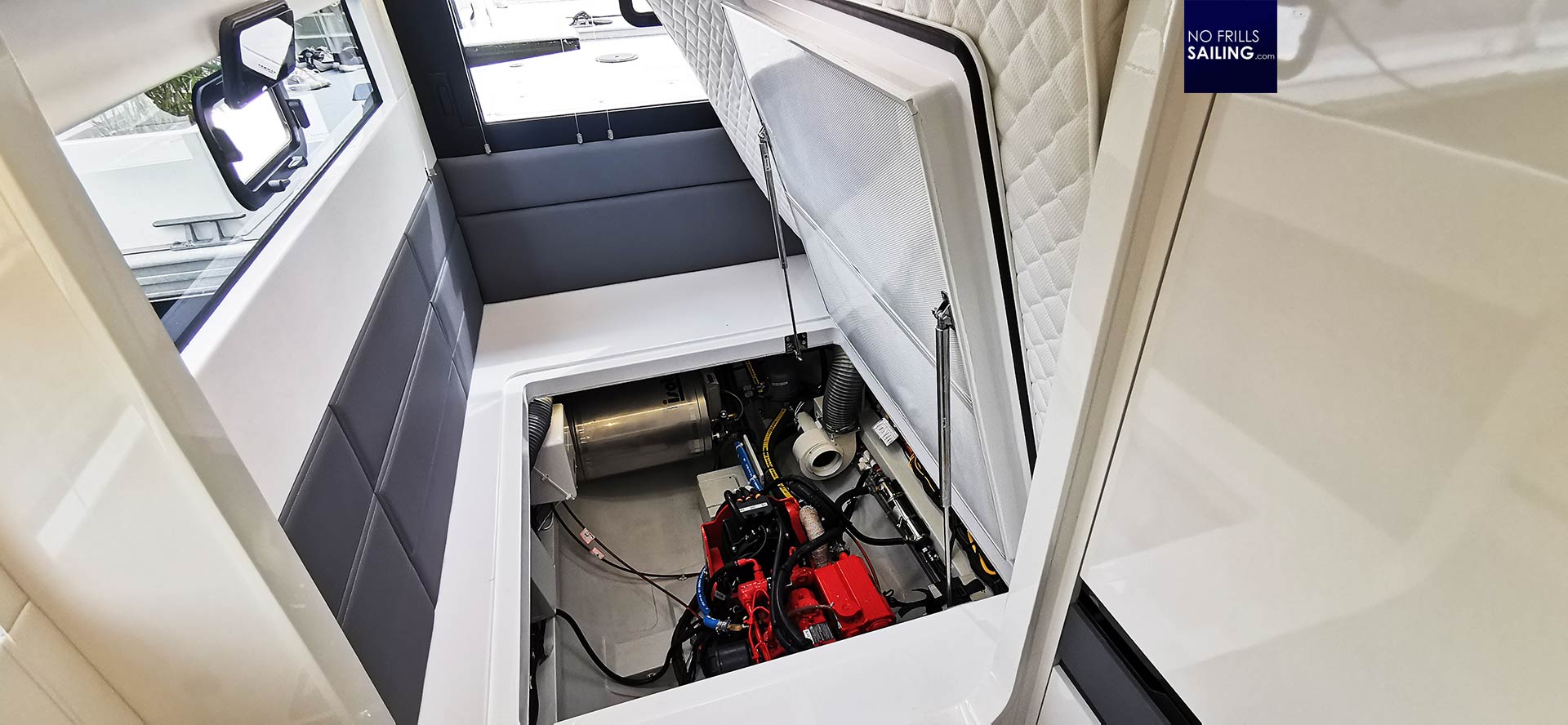
It´s basically the proven, rigid and reliable Diesel engine with a linear electric motore directly attached. This electric drive with two 10 kW also works as an alternator so that, when under Diesel engines, the large batteries are constantly reloaded. The Diesel engines (Vetus) are fitted directly underneath the aft beds. This is a rather uncommon approach and I have a lot of questions regarding heat, possible (dangerous) fumes, noise and vibrations and last not least questions like maintenance (inside the cabin) to possible exchange of an engine, but apparently HH found a solution to this.
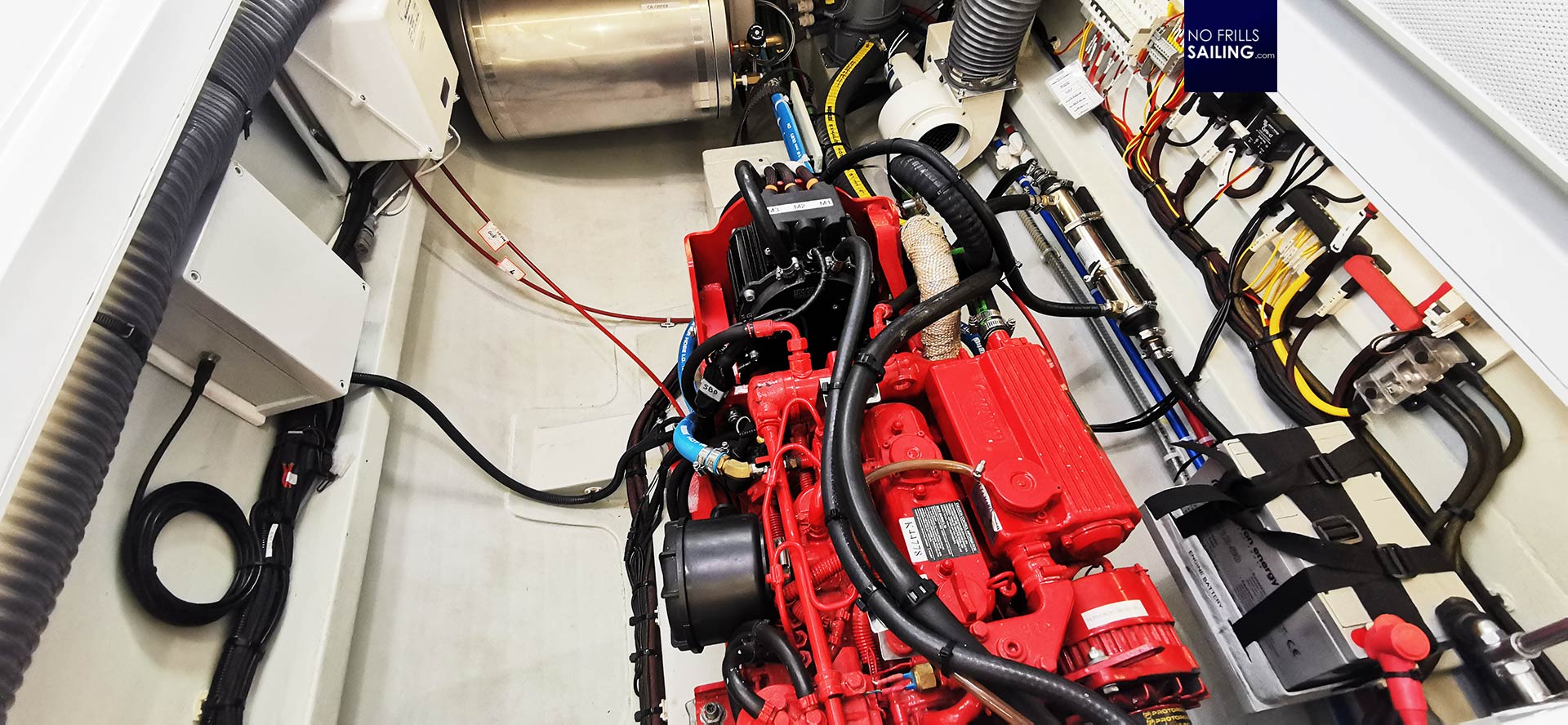
The interesting aspect of the HH Catamarans “Eco Drive” concept is the interaction of the ensemble. Diesel-mode is clear, all electric mode is also clear. Furthermore, the alternators – when sailing and the props aren´t locked – recuperation mode is possible. Meaning by having the props rotate when sailing, they function like a hydro-generator. Also, there is a very clever “mix”-mode, as I call it. When you need Diesel-Power but also sleep, only one of the Diesels can be operated whilst the other is in recuperation mode.

Entering via a big removable door or wall piece from the forward guest cabin, there is full access to the battery and charger-room. The HH 44 is equipped with a set of 48 Volts lithium batteries with a combined power of over 43 kW hours, which is very impressive. This capacity is more than enough to ensure a cruising range (at 7 knots) of over 600 nautical miles or the utilization of all possible amenities for onboard comforts, like fridges, freezers, washing machines and even an AC.
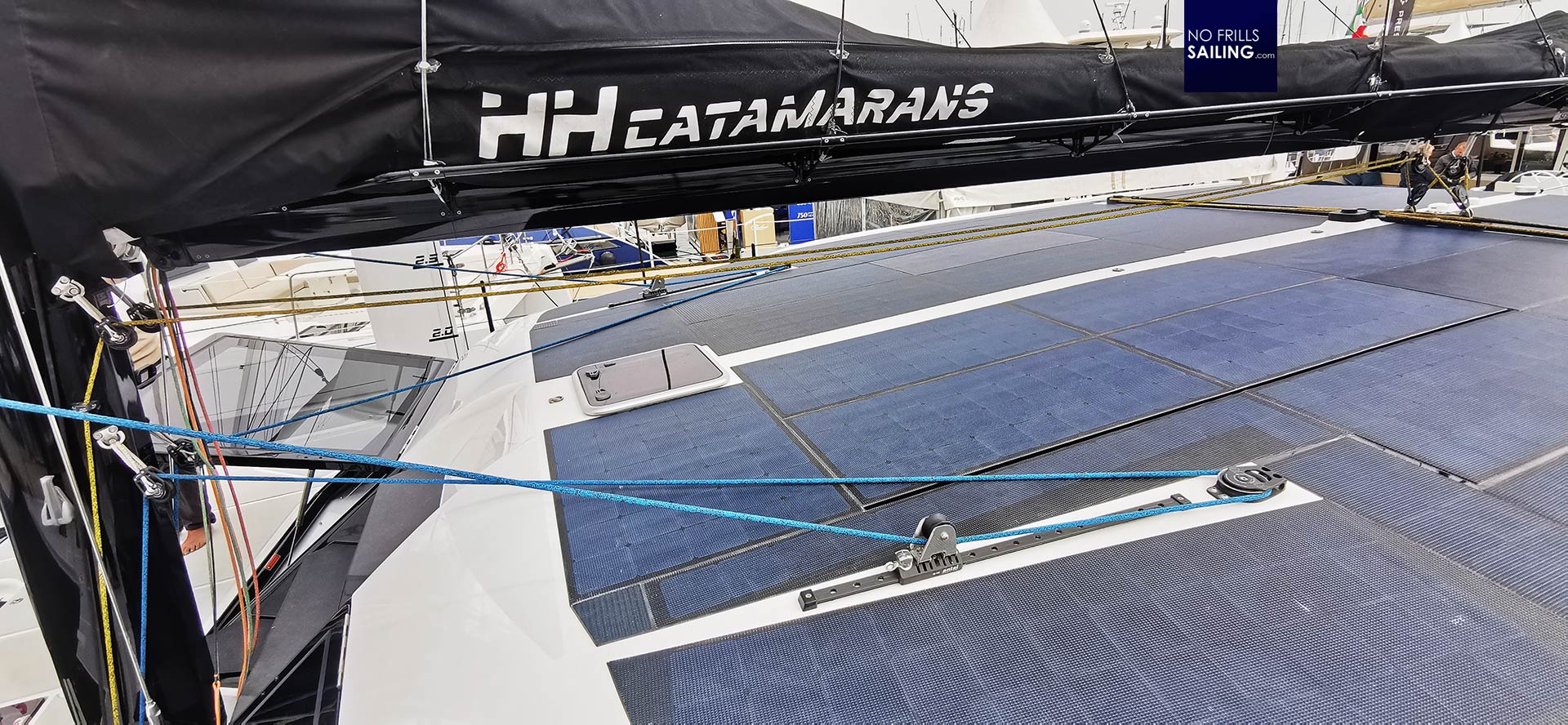
Apart from than, the whole rooftop of the catamaran is completely covered with solar panels . The maximum power generation of these is 4.200 Watt-peak, which is also a lot when sailing or anchoring in sun-rich areas. The HH 44, like his bigger sisters, is a proven concept and a safe offshore-capable system. I found especially impressive how openly and honest the shipyard declares that they consider all-electric propulsion for not ready now. For the sake of seamanship and safety at sea, this is a brave and trust-building standpoint, better than offering something that is not ready now.
Luxury amenities and full-cruising capabilities
So, with such a rich abundancy of electric power and a long lasting range of almost complete autonomy, this catamaran is set to re-define the combination of luxury cruising with performance sailing. Luxury, that´s often a matter of being able to use the same household appliances which make our daily life at shore so convenient.

The HH 44 offers all of them, and even more. For example, in the very roomy and tasteful designed owner´s bathroom I was happy to discover an electric towel dryer. Such a small appliance that can make life so much easier. A washing machine, dishwasher in the galley up and many more little “helpers” not only add to the impressive price tag here, but also and foremost add to the label “luxury sailing” which is truly earned.
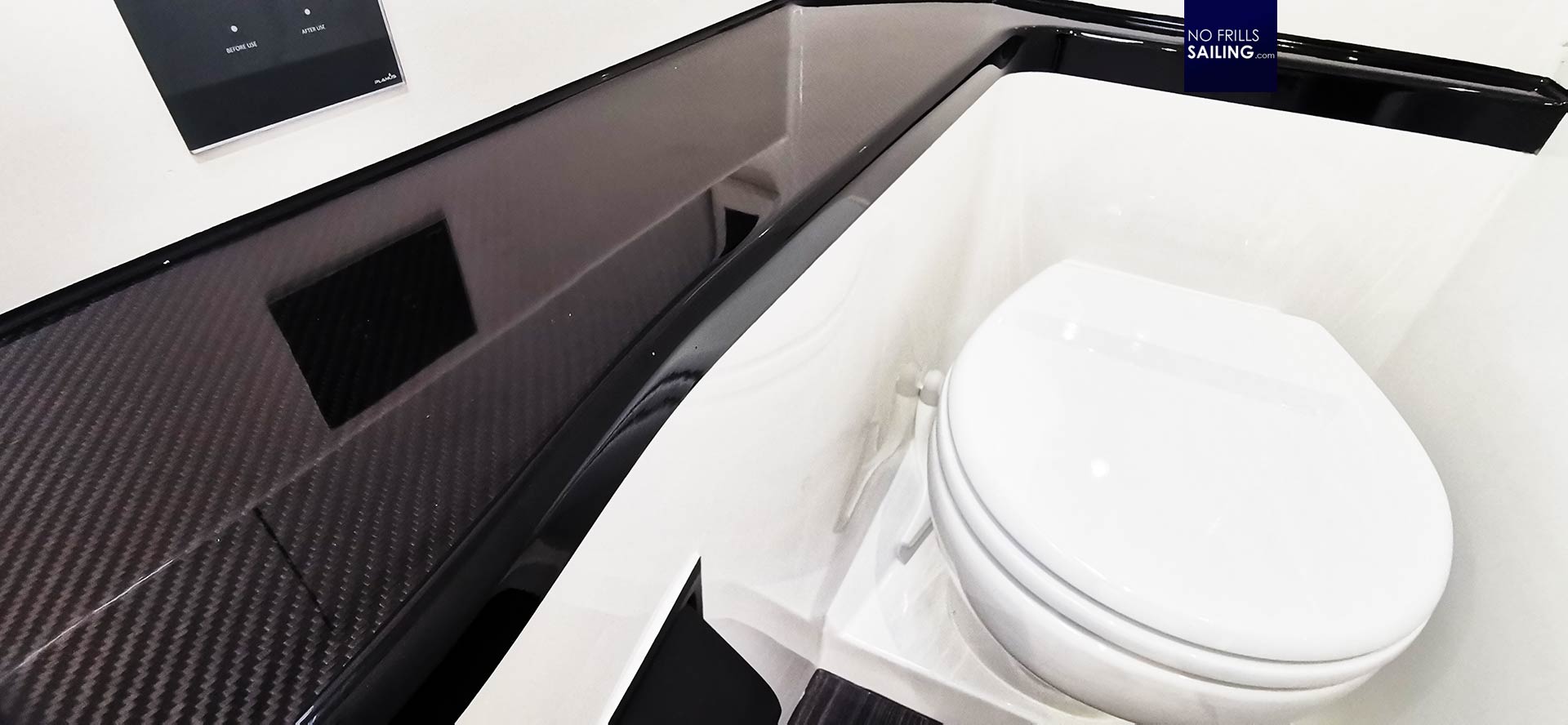
HH Catamarans utilizes latest production techniques. This can be seen by looking at the bare numbers: The HH 44 has a displacement of 10.2 tons (empty) and 14.5 tons with maximum load. Compared to the Nautitech 44 for example, that’s 1 ton lighter. Even more, almost 3 tons lighter than the 12.8 tons of the Excess 14 . How is this achieved? Carbon, lightweight sandwich layups and even prepreg-applications are used to build the boat.
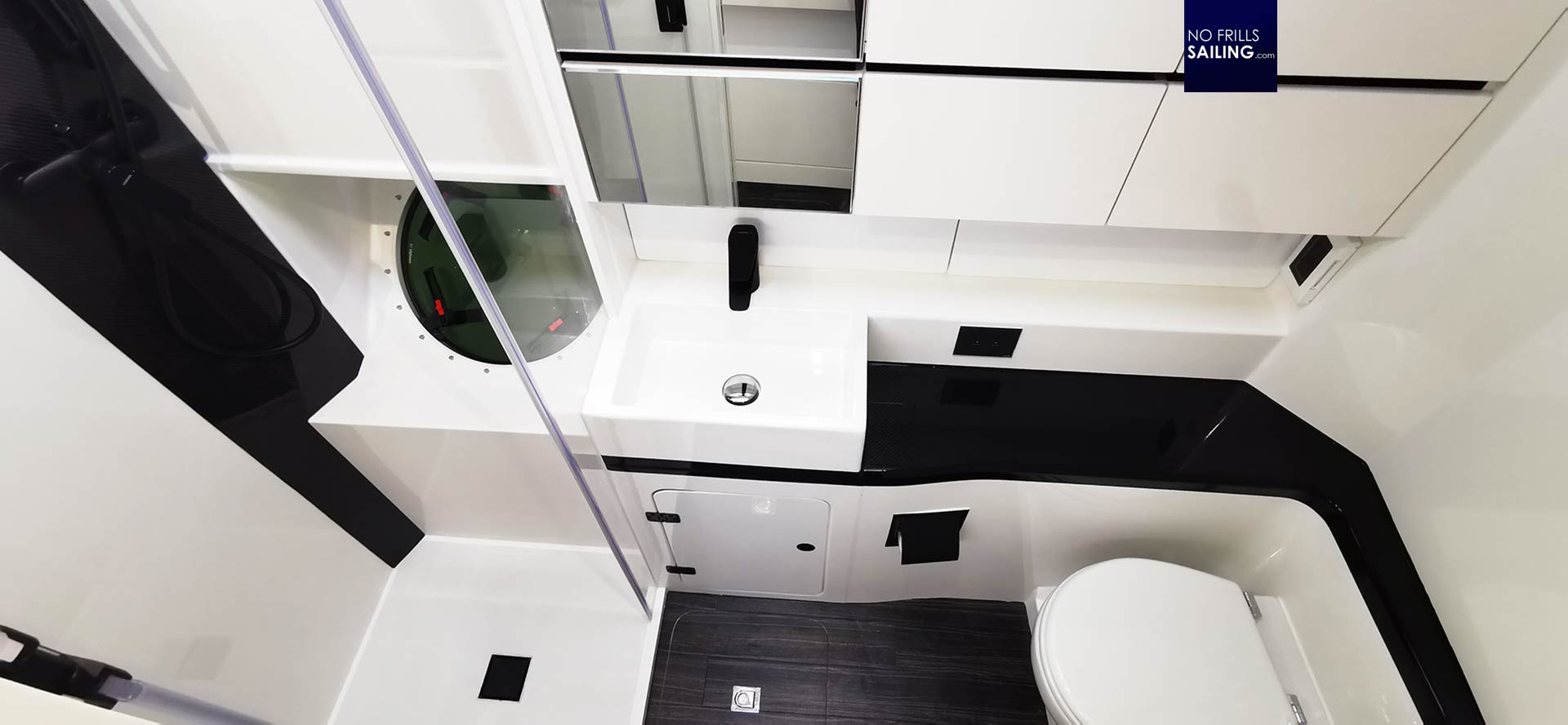
Here and there the shipyard offers a glimpse onto these facts by having bare glossy painted Carbon there to admire, for example in the bathrooms. People who know will easily recognize the thumb-metallic sound when knocking on the materials, which is a totally different sound from ordinary GRP layups.

Both boats are made for four persons who will love their aft cabins, but there´s also another guest cabin in the front with a single bed. At least here a small window nearly at the height of the head of the occupant is offered. I guess this is the cabin that will remain unoccupied anyway or utilized otherwise as additional stowage. Let´s check the performance data, now that we´ve seen her interiors.
Performance through High-Tech
In the 44/45 footer class there isn´t much to compare the HH 44 to. So let´s stick to the Nautitech Open 44, the Excess 14 and the Outremer 45 . The upwind sails area of the HH 44 is said to be 116 square meters, whereas Nautitech, Excess and Outremer clock in with 105, 135 and and 106 square meters. Being the lightest of them four boats sporting the second biggest area of canvas up in the wind, it should be clear which one performs best.
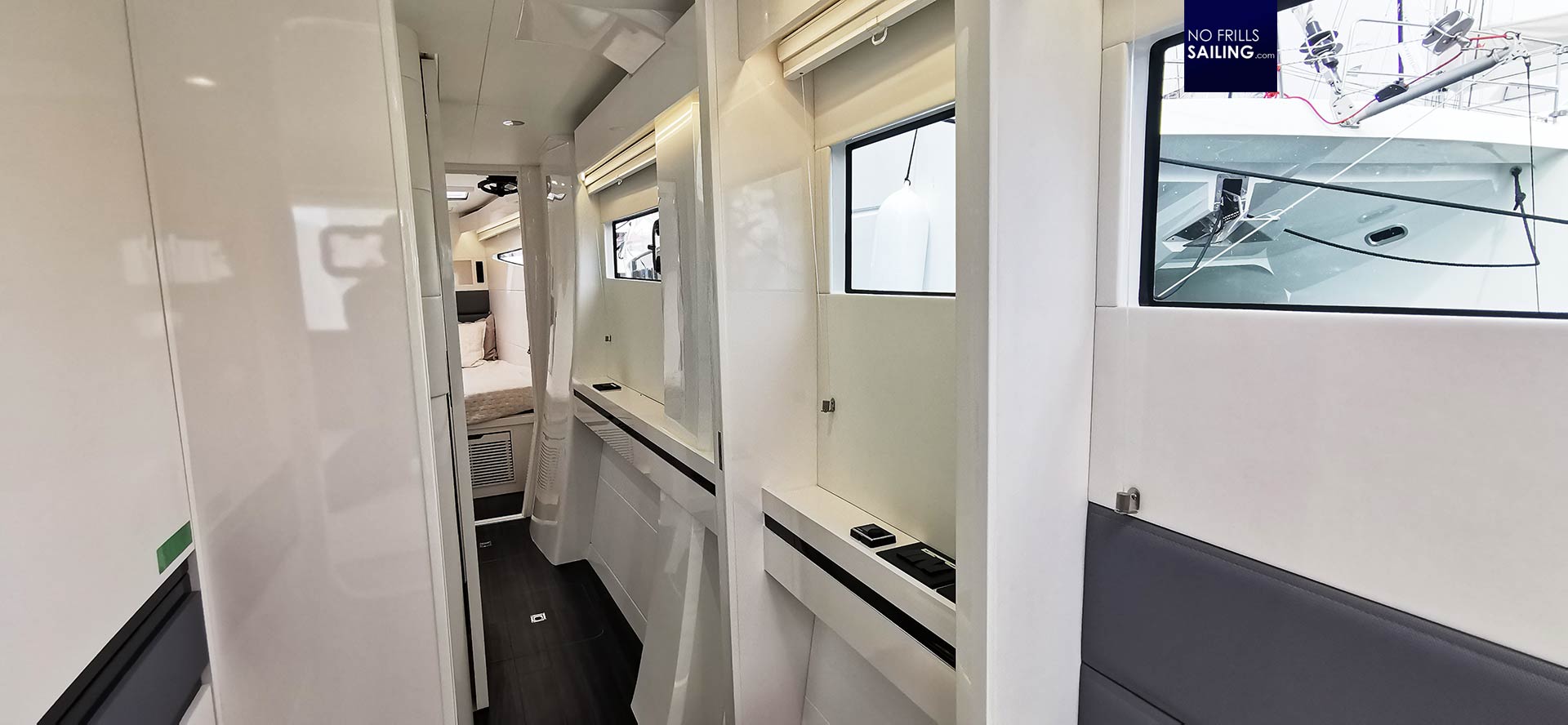
The Excess 14 is an excellent, easy to sail cruising catamaran which exceeds the projected sailing performance by the shipyard by far. But it is not a performance cat – as well as the Nautitech, both have no daggerboards which gives both the Outremer and the HH Catamaran a much better directional stability and upwind performance with significantly lessened leeway. I haven´t sailed the HH 44 (yet) but I´d say a match race between her and the Outremer 45 would be a great feat.
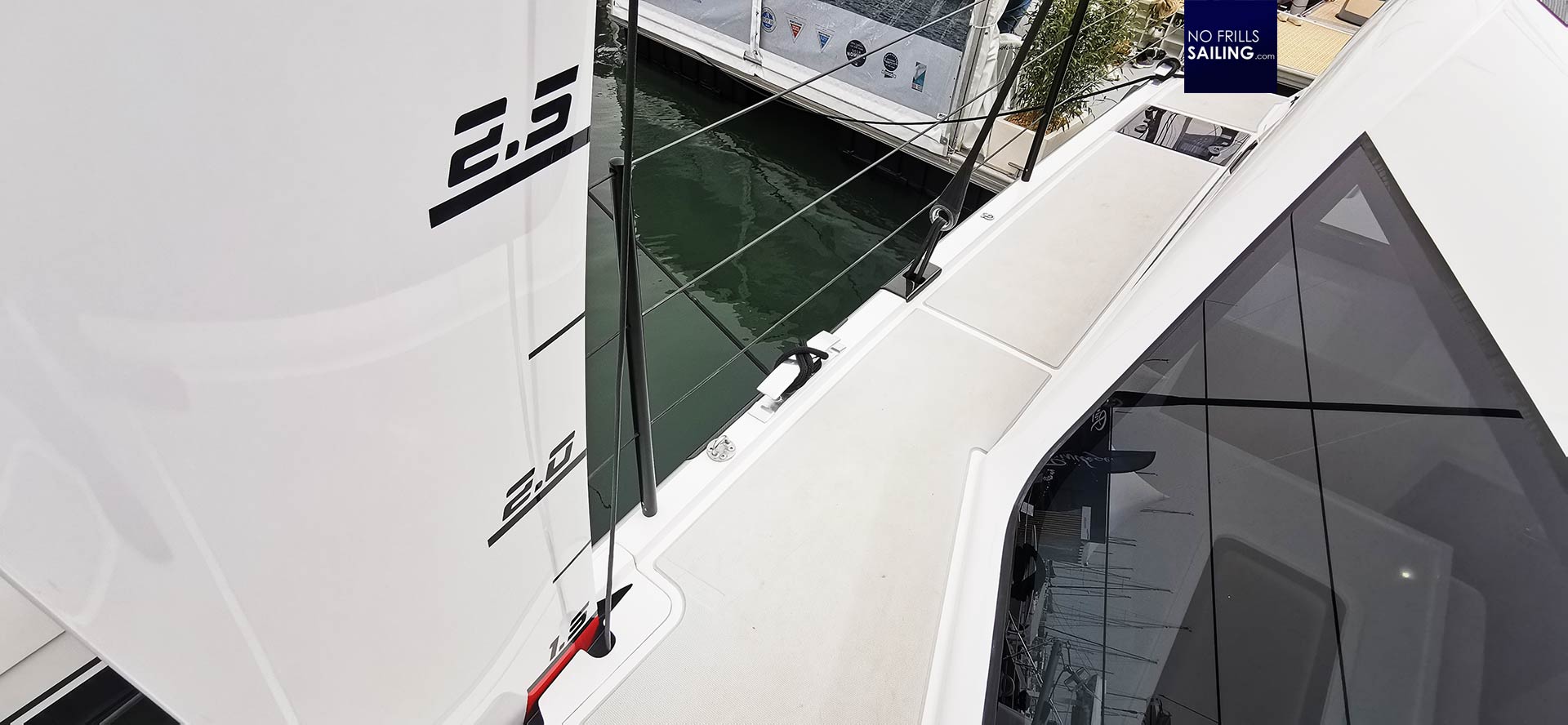
The HH 44 has rounded (C-shape) daggerboards made of carbon fibers, hence provide a huge safety margin, high stability with flexing capability and are easy to operate due to their light weight. Besides these features, walking the deck and inspecting the running rigging, I notice so many great details, like the Carbon shrouds with soft shackles or the tall 90 cm stanchions which provide maximum safety.
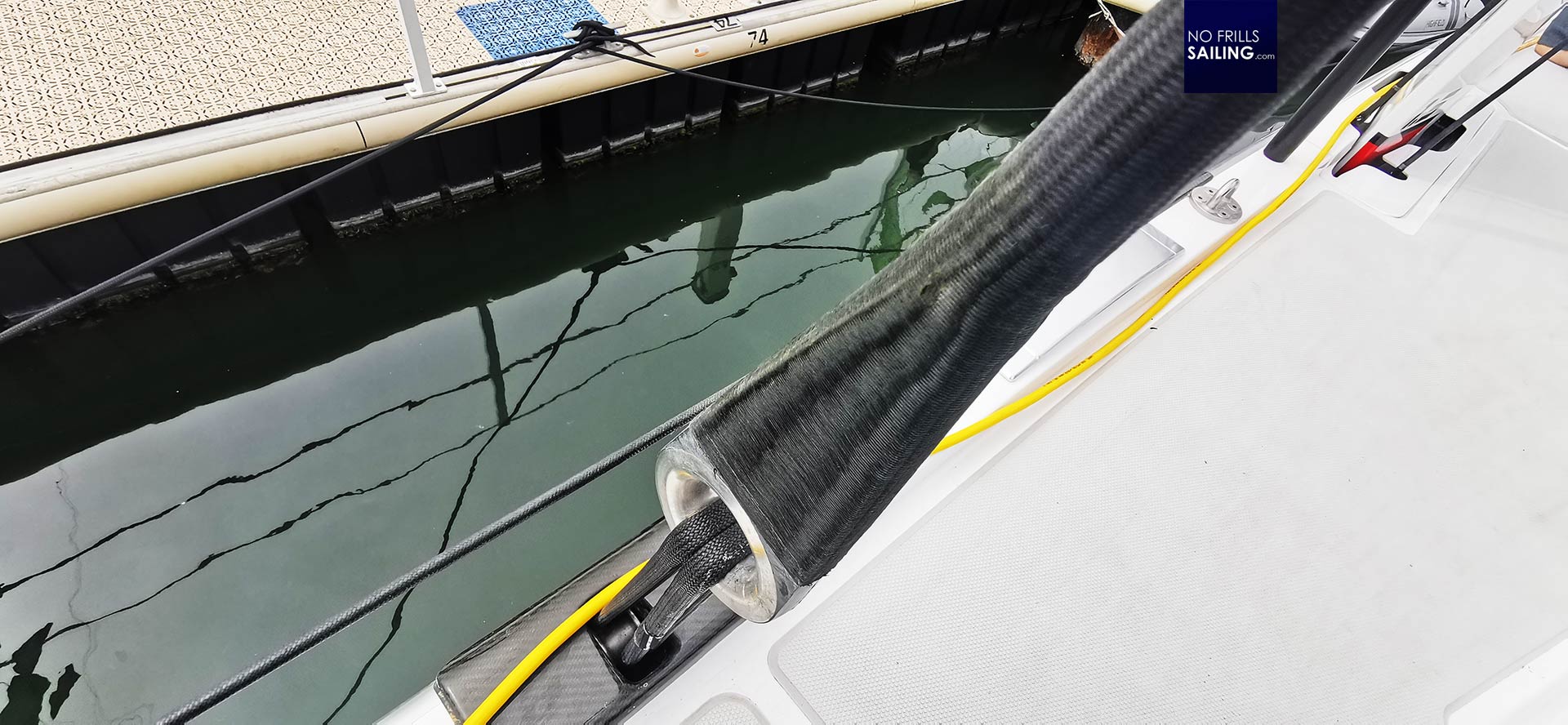
The HH 44 is a classy sports catamaran with two full-sized helm stations in the cockpit. The starboard side features the primary plotter and all control panels for anchor windlass, all electric winches (which can also be operated by foot) and some secondary displays for wind and log-data. Like on the Outremer 52, the steering wheels are mounted on a pivoting stand.
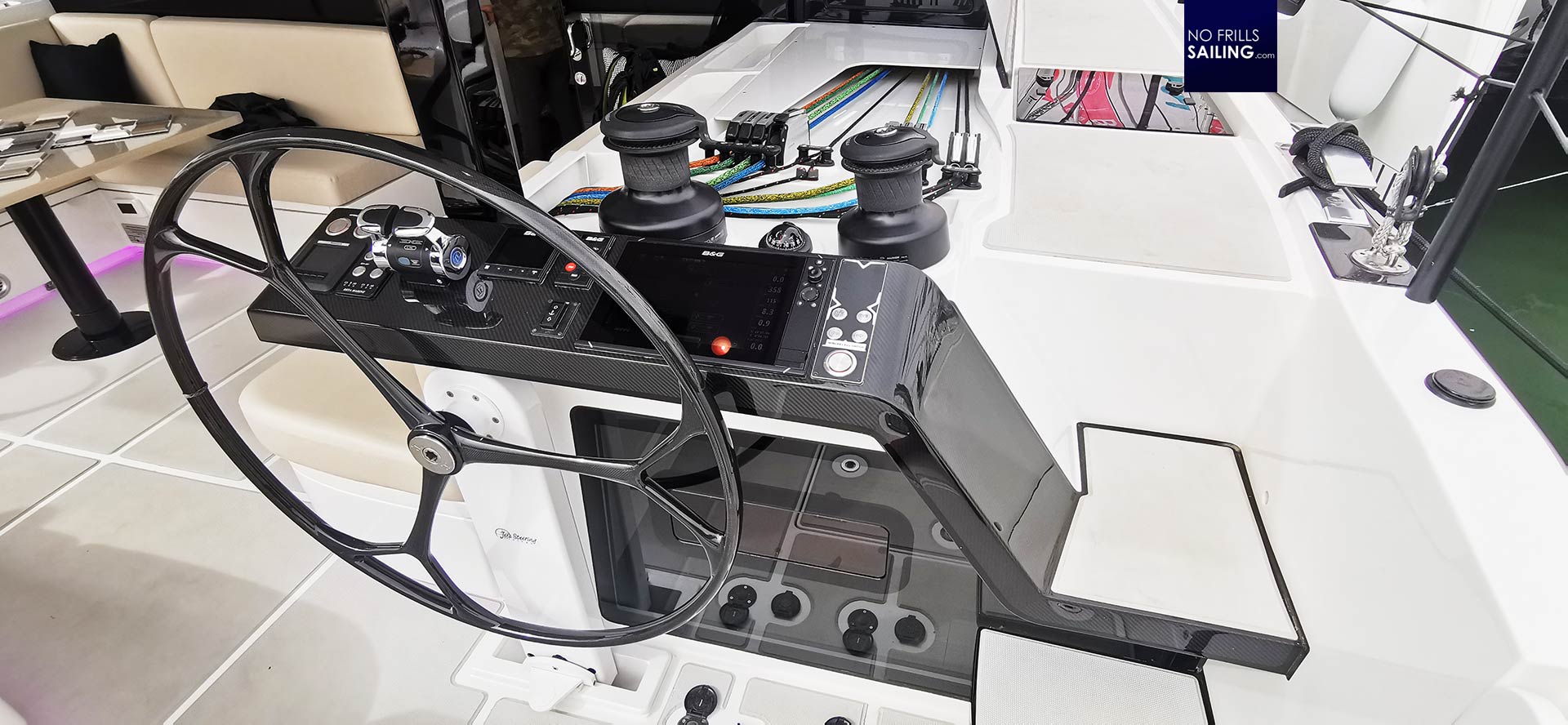
So in active “fun” sailing mode, the wheels are put to the outer face of the hulls, granting perfect view over the leeward hull. In cruising mode or during bad weather phases, the wheel is put to middle position (as shown in the pictures) to grant a dry stand for the helmsman underneath the hardtop and they can even pivot further into the inside of the cockpit, maybe useful in long motoring sessions.
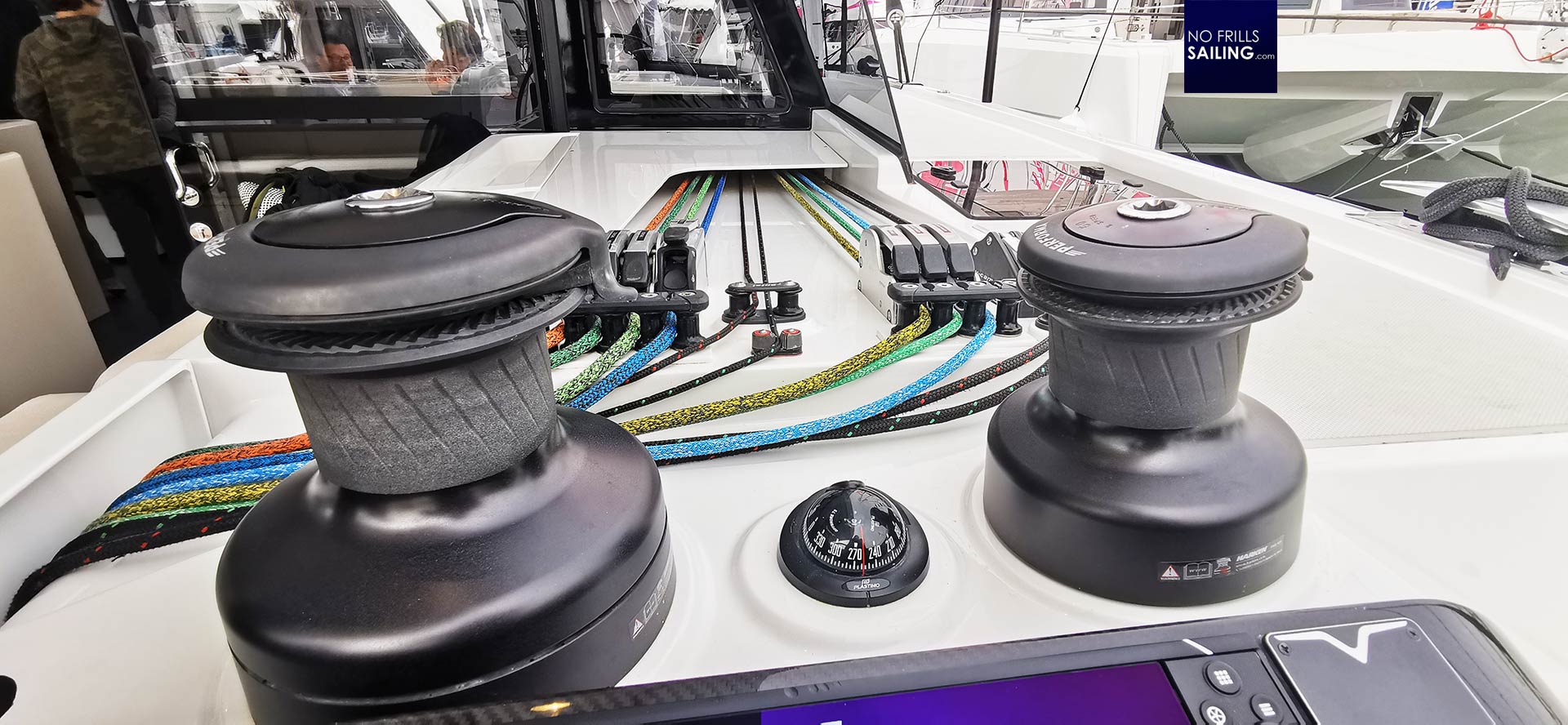
The handling of all lines and winches is ergonomically perfect, all is well protected. I must say that for my taste a bit more “exposure” to the elements wouldn´t had been bad as I deemed the forward vision through the cabin windows an bit obstructed. Excess and Outremer have much more exposed helm stations in this matter. On the other side, aboard the HH 44 safety is apparently of utmost importance and a such this explains the decision for the positioning the helmstations this way.
A perfect ship?
Praise for the HH 44 is unison high. These boats win awards like Tiger Woods in his golden days. This year the catamaran was nominated for the prestigious “Multihull of the Year”-award. And as rumors go, they haven´t won because of the – surely justified, but ridiculously – high price of well over 1.5 million Euros. I can clearly see why the yachting magazines and blogs are full of admiration for this boat: Her finishing and building quality is close to flawless.
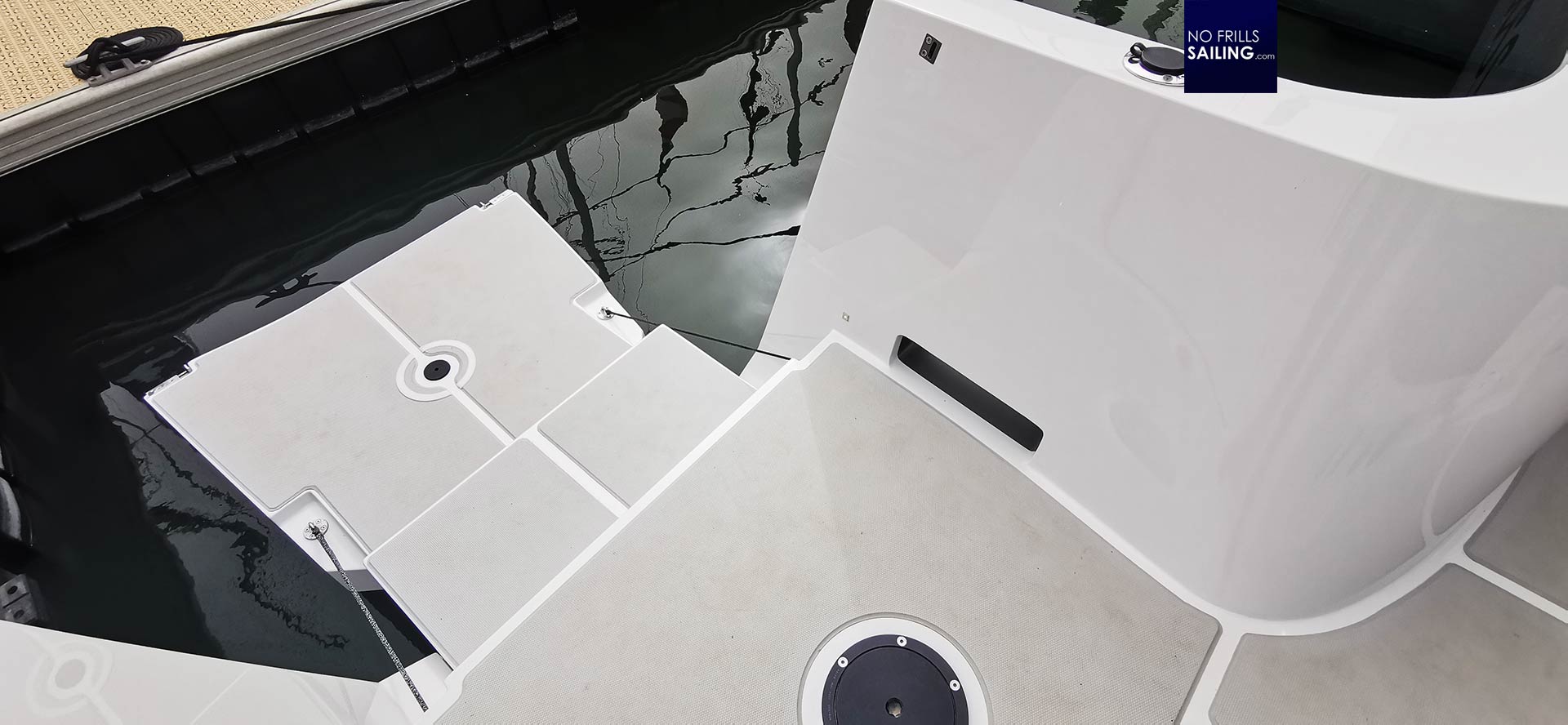
So I leave the boat after my intense time aboard. I leave her over one of the foldable bathing platforms, which also brings me back to the beginning of this article. Comparing the HH 44 to the ENTERPRISE D, with a “best view” and some more awkward angles. The closed stern with a foldable bathing platform is the reason for the strange looks of the HH 44. Now that I understood that safety is the main thing on this boat – I can see the advantage of having such a closed stern.
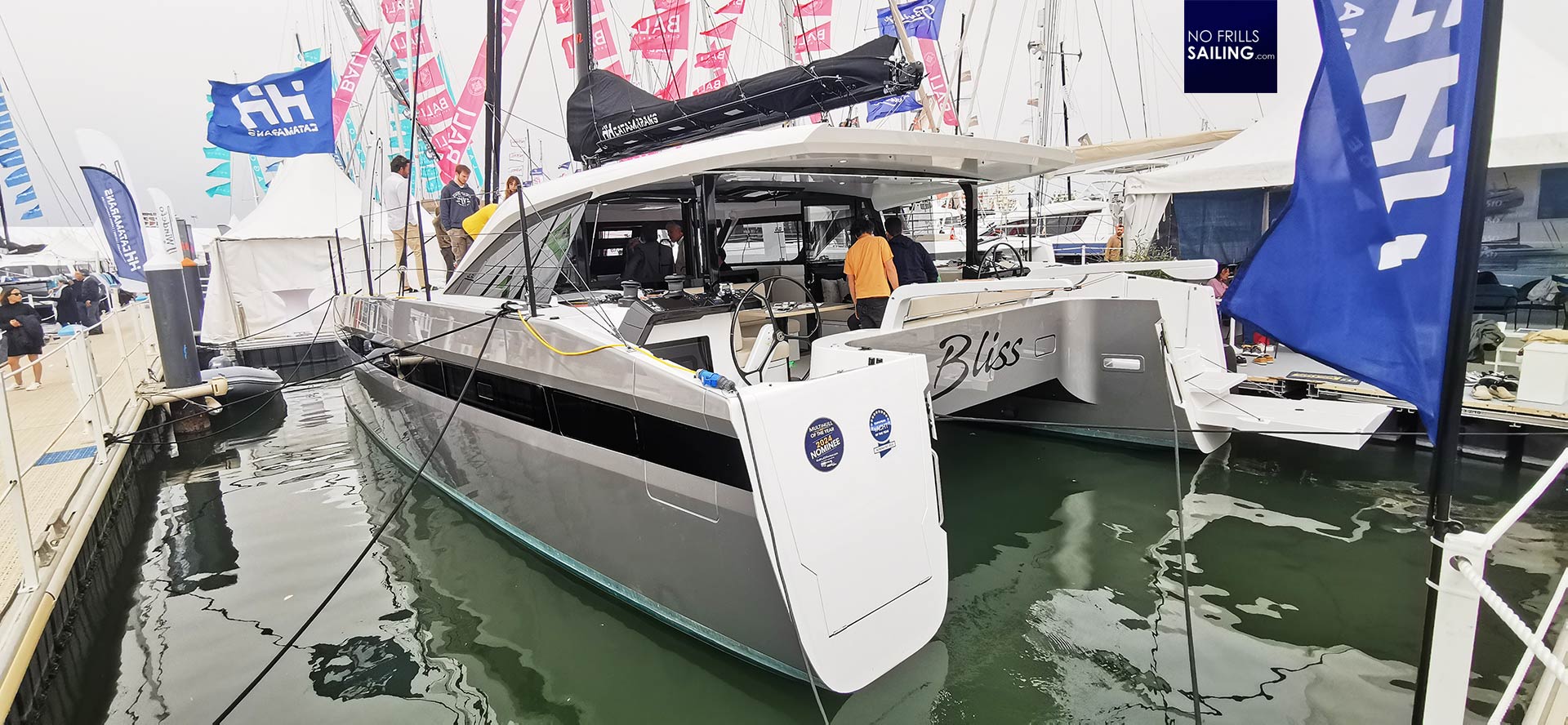
This is a view I could grow into and make my peace with. Yes, the high-active fully exposed Outremer 45 helm station is super exciting and makes for the most adventurous shots, but at the same time, standing a watch up there in really bad weather is clearly much more dangerous than on the HH 44. In the end, this catamaran shows how high class boatbuilding goes if tooling, machinery, material choice, intense high-class labour and of course a later price to be paid is all but secondary. The full order books of HH Catamarans speak for themselves, as well as the opening of a second high-tech production facility in Cebu. Impressive!
You might as well be interested in these related articles:
Carbon overflow: Gunboat!
At the Outremer shipyard
Sea Trial of the Excess 14 catamaran
why art education is important essay
New evidence of the benefits of arts education.
Subscribe to the brown center on education policy newsletter, brian kisida and bk brian kisida assistant professor, truman school of public affairs - university of missouri daniel h. bowen dhb daniel h. bowen assistant professor, college of education and human development - texas a&m university.
February 12, 2019
Engaging with art is essential to the human experience. Almost as soon as motor skills are developed, children communicate through artistic expression. The arts challenge us with different points of view, compel us to empathize with “others,” and give us the opportunity to reflect on the human condition. Empirical evidence supports these claims: Among adults, arts participation is related to behaviors that contribute to the health of civil society , such as increased civic engagement, greater social tolerance, and reductions in other-regarding behavior. Yet, while we recognize art’s transformative impacts, its place in K-12 education has become increasingly tenuous.
A critical challenge for arts education has been a lack of empirical evidence that demonstrates its educational value. Though few would deny that the arts confer intrinsic benefits, advocating “art for art’s sake” has been insufficient for preserving the arts in schools—despite national surveys showing an overwhelming majority of the public agrees that the arts are a necessary part of a well-rounded education.
Over the last few decades, the proportion of students receiving arts education has shrunk drastically . This trend is primarily attributable to the expansion of standardized-test-based accountability, which has pressured schools to focus resources on tested subjects. As the saying goes, what gets measured gets done. These pressures have disproportionately affected access to the arts in a negative way for students from historically underserved communities. For example, a federal government report found that schools designated under No Child Left Behind as needing improvement and schools with higher percentages of minority students were more likely to experience decreases in time spent on arts education.
We recently conducted the first ever large-scale, randomized controlled trial study of a city’s collective efforts to restore arts education through community partnerships and investments. Building on our previous investigations of the impacts of enriching arts field trip experiences, this study examines the effects of a sustained reinvigoration of schoolwide arts education. Specifically, our study focuses on the initial two years of Houston’s Arts Access Initiative and includes 42 elementary and middle schools with over 10,000 third- through eighth-grade students. Our study was made possible by generous support of the Houston Endowment , the National Endowment for the Arts , and the Spencer Foundation .
Due to the program’s gradual rollout and oversubscription, we implemented a lottery to randomly assign which schools initially participated. Half of these schools received substantial influxes of funding earmarked to provide students with a vast array of arts educational experiences throughout the school year. Participating schools were required to commit a monetary match to provide arts experiences. Including matched funds from the Houston Endowment, schools in the treatment group had an average of $14.67 annually per student to facilitate and enhance partnerships with arts organizations and institutions. In addition to arts education professional development for school leaders and teachers, students at the 21 treatment schools received, on average, 10 enriching arts educational experiences across dance, music, theater, and visual arts disciplines. Schools partnered with cultural organizations and institutions that provided these arts learning opportunities through before- and after-school programs, field trips, in-school performances from professional artists, and teaching-artist residencies. Principals worked with the Arts Access Initiative director and staff to help guide arts program selections that aligned with their schools’ goals.
Our research efforts were part of a multisector collaboration that united district administrators, cultural organizations and institutions, philanthropists, government officials, and researchers. Collective efforts similar to Houston’s Arts Access Initiative have become increasingly common means for supplementing arts education opportunities through school-community partnerships. Other examples include Boston’s Arts Expansion Initiative , Chicago’s Creative Schools Initiative , and Seattle’s Creative Advantage .
Through our partnership with the Houston Education Research Consortium, we obtained access to student-level demographics, attendance and disciplinary records, and test score achievement, as well as the ability to collect original survey data from all 42 schools on students’ school engagement and social and emotional-related outcomes.
We find that a substantial increase in arts educational experiences has remarkable impacts on students’ academic, social, and emotional outcomes. Relative to students assigned to the control group, treatment school students experienced a 3.6 percentage point reduction in disciplinary infractions, an improvement of 13 percent of a standard deviation in standardized writing scores, and an increase of 8 percent of a standard deviation in their compassion for others. In terms of our measure of compassion for others, students who received more arts education experiences are more interested in how other people feel and more likely to want to help people who are treated badly.
When we restrict our analysis to elementary schools, which comprised 86 percent of the sample and were the primary target of the program, we also find that increases in arts learning positively and significantly affect students’ school engagement, college aspirations, and their inclinations to draw upon works of art as a means for empathizing with others. In terms of school engagement, students in the treatment group were more likely to agree that school work is enjoyable, makes them think about things in new ways, and that their school offers programs, classes, and activities that keep them interested in school. We generally did not find evidence to suggest significant impacts on students’ math, reading, or science achievement, attendance, or our other survey outcomes, which we discuss in our full report .
As education policymakers increasingly rely on empirical evidence to guide and justify decisions, advocates struggle to make the case for the preservation and restoration of K-12 arts education. To date, there is a remarkable lack of large-scale experimental studies that investigate the educational impacts of the arts. One problem is that U.S. school systems rarely collect and report basic data that researchers could use to assess students’ access and participation in arts educational programs. Moreover, the most promising outcomes associated with arts education learning objectives extend beyond commonly reported outcomes such as math and reading test scores. There are strong reasons to suspect that engagement in arts education can improve school climate, empower students with a sense of purpose and ownership, and enhance mutual respect for their teachers and peers. Yet, as educators and policymakers have come to recognize the importance of expanding the measures we use to assess educational effectiveness, data measuring social and emotional benefits are not widely collected. Future efforts should continue to expand on the types of measures used to assess educational program and policy effectiveness.
These findings provide strong evidence that arts educational experiences can produce significant positive impacts on academic and social development. Because schools play a pivotal role in cultivating the next generation of citizens and leaders, it is imperative that we reflect on the fundamental purpose of a well-rounded education. This mission is critical in a time of heightened intolerance and pressing threats to our core democratic values. As policymakers begin to collect and value outcome measures beyond test scores, we are likely to further recognize the value of the arts in the fundamental mission of education.
Related Content
Seth Gershenson
January 13, 2016
Brian Kisida, Bob Morrison, Lynn Tuttle
May 19, 2017
Joan Wasser Gish, Mary Walsh
December 12, 2016
Education Policy K-12 Education
Governance Studies
Brown Center on Education Policy
Sweta Shah, Donald Wertlieb, Charlotte Vuyiswa McClain-Nhlapo, Ruchi Kulbir Singh, Kathy Hirsh-Pasek
July 24, 2024
Carol Graham
July 22, 2024
Dina Buchbinder, Kathy Hirsh-Pasek
July 18, 2024
- Residential Summer Studio
- Program Technical Requirements
- Tuition & Financial Aid
- International Students
- Graduate Research Award
Accreditations
- Request Brochure
- (877) 360-1859
- Art Education in the Classroom
The Importance of Art Education in the Classroom
November 30, 2023

That deceptively simple, four-word query confronts a topic that’s occupied some of the world’s greatest creators and philosophers since Plato. How we answer this question can have much bigger consequences than whether you get to buy a piece of artwork from Banksy’s online store. The issue of art’s value becomes far more pressing when policymakers and administrators decide how to allocate time and funding for art education in schools.
Art teachers must be ready to advocate for committing the necessary resources to prioritize the value of creativity in the classroom. You may have to explain the importance of art education in a school’s curriculum and present the research to back up those claims. We can become powerful advocates for the power of art and improved student outcomes by investigating the many benefits that come out of integrating more creativity into the school day and improving our classroom strategies .
Why Is Art Education In Schools Important?
Anyone who’s passionate about the arts recalls formative moments of experiencing a work of art pushing through a creative challenge. When we’re exposed to remarkable artworks or have opportunities to create, we find that art is crucial to individual growth and development and can even impact our health.
A literature review from Frontiers in Psychology outlined several studies linking aesthetic experiences with broad improvements in subjects’ emotional states that promote physical and psychological well-being. Giving learners the time, space, and materials for creative expression can lower stress, improve memory, and make them feel more socially connected. Instructors can build their careers on bringing those experiences to students in a variety of settings, like galleries, museums, or events organized by nonprofit and community organizations.
Appreciation for art also makes a significant difference in people’s lives on a macro level. Entire societies may stand to gain from an investment in the arts. Drawing on data from the General Social Survey, researchers from the University of Illinois at Chicago’s Department of Public Administration linked participation as either an audience member or creator to higher levels of civic engagement and social tolerance . This work suggests that children learning how to draw, paint, sing, or just appreciate the works made by others can help us become not just happier and healthier, but also better people. Learn about UF’s Online Master of Arts in Art Education program
How Does Art Education Help Students?
When surveyed by the nonprofit organization Americans for the Arts, members of the U.S. public overwhelmingly agreed that the arts are one aspect of a well-rounded K-12 education . In addition, a recent study conducted in Houston public schools showed that students who participated in arts education see the following benefits:
- Improved writing achievement
- Reduced disciplinary infractions
- More student engagement
- Improved college aspirations
- No drop in standardized test scores
Yet, participation in the visual and performing arts is often treated as merely supplemental to other aspects of learning. As a result, there are major differences in access to art and music classes across the country.
2019 findings from the National Assessment of Educational Progress showed that eighth graders in the Northeast were much more likely to report being enrolled in a visual arts course than those in the South. Disparities were also tied to race, ethnicity, family income, and whether a school is located in a city, suburb, town, or rural area.
Meanwhile, the Nation’s Report Card shows that U.S. students continue to score lower than many of their peers in Europe and Asia on standardized tests despite years of pressure on educators to close the achievement gap. But seeking to improve student performance in math and reading does not have to come at the expense of art education.
In fact, researchers from the Johns Hopkins University School of Education, argue that instruction becomes more effective when educators integrate creative activities and make them central to academic development. Across disciplines, including STEM, there’s room to reimagine classes with a strong emphasis on drawing, painting, playing music, performing drama, and other creative pursuits. Encouraging students to use their imagination can help them actively engage with new concepts and discover connections between ideas as well as provide advantages for their social and emotional well-being.
One example of effectively integrating arts and creative expression with other fields as a pedagogical strategy can be seen in the collaboration between University of Florida faculty members Susan K. Jacobson, who studies wildlife ecology and conservation, and Robert C. Mueller, who teaches printmaking. The UF professors collaborated on an interdisciplinary project in climate change communication in which groups of graduate students from both the School of Natural Resources and the Environment and the College of the Arts visited the university’s Seahorse Key Marine Laboratory. The students participated in learning activities like scientific lectures, discussions, and making collages before working in small groups to create environmental communication materials for visitors.
As this example shows, students benefit from learning to embrace insights from multiple disciplines, and this can be valuable when they go on to pursue jobs. A 2019 survey from the National Association of Colleges and Employers showed that employers are interested in hiring professionals with skills that can be strengthened through participation in the arts, such as written communication, problem-solving, teamwork, and taking initiative. Art teachers can help students become more well-rounded and capable individuals by teaching them to develop original ideas through creative projects and practices.
The Importance of Art Education in Early Childhood and Beyond
It’s never too soon to introduce kids to the possibilities of creative expression. As outlined in a literature review from the National Endowment for the Arts, a variety of studies demonstrate the value of embedding artistic practice into early childhood education . Imaginative activities for young learners can lead to better skills in social interactions and emotional regulation.
Lessons in the arts introduce K-12 students to problem-solving techniques, which help them to see the world in new ways, and provide access to creative ways of knowing. Kids discover how art can communicate their own ideas and may become interested in creating increasingly realistic depictions and mastering new techniques. By high school, young artists can think critically about their own work and that of others, establishing a unique point of view and a sense of community with other creative individuals.
The National Core Arts Standards provide a framework for advancing students’ artistic understanding . This structure breaks down the developmental stages from Pre K through high school into 10 anchor standards. In each stage, students build creative habits as they learn to:
- Generate and conceptualize artistic ideas and work
- Organize and develop ideas and work
- Refine and complete artistic work
- Select, analyze, and interpret artistic work for presentation
- Convey meaning through the presentation
- Perceive and analyze artistic work
- Interpret intent and meaning
- Apply criteria to evaluate work
- Make art by synthesizing and relating knowledge and personal experiences
- Deepen understanding by relating artistic ideas to societal, historical, and cultural contexts
Pediatrician Dr. Perri Klass outlined the benefits of art education in schools in the New York Times, noting improvements for overall motivation, thinking, and academic achievement . An arts-integrated curriculum that asks students to draw or sing as part of the learning process may enhance their ability to recall material such as scientific principles or vocabulary. Foregrounding creativity can be especially effective for students who struggle to retain information from traditional lectures and reading assignments alone.
Art does matter in the classroom, delivering a wide range of advantages for students. Educators can make the most of that potential by equipping themselves to offer creative practice as a central feature in the curriculum and show decisionmakers how these initiatives can achieve transformative results. The University of Florida’s online Master of Arts in Art Education (MAAE) program helps teachers make a difference. This program features courses that prepare educators to work in a variety of learning environments , support students of all ages, incorporate digital tools into their pedagogy, and foster critical thinking.
About the Online Master’s in Art Education from the University of Florida
The University of Florida’s online Master of Arts in Art Education (MAAE) program engages students purposefully in art education theory and practice, contemporary art, and their own studio work. Our dynamic online learning environment fosters meaningful interaction with peers and our world-class faculty as members of a supportive, close-knit community of art educators, artists, cultural workers, and scholars. This flexible program brings you the advanced concepts and immersive, hands-on experiences you need to flourish academically and creatively.
Request Information
University of Florida has engaged AllCampus to help support your educational journey. AllCampus will contact you shortly in response to your request for information. About AllCampus . Privacy Policy . You may opt out of receiving communications at any time.
* All Fields are Required. Your Privacy is Protected. Are you enrolling from outside the US? Click here.
Benefit from the UF’s heritage of academic excellence and complete an NASAD-accredited master’s program entirely online.

Latest Articles
- The Importance of Art Education in the Classroom | 11/30/2023
- Watch a Video Featuring Student Prints & At-Home Studio Tours | 06/07/2021
- UF Alumnus Brings Art Education to a Juvenile Detention Center | 06/02/2021
- Back to School in a Pandemic | 05/27/2021
Related Categories:
- Phone: (877) 360-1859
- Email: [email protected]
- Request Info
- Our Mission
Why Arts Education Is Crucial, and Who’s Doing It Best
Art and music are key to student development.
"Art does not solve problems, but makes us aware of their existence," sculptor Magdalena Abakanowicz has said. Arts education, on the other hand, does solve problems. Years of research show that it's closely linked to almost everything that we as a nation say we want for our children and demand from our schools: academic achievement, social and emotional development, civic engagement, and equitable opportunity.
Involvement in the arts is associated with gains in math, reading, cognitive ability, critical thinking, and verbal skill. Arts learning can also improve motivation, concentration, confidence, and teamwork. A 2005 report by the Rand Corporation about the visual arts argues that the intrinsic pleasures and stimulation of the art experience do more than sweeten an individual's life -- according to the report, they "can connect people more deeply to the world and open them to new ways of seeing," creating the foundation to forge social bonds and community cohesion. And strong arts programming in schools helps close a gap that has left many a child behind: From Mozart for babies to tutus for toddlers to family trips to the museum, the children of affluent, aspiring parents generally get exposed to the arts whether or not public schools provide them. Low-income children, often, do not. "Arts education enables those children from a financially challenged background to have a more level playing field with children who have had those enrichment experiences,'' says Eric Cooper, president and founder of the National Urban Alliance for Effective Education .
It has become a mantra in education that No Child Left Behind, with its pressure to raise test scores, has reduced classroom time devoted to the arts (and science, social studies, and everything else besides reading and math). Evidence supports this contention -- we'll get to the statistics in a minute -- but the reality is more complex. Arts education has been slipping for more than three decades, the result of tight budgets, an ever-growing list of state mandates that have crammed the classroom curriculum, and a public sense that the arts are lovely but not essential.
This erosion chipped away at the constituencies that might have defended the arts in the era of NCLB -- children who had no music and art classes in the 1970s and 1980s may not appreciate their value now. "We have a whole generation of teachers and parents who have not had the advantage of arts in their own education,'' says Sandra Ruppert, director of the Arts Education Partnership (AEP), a national coalition of arts, business, education, philanthropic, and government organizations.
The Connection Between Arts Education and Academic Achievement
Yet against this backdrop, a new picture is emerging. Comprehensive, innovative arts initiatives are taking root in a growing number of school districts. Many of these models are based on new findings in brain research and cognitive development, and they embrace a variety of approaches: using the arts as a learning tool (for example, musical notes to teach fractions); incorporating arts into other core classes (writing and performing a play about, say, slavery); creating a school environment rich in arts and culture (Mozart in the hallways every day) and hands-on arts instruction. Although most of these initiatives are in the early stages, some are beginning to rack up impressive results. This trend may send a message to schools focused maniacally, and perhaps counterproductively, on reading and math.
"If they're worried about their test scores and want a way to get them higher, they need to give kids more arts, not less," says Tom Horne, Arizona's state superintendent of public instruction. "There's lots of evidence that kids immersed in the arts do better on their academic tests."
Education policies almost universally recognize the value of arts. Forty-seven states have arts-education mandates, forty-eight have arts-education standards, and forty have arts requirements for high school graduation, according to the 2007-08 AEP state policy database. The Goals 2000 Educate America Act , passed in 1994 to set the school-reform agenda of the Clinton and Bush administrations, declared art to be part of what all schools should teach. NCLB, enacted in 2001, included art as one of the ten core academic subjects of public education, a designation that qualified arts programs for an assortment of federal grants.
In a 2003 report, "The Complete Curriculum: Ensuring a Place for the Arts and Foreign Languages in American's Schools," a study group from the National Association of State Boards of Education noted that a substantial body of research highlights the benefits of arts in curriculum and called for stronger emphasis on the arts and foreign languages. As chairman of the Education Commission of the States from 2004 to 2006, Mike Huckabee, then governor of Arkansas, launched an initiative designed, according to commission literature, to ensure every child has the opportunity to learn about, enjoy, and participate directly in the arts.
Top-down mandates are one thing, of course, and implementation in the classroom is another. Whatever NCLB says about the arts, it measures achievement through math and language arts scores, not drawing proficiency or music skills. It's no surprise, then, that many districts have zeroed in on the tests. A 2006 national survey by the Center on Education Policy , an independent advocacy organization in Washington, DC, found that in the five years after enactment of NCLB, 44 percent of districts had increased instruction time in elementary school English language arts and math while decreasing time spent on other subjects. A follow-up analysis, released in February 2008, showed that 16 percent of districts had reduced elementary school class time for music and art -- and had done so by an average of 35 percent, or fifty-seven minutes a week.
Some states report even bleaker numbers. In California, for example, participation in music courses dropped 46 percent from 1999-2000 through 2000-04, while total school enrollment grew nearly 6 percent, according to a study by the Music for All Foundation . The number of music teachers, meanwhile, declined 26.7 percent. In 2001, the California Board of Education set standards at each grade level for what students should know and be able to do in music, visual arts, theater, and dance, but a statewide study in 2006, by SRI International , found that 89 percent of K-12 schools failed to offer a standards-based course of study in all four disciplines. Sixty-one percent of schools didn't even have a full-time arts specialist.
Nor does support for the arts by top administrators necessarily translate into instruction for kids. For example, a 2005 report in Illinois found almost no opposition to arts education among principals and district superintendents, yet there were large disparities in school offerings around the state.
Reviving Arts Education
In many districts, the arts have suffered so long that it will take years, and massive investment, to turn things around. New York City mayor Michael Bloomberg has made arts education a priority in his school reform plans, and the city has launched sweeping initiatives to connect more students with the city's vast cultural resources. Nearly every school now offers at least some arts instruction and cultural programming, yet in 2007-08, only 45 percent of elementary schools and 33 percent of middle schools provided education in all four required art forms, according to an analysis by the New York City Department of Education , and only 34 percent of high schools offered students the opportunity to exceed the minimum graduation requirement.
Yet some districts have made great strides toward not only revitalizing the arts but also using them to reinvent schools. The work takes leadership, innovation, broad partnerships, and a dogged insistence that the arts are central to what we want students to learn.
In Dallas, for example, a coalition of arts advocates, philanthropists, educators, and business leaders have worked for years to get arts into all schools, and to get students out into the city's thriving arts community. Today, for the first time in thirty years, every elementary student in the Dallas Independent School District receives forty-five minutes a week of art and music instruction. In a February 2007 op-ed piece in the Dallas Morning News , Gigi Antoni, president and CEO of Big Thought , the nonprofit partnership working with the district, the Wallace Foundation , and more than sixty local arts and cultural institutions, explained the rationale behind what was then called the Dallas Arts Learning Initiative : "DALI was created on one unabashedly idealistic, yet meticulously researched, premise -- that students flourish when creativity drives learning."
The Minneapolis and Chicago communities, too, are forging partnerships with their vibrant arts and cultural resources to infuse the schools with rich comprehensive, sustainable programs -- not add-ons that come and go with this year's budget or administrator.
In Arizona, Tom Horne, the state superintendant of public instruction, made it his goal to provide high-quality, comprehensive arts education to all K-12 students. Horne, a classically trained pianist and founder of the Phoenix Baroque Ensemble, hasn't yet achieved his objective, but he has made progress: He pushed through higher standards for arts education, appointed an arts specialist in the state Department of Education, and steered $4 million in federal funds under NCLB to support arts integration in schools throughout the state. Some have restored art and music after a decade without them.
"When you think about the purposes of education, there are three," Horne says. "We're preparing kids for jobs. We're preparing them to be citizens. And we're teaching them to be human beings who can enjoy the deeper forms of beauty. The third is as important as the other two."
Fran Smith is a contributing editor for Edutopia .
More on Arts Education:
- Schools That Work Package: School Transformation Through Arts Integration
- Watch This Video: Sir Ken Robinson on the Power of an Imaginative Mind
- Blog: Use Music to Develop Kids’ Skills and Character

The importance of arts education for students
And how to get your subject noticed.
The creative arts fuel innovation and imagination, developing lifelong skills that help enable a student’s perception, understanding, productivity and wellbeing. Yet recent funding and accountability measures plus a global pandemic have made the arts subjects more vulnerable and at a risk of being even more overlooked in education as the focus moves to core subjects and catch up.
Music, drama, art, design and dance bring together students of all backgrounds to find ways to express themselves, and gain greater understanding of who they are and where they belong in the world. The creative arts offer such a wealth of immeasurable benefits to your students, your community and your own personal job satisfaction that we want to show you how you can promote the arts in your school, get your subject noticed and make your mark.
We have pulled together the very best practices we have seen in schools and colleges to provide you with fresh ideas and inspiration to raise awareness of your subject and gain greater recognition for your department. Read on to learn how you can further inspire your students, get your department on the radar and foster a lifelong love of the arts within your school and wider community.

- What are the benefits of arts education in schools?
National measures on which schools are judged tend to focus on English, Maths and sciences which can put the creative arts on the back burner. Schools are pressured into focusing more on the subjects they are judged against, yet it is widely recognised that young people benefit hugely from participating in arts subjects in terms of their confidence, leadership, working as part of a team and developing creativity.
Rather than a distraction, an arts education enriches and complements the core subjects, raising achievement rates across all subjects as well as improving wellbeing and enriching the school day. It offers a welcome break from the huge amount of desk-based learning the core subjects have to cover as well as providing a wealth of transferable skills, preparing them for further education and future career pathways.
On top of the obvious development of individual creativity and self-expression, the arts can increase young people’s confidence and motivation which in turn improves well-being and school attendance. Hands-on learning is enjoyable and engaging, helping students learn through experimentation and making mistakes. This learning extends across all subjects and time and again we see the aggregate benefits of cross curricular learning helping to improve academic outcomes.
An arts education benefits a student in so many ways, not least in boosting their academic performance in the arts subjects they love. There are also benefits of using arts and creativity as part of the wider curriculum which enhances the teaching of other subjects (such as history, English and PSHE). This then cascades across overall learning outcomes in core subjects. The Arts Council England conducted research on the value of arts and culture across schools in the US and found:
‘Schools that integrate arts across the curriculum…have shown consistently higher average reading and mathematics scores compared to similar schools that do not.’
The arts are also a vital part of a whole school ethos of cultural appreciation and diversity, equipping students with cultural knowledge and understanding that will enable them to make better sense of the world and their place within it.
Coming together for school trips to museums, galleries, theatres and historical sites forges ties with the community as well as within the school and enriches the enjoyment and learning journey of all involved. Connecting with arts and cultural organisations can offer students the chance to take part in placement opportunities or volunteering programmes that provide them with valuable life skills and may even open doors to future career opportunities.
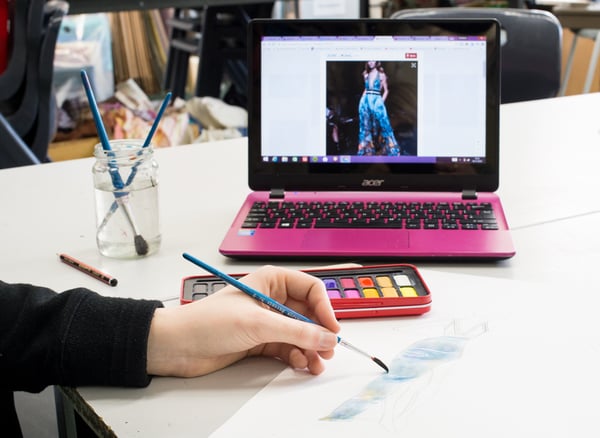
In-school workshops or artist in residence schemes also enrich subject learning and inspire young people. Experts in subject areas that you are exploring can bring fresh thought provoking ideas to get your students even more enthusiastic. Students have the opportunity to connect with practicing artists offering them insights into this career path as well as the wider professional arts sector.
Ofsted recognises the necessity of a ‘broad, rich curriculum’, pledging the importance of delivering ‘real learning’, not just a results focused, test based education. Yet we have seen cuts in funding and the Cultural Learning Alliance has recorded a 38% decline in arts GCSE entries from 2010 to 2021.
Recent reports are starting to point to the hours of arts teaching and numbers of arts teachers are finally stabilising as the benefits of the arts not only in education but also to wellbeing is finally acknowledged. During an era when our students are becoming increasingly stressed, there is no better time to recognise the value of an arts education. Nicolas Serota, CH Chair of The Durham Commission on Creativity and Education summises:
‘At a time when the mental health of children and young people is of concern, there is ample evidence of the value and importance of creativity in supporting wellbeing. Young people can find strength, inspiration, consolation and community in their shared experience of creativity.’
Beyond test scores, we know that an arts education can produce significant positive outcomes both socially and academically. The United Kingdom is a culturally rich country brimming with creativity and cultural diversity with arts and culture contributing £10.6 billion to the UK economy.
Before the pandemic, creative industries employment was growing at twice the rate of the UK economy, and it has been projected that post pandemic, the creative sector could recover faster than the UK economy overall. Recognised internationally as a cultural hub, vibrant with a wealth of arts and culture, the arts industry in the UK still promises bright, fulfilling future career pathways for creative students.
The evidence is clear that Music, Art & Design, Drama and Dance bring tangible, valuable and long-lasting benefits. So what practical steps can you take to bolster the prominence of the arts at your school?
- How to motivate your students to create visual art and get your department noticed
Given all that we have experienced over the recent years with lessons being taught remotely online and many clubs cancelled, now more than ever is the time to make sure that visual art does not fall to the bottom of the school’s priorities list and get overlooked in the pressure to catch up on core subjects.
The Tate explores why arts education is important in their article ‘Why Study Art’ and features students, artists and cultural figures speaking about the many benefits:
‘School in general is so stressful…this is the one lesson I look forward to every week because I know it’s not going to majorly stress me out.’ Student, Three Rivers Academy, Surrey
You may feel that your setting has a fantastic visual arts provision but keeps getting overlooked. Or that the visual arts are less of a priority in your school than you would like and you feel your students’ achievements could be celebrated more.
We have looked at some of the best ways to promote art through your students and get your department noticed.
Artist in residence
Fully funded opportunities for an artist in residence to join your school are an excellent way to help get your department noticed. Stimulating creativity and imagination with new approaches and ideas offered by the artist motivates students and the experience can open their eyes to potential careers in the arts.
An artist in residence initiative can be set up so there are cross-curricular impacts. In this way, other subject leaders can see first hand the benefits that an artist and arts activity can have on their area of the school. This also extends the opportunities to promote your department by making a bigger ‘splash’ with a large, cross-departmental team.
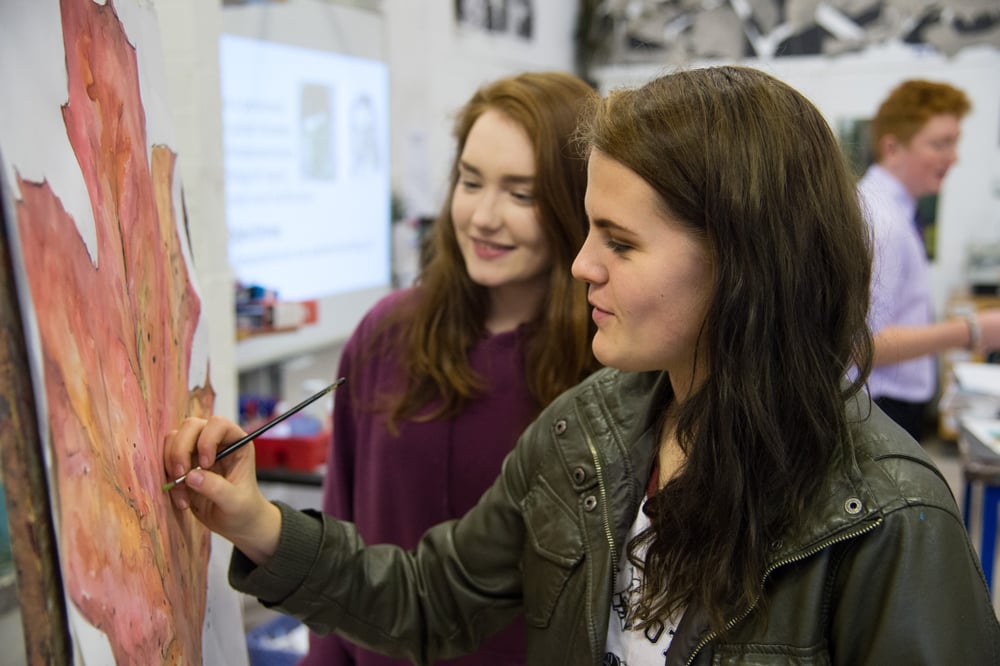
Appreciating arts, culture and heritage is close to the heart of every arts professional and what better way than organising trips and visits to extend understanding of the arts. Museums, heritage sites, exhibitions, galleries, theatre productions and trips to other arts events are valuable sources of inspiration.
With some coordination and pre-planning, a single trip to a cultural venue can benefit a range of subjects - history, English and geography, for example - maximising the impact of the visit. Students can be tasked with critically reviewing their trip which can be used in school magazines and newsletters. It is a great way to develop arts vocabulary as well as learn to express likes and dislikes and explain why - and their review can be used towards an Arts Award . Students can also reproduce what they see which makes for eye-catching school displays.
Of course it doesn’t need to be an actual ‘visit’ to be enriching and inspiring. Many galleries (and arts organisations such as Art UK ) have great digital resources that students can make use of and some museums have placed their entire catalogues online which provide rich resources for research. Whether the experience takes place ‘in real life’ or is virtual, the Arts Award Supporter map can help you to find places nearby that have a specific offer for young people. Sharing your students’ resulting reviews and artworks with a local venue can forge a strong link and may result in the work being promoted through the organisation’s own channels.
One student’s personal view on the value of visual art learning in schools is included in The Tate’s report, Why Study Art :
‘[School is] all very robotic. It’s all very ‘it needs to be this, this and this’. You can’t do this because it is wrong. It’s all following a strict script. That’s not what we’re made to do. We’re made to be our own person, we’re made to go off and do something that someone else hasn’t done before.’ Student, Ark Helenswood, Hastings
The importance of displaying your students’ work
Walls in schools are never in short supply and displaying your students’ work throughout the school is great for their self-esteem and sense of ownership of the art work, as well as showcasing your department. It may seem counterintuitive with less visitors allowed in school due to the pandemic but this means that getting your work seen in as many ways as possible is even more important than ever.
Using your school as your canvas provides a great opportunity to get creative to show your students’ skills where they can be seen and appreciated by staff and other students. Your school courtyard or other outdoor space is often the place where students congregate and is usually an important part of the school’s culture - being in open air makes it a great spot to show off public works like sculptures and murals, the benches are canvases waiting to be painted.
You could task your students with featuring their public works digitally for those who cannot visit the school to enjoy and it will be a talking feature for future open events. You can reach a wide audience by showcasing your students’ work on social media. Twitter and Instagram are both extremely popular and it’s easy to set up a school account on either site for your department.
Getting students involved in compiling an e-magazine devoted to the arts has the potential to pull in a lot of interest and can extend to featuring competitions, and termly or annual exhibitions. You could elect a student body from the sixth form to manage and promote these activities allowing them to develop a host of event management skills - this leadership experience could count towards a qualification such as Silver or Gold Arts Award .
Competitions and partnerships
Receiving accolades for competitive endeavours doesn’t need to be limited to the school’s sports teams. Competitions are a great way to get noticed nationally and within the school community. The Royal College of Art holds an annual exhibition of students’ work aged 8 - 18 years. Travel Photographer of the Year holds an annual competition with a category for Young Travel Photographer of the Year with age categories split into under 14s and 14-18.
There may also be local or regional competitions or festivals students can get involved with. The Arts Council's Bridge organisation local to your school may be able to help supply information.
More widely, it’s worth checking whether your setting is part of one of Arts Council England’s Local Cultural Education Partnerships (LCEPs). These partnerships are a great place to share successes, make new alliances and get support. Associated with the LCEP there may also be a local creative schools network or something similar, aimed at inspiring teachers and collaborating across schools. These networks can prove fruitful in raising your profile and making new connections: A new partnership with another school or arts organisation is something your senior team are sure to be keen to hear about.

- Fun ways to improve drama student engagement
Drama is well recognised for the transferable skills and employability skills it brings young people. Teamwork, confidence, critical thinking and listening, to name a few, are qualities vital to succeed in any aspect of life, and even the shyest of students can flourish in the creative open space of a drama department. With that in mind, it’s important that you promote the benefits of your subject for students and the positive impact that engaging with drama activities can have on the wider school community. We have come up with the most effective ways to grow your department and get it noticed.
Putting on a show
Nothing brings a school more to life than a whole school production. Students who have the opportunity to take part find it deeply enriching and a chance to make new friendships and develop their confidence. School productions can be very inclusive with so many opportunities to get involved, with the benefit for drama teachers of being able to share out some of the heavy workload associated with putting on a show. Students learn and experience how to put on a drama production not just through acting, but through design, directing, writing, promotion and the host of disciplines connected with theatre.
Parents and the local community enjoy seeing the vibrant heart of their school and the school production is talked about long after the last curtain. You can jump on the back of this attention and invite the local press to cover your production. You could also ask a photography student to take photographs which you can share in an online gallery alongside critical reviews written by your students.
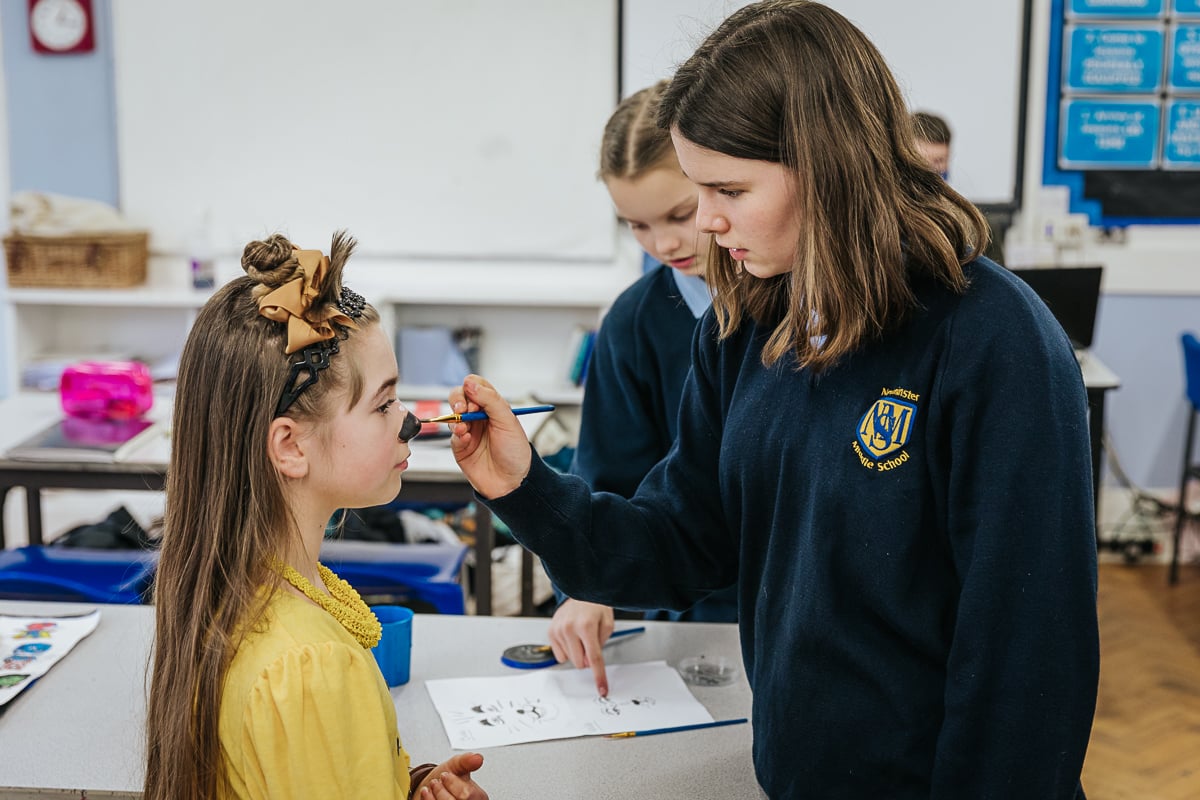
Drama’s link to school development
Anything a department can do to support the school’s key strategic goals is sure to be noticed by senior management and will help to raise the profile of you and your department.
Drama can support whole school aims by working with the careers function in school to support the delivery of the recently published Government’s career strategy . The drama department can organise and run activities that build students’ communication skills which are essential for entry into further education and success in future careers. For example, students could act out typical interview scenarios or the drama team could offer an extra-curricular club aimed at developing students’ communication skills.
Linking with other subjects such as English also connects drama to core learning and can be used to develop communication skills including confident public speaking. Drama can improve voice projection, articulation and persuasive speech as well as listening and observational skills. These can be further developed by playing drama games based around fictitious work scenarios to give students an idea of how to react and express themselves when placed in the real world.
Drama is such a versatile art form which can be used to enhance many other areas of teaching and wider school development. By taking a look through your setting’s School Improvement/Development plans, you are likely to come across a number of wider strategic aims that drama can support. These might range from improving boys’ literacy, to increasing engagement with parents, or from maximising student leadership and voice, to ensuring equality, diversity and inclusion across the school. Greater use of drama as a tool for wider development will gain your subject more exposure and support from leadership.
Offering graded exams
Offering drama graded exams or other assessments that cover the performing arts such as Arts Award enhances the credibility of the drama department with students and parents as students can gain qualifications and even UCAS points. Your senior leadership team will be keen to see measurable outcomes coming from your department as this can support reports for the governors and Ofsted.
Choosing assessments that are inclusive is important to encourage wide-spread participation and support achievement. For instance, less confident students can be put forward for exams if the board you choose offers pairs and group exams .
Chris, Head of Drama at a school in London highlights the benefits of running graded drama assessments for groups:
‘[Drama] students are encouraged to work together in order to achieve their joint goals. A lot of subjects don’t require students to do this or get a grade based on their combined actions within a unit: graded drama exams require collaboration, good listening, and compromise – really adult skills, which should be celebrated.’
Theatre trips bring so much joy and inspiration and it is always fascinating to go backstage and learn about all the employment and volunteer opportunities the theatre has on offer. Seeing a live play can help develop emotional intelligence as students learn the ability to appreciate how others think and feel. Going to the theatre also offers students the chance to see beyond their own perspective, as Adam, an actor and drama teacher, explains:
‘For a lot of children, their first introduction to Shakespeare is sitting in an English classroom reading it – that’s not how Shakespeare is meant to be accessed. No wonder so many people, even into adulthood, hate Shakespeare. What teenager wants to sit down and read this text from a book? I didn’t understand verse when I was 14. But taking a group to see a production of ‘Othello’ and watch it live was amazing. All of a sudden things made sense to them.’
While the excitement of a trip to the theatre will promote your department by itself, you can use the buzz this creates to really get your subject noticed. There are also possibilities for stimulating professional theatre experiences without leaving your school building or town offered by the many live-streamed performances put on by national venues.
Whether the experience takes place in a traditional theatre, pop-up venue or your local cinema, students could write critical reviews for the school magazine, re-enact highlights of the play in an assembly or even write and direct their own mini plays based on inspiration from the theatre trip.
Actors or travelling theatre companies can be invited into school to deliver workshops to inspire your students. There is the potential to extend the experience by arranging a ‘question and answer’ session where students interview the cast and production team. This can contribute to your school’s wider career education strategy, a qualification like Arts Award or similar outcomes.
This can be showcased on your department’s social media feed as well as the school’s main feed; make sure you tag the theatre company so they can see your post and they may share it with their followers. You could invite the local paper to cover the workshop and feature the students enjoying and learning at the same time. Don’t forget to share any coverage you receive with your senior team and governors.

Past students
Keeping in touch with past students is a great opportunity to showcase possible career pathways to your current students. Do you have any past students who studied drama and went on to study or work in a related subject? Drama brings with it a wealth of transferable skills and a variety of career pathways available for those with a passion for the theatre arts, from front of house to marketing.
By demonstrating the range of career options available, you may have an impact on students choosing to continue to drama past Key Stage 3. And your senior leadership team will be keen to see positive proof that theatre is a viable career option and that the skills developed by studying drama are highly desirable for a wide range of future studies and career...
Voice magazine is also a great source of information for aspiring young creatives who can gain inspiration from initiatives, artworks and stories shared by peers. Articles such as ‘Drama is a useless degree’…How wrong you are! demonstrate the transferable skills your subject brings
Festivals and competitions
Drama competitions and festivals are an enjoyable experience for all involved and boost your presence and appeal with students and parents. There are several national drama competitions on offer. Here are some options as a starting point that may be suitable for your school: The National Student Drama Festival offers workshops, debates, masterclasses and opportunities to perform for 16-24 year olds. And there is the Shakespeare Schools festival which is the world's largest youth drama festival bringing Shakespeare to life in schools across the country with opportunities to participate and perform.
You may also want to consider the National Theatre’s Connections programme, a nationwide youth theatre festival which provides students with the unique opportunity to access new works written by some of theatre’s most exciting playwrights and then to stage performances in theatres nationwide. Many towns and cities have arts festivals which are an excellent way to link with the wider community and promote your subject through your students.
- Inspiring design and technology projects the whole school can enjoy
The role of Design & Technology in schools can sometimes be overlooked, but by demonstrating the value of Design & Technology to students and parents you help boost your department’s profile.
Design & Technology hosts a wealth of career possibilities in industry growth sectors and opens doors to jobs that didn’t exist until recently and don’t even exist yet. Young people with an aptitude for maths or science can often thrive with Design and Technology just as much as those with a flair for the arts, and many love the fun of hands-on learning and seeing their ideas become reality. D&T is a popular choice for students across the board and your department can gain profile-raising ‘quick wins’ by connecting with the visual arts and Maths within school.
Tying into cross curricular initiatives helps raise your department's profile and what better than linking science and technology subjects, including physics, maths, chemistry and IT. When it comes to the sciences, having knowledge of how physical and chemical processes work can come in handy when designing different products. Linking with the arts reinforces the planning, design and practicalities D&T brings to the creative subjects.
'D&T prepares its students to participate in tomorrow’s rapidly changing world. Students learn to think creatively and solve problems as individuals and as part of a team.’ Jim Smith, Deputy Head Teacher, Meden School
Engaging in design competitions such as those offered by Neon such as the Big Bang Competition or I’m an engineer, get me out of here! gives students the chance to sink their teeth into real-world, authentic projects as well as demonstrating how broad a design career could be. You need the technical skills to make designs a reality, but these would be nothing without the creative vision and artistic visualisation which sit alongside. And by entering competitions such as these you have an exciting talking point for staff meetings, assemblies and school newsletters as well as social media.
Another great way to raise the profile of design in schools is to engage with topics that spark excitement with your students. Cross-curricular learning can promote the importance of STEAM and how each subject can enhance the learning experience of each other and open up unimagined career pathways. Production and character design is a huge part of the film, TV and theatre industries, and many young people don’t realise that those incredible creatures and sets from productions like Harry Potter, The Mandalorian and even Riverdale were first imagined by a design artist. You could arrange a school trip to a film set or Design Museum and then have students plan and make concepts for school productions or packaging for the school canteen..
‘Design and Technology should be as riveting and relevant as the career it channels into. Logical, creative and practical, it’s the only opportunity that school students have to apply what they learn in maths and science – directly preparing them for a future in engineering.’ James Dyson, Inventor
Thinking more widely, crafts offer a great opportunity to engage students who enjoy the practicality of Design & Technology and also the aesthetics of visual arts. One of the most accessible crafts for schools is textiles as it doesn’t require any specialist equipment. We have seen craft has staged a comeback over recent years and there are many opportunities for textile specialists to make their mark. Yarn bombing around the school, for instance, is a great conversation piece and can be shared virtually, as can tying textiles into other subjects such as geography for ethical fashion or exploring e-textiles in ICT.
Budding fashion designers may be interested in platforms such as Awaytomars that welcomes students to collaborate in an online fashion design platform crowdfunded to produce the best fashion designs selected by the community. Textile students can also get involved in school productions with set and costume designs or even a proposed school uniform design can boost the subject’s presence.

- How to boost the profile of music across the school
Music is traditionally a well respected subject, yet music education is struggling in some settings. Recent reports show that the take up of Music GCSE and A-level is declining and fewer young people are studying music outside of school. Veronica Wadley, chair of the new expert advisory panel for the National Plan for Music Education (NPME) recognised the value of a music education saying:
‘It is so important that every child and young person, from whatever background and area, has the opportunity to benefit from learning to sing and play a musical instrument, improving not only concentration, self-confidence and academic attainment but also raising expectations of what they can achieve in all areas of their lives.’
However, for many young people, their only formal education in music will be through school– and with music being such a powerful tool for students this is a real issue.
Creating bands, orchestras, choirs and other performance groups is a great way to engage lots of students, and the combined voice of so much music-making will raise the profile of your department without trying. Can students do live music for a school production or assembly? Is there the opportunity for a music concert or prom? Can students have access to the music room at lunchtimes or after school to develop their own music which might not fit into the curriculum?
Encouraging students to enter for assessments, exams and music competitions will not only give them an endpoint to work towards, but will give them professional feedback and something to enrich their CV.
The music world offers plenty of opportunities for students to get competitive. For example, the National Concert Band Festival is the UK’s largest wind band and big band festival where students can perform in front of an audience, with adjudicators offering feedback based on the NCBF award criteria resulting in a Platinum, Gold, Silver or Bronze certificate. There is also Young Songwriter Competition is a worldwide competition for young people aged 8-18 whereby students can have their songs heard by a star-studded panel of judges, as well as connect with like-minded peers. Another option is Denbighshire Urdd Eisteddfod 2022, one of Europe’s largest youth touring festivals with over 15,000 young people under the age of 25 competing in various artforms.
Connecting with your local Music Education Hub is a valuable way to forge links with the musical community and access music education services for children aged 5-18. Music hubs bring together music services, local authorities, schools, art and community organisations to make sure all pupils have access to a music education. Both Ofsted and Arts Council England advocate for schools to build stronger relationships with their local music hub and by doing this you will connect the work of your department with the Government's National Plan for Music Education.
.jpg?width=1000&name=Kings%20School%20Worcester%20lo%20res%2017.06.19%20(18%20of%2070).jpg)
Music technology is a great feature of the curriculum which can ensure that your subject has more profile and is recognised for the huge benefits it can bring. It is often a way to engage students who never considered music as a subject they can access, so when you’re next reviewing your music enrichment options, why not consider adding music technology to your range of clubs? Students with an interest in music technology may be well placed to offer support to school productions, acting as a useful point of contact with the drama department.
Composing music for video games is another instant hit with students. Along the lines of creating music for a film, students can compose music for different video games matching mood and style. They could work in groups to plan a short story or action sequence that they can tell with sound effects alone. Other students then have to guess the story.
Rap music is another possible popular genre that could be used to engage students. For younger classes, rapping a name is a fun warm-up. Students could also write a rap about themselves based on a structure and then record a rhythmic backing to go with the rap. They can then record their rap and the backing, and experiment with various post-production effects.
For those schools choosing to embrace the Model Music Curriculum as a framework to support their lessons and planning, between Key Stages 1 and 3 there are recommendations for a wide range of musical activity. This includes singing and listening, music technology, creating graphic scores, musical improvisation, whole class and small group ensemble learning and also dance. You could introduce a qualification such as Arts Award to accredit non-traditional music activities and those for which music grades aren’t currently available. You could even add topics such as music industry marketing for older students.
- Motivating your students to dance
The late Sir Ken Robinson believed that dance is just as important as maths in school arguing for ‘...equity in educating the whole child’ and the ‘equal importance of dance with the other arts, languages, mathematics, sciences and the humanities in the general education of every child.’ Dance is, of course, an art form in its own right that should be celebrated not only for its inherent beauty and creativity but also for the benefits to fitness, coordination, flexibility and wellbeing this discipline brings. However joining forces with the PE department is an efficient way to piggy-back on the promotion and existing recognition sports often have in schools, while partnering with English and Drama for school productions and trips is another way to promote this subject.
Linking with national initiatives and programmes is an effective way to shine a light on your subject and demonstrate its value. The Royal School of Ballet partners with schools in its commitment to the belief that every child and young person is entitled to dance as part of a wider cultural education and their outreach programme is designed to introduce the art form of classical ballet to young people in a creative and dynamic way.
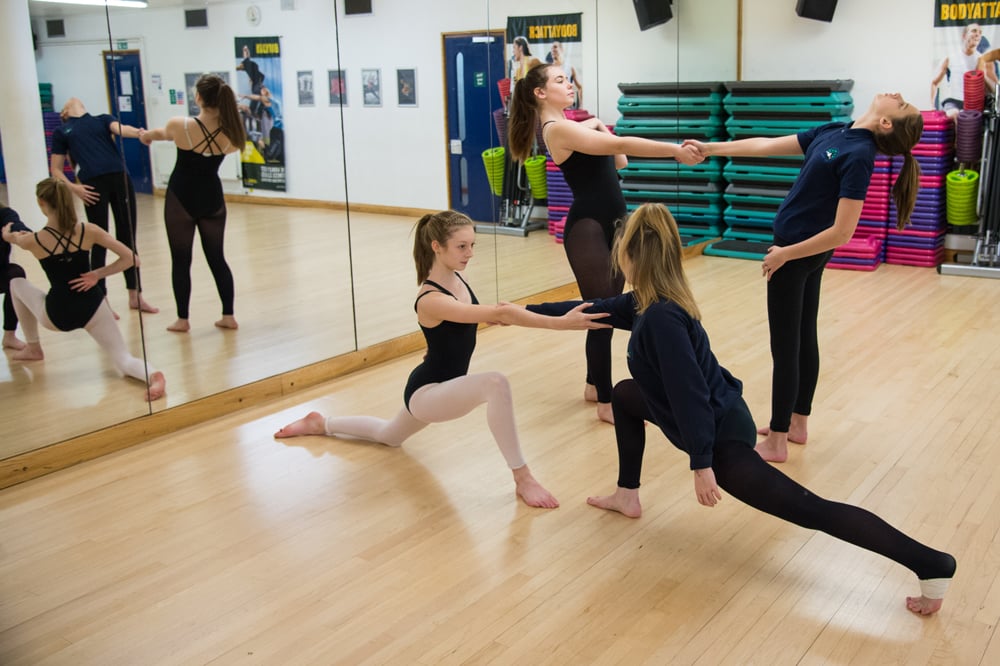
Outside of school, if you have talented dancers, why not signpost them to CATs schools , the Royal Opera House Create and Dance free programme or suggest that they audition for the National Youth Dance Company ? Taking part in activities like these will increase their skills, but also raise the profile of the subject within school as they could be profiled in an assembly, school newsletter and social media.
Young people love to dance and perform and their exposure to social media and music videos has made the latest dance moves common currency with many students. What better way to motivate your students than integrating up-to-date forms of dance into your practice. This could be in the form of the latest crazes on TikTok or even ballroom on Strictly, or through a study of the cultural heritage of dance introducing such practices as Bollywood or K-pop.
While dance remains a subject at risk in many schools there are ways to advocate and retain it as the valuable and wide-reaching subject it is.
- Harnessing cross-curricular connections
Cross-curricular is a creative way to deepen students’ skills, understanding and learning and can be a very motivating and stimulating method of working. Exploring topics through interconnected subjects stretches the imagination and can make for memorable learning.
Companies and charities offer fun ways to combine skill-sets via such activities as The Big Knit , Sony World Photography Awards and The Young Enterprise Scheme . You could, for example, task your older students with setting up cross curricular challenges based around a theme for The Big Knit or a photography competition or even making items for charitable causes . This can be divided into age categories for the younger years and can be shared in school assemblies, social media accounts and newsletters. Your older students may even want to set up a school club where all ages can meet to work on entries to the competition and share skills while having fun.
Linking with other arts departments within the school is a great way to share ideas, get support and jointly advocate for the value of the arts in your school. You will all have your own areas of expertise, and by working together can generate great ideas for eye catching work and rewarding learning. Are there skills you can share with each other, or have certain approaches worked for you in the past you can share?
Using your combined skill and enthusiasm can attract a lot of attention in your school. Whether this is leading a reading week, a cross-genre arts week, school productions, careers events or end of year celebration activities, working together will help to keep your own workload manageable, and role-model team work for your students.
You could work with your colleagues in the English department for a week focussing on the power of language. You could work across year groups with the older students inspiring the younger ones:
- In English, students could create pieces of creative writing
- During Drama, students could bring this creative writing to life
- The Art department could design the sets
- Design can help with props
- Textiles can work on costumes,
- Dance can help with movement and choreography
- Music can develop the soundscape or score
At the end of the week there could be a showcase assembly to celebrate the hard work which can also be shared with parents. The work could also be displayed during open events.
STEM subjects can also be involved with students learning about how to create circuits for the lights used. Maths is involved in the design and scaling of model boxes, and you could even link this to the History department by introducing themes studied in history as inspiration for the texts created in English. You may be surprised at the range of national programmes that have an arts angle, and some may already be enjoying a high level of prominence within your school. The Duke of Edinburgh's Award, for example, has included creating a work of art or music on The Experience List , a list of activities every young person should try and do to build their confidence, resilience and independence.
- How students can help raise the profile of arts education in schools
Students who enjoy your subject and teaching are the most powerful advocates for your department. If the opportunity is given, they will passionately speak about the changes your arts education has made to their school experience and life. Sienna James who achieved Bronze, Silver and Gold Arts Awards explains in an article for Voice magazine how students’ voices can help teachers to raise the profile of the arts in schools.
Enabling your advocates to share their experience is a highly effective way to promote your presence whether at assembly, school open day, as part of a showcase event or performance, even at a staff or governors meeting. They can highlight particular differences your subject has made to their life, to their achievements in other subjects and to their further education or future career choices.
Sharing arts enrichment activities of Key Stage 5 students is a superb way to inspire younger students and cascade awareness and excitement for your subject throughout the school. The exhibitions, performances, artforms and portfolios order students produce are outstanding in their own right and promoting their work will promote you. Beckie Voller, Ignite Leader for Arts at St Bede’s and St Joseph's Catholic College explains how this works in the case of her Gold Arts Award students:
‘Gold Arts Award increases the profile of your department and makes it more visible. It’s lovely to see the older students work with the younger students, showing them what they have done for their Gold. You see the younger ones looking at the older students' work and thinking ‘I want to do that'.’
You could encourage your older students to form a Student Arts Council made up of keen representatives drawn from across the school. What is better than a group of enthusiastic arts appreciators gathered together to create great visual art and promote their work and your department across the school and wider community. They can inspire fellow students, deliver whole school art projects, get involved with decision-making within the department, run assemblies and be your very best advocates.
You could also encourage them to organise a whole school Arts Week to showcase work and talent by bringing together budding artists, musicians, actors, singers for an inspirational week’s celebration of the arts (and your department) in school.
The benefits of accrediting the arts
Arts-based accreditations, including assessments, qualifications and awards, can provide structure and cohesion for efforts to bolster the profile of the arts in school, as well as the motivation of a goal to aim for.
Benefits to arts departments
Whether you’re seeking to accredit arts provision across the whole school or recognition of individual students’ achievements, qualifications and awards provide tangible, measurable results which are likely to be particularly influential with senior leadership teams, especially if the outcomes can be linked to wider school priorities and support your School Improvement Plan.
Benefits to young people
Supporting students to work towards assessments in creative subjects alongside their core studies is common practice in schools. It’s a way of motivating and engaging learners, and the arts can provide a safe space to share interests with like-minded individuals and build connections. Students also gain a variety of transferrable skills that will benefit them greatly in the future. When it comes to preparing young people for the next step in their education or employment journey, arts-based assessments and awards can offer students experiences and qualifications that will aid the transition. Awards and qualifications can additionally offer access to opportunities and experiences that students may not otherwise have access to, raising aspirations and supporting cultural capital.
There are many options open to schools looking to accredit their arts provision or particular aspects of their arts offer. Graded music or drama exams are frequently run within schools, or schools may aspire to the quality standard set by Artsmark . Arts Award is another option for schools looking for flexibility and ways to link their arts teaching with the schools’ careers strategy and wellbeing agenda.
How Arts Award can benefit your school Arts Award is a range of unique qualifications that supports anyone aged up to 25 to grow as artists and arts leaders, inspiring them to connect with and take part in the wider arts world through taking challenges in an art form - from fashion to digital art, drama to dance.
'In our school, we offer a broad arts curriculum and we felt that a lot of our students were already participating in lots of additional things, so Arts Award would be a really good way to recognise their achievements. It gave them a structured programme in which they could be working on areas that they love.' Director of Learning (Visual Arts)/Arts Coordinator, Sandringham School
How does it work?
Through progressing through the Arts Award levels, young people get to:
- discover the enjoyment of creating and participating in arts activities
- experience arts events
- develop creative and communication skills that are essential for success in 21st century life
- explore the work of artists and craftspeople and gain insights into the professional arts world
- gain experience and knowledge to help progress into further education and employment
There are no entry requirements, no time limit for completing the award, and no set rules on how to present final work.
Arts Award’s flexible framework means it can fit around a wide range of arts, cultural and heritage activities and projects, including creative and technical roles. It can be delivered in many ways and in a wide range of settings. You can map it to your existing activity or use it to kick-start something new. Arts Award delivery happens in curriculum or extra-curricular programmes and enrichment options, museum or heritage projects, weekly clubs or groups, and partnership projects.
'Whatever your curriculum or extra-curricular programme, Arts Award can map to what you are already doing. Accredit your KS3 activity and provide opportunities for older students to develop their leadership skills and gain additional UCAS points through the flexible Arts Award format.' Rachel Shann, Assistant Head and Arts Award adviser, Kingsmead School
- Benefits of accrediting the arts

- Accessibility
- © 2024 Trinity College London

A Better Argument for Art Education
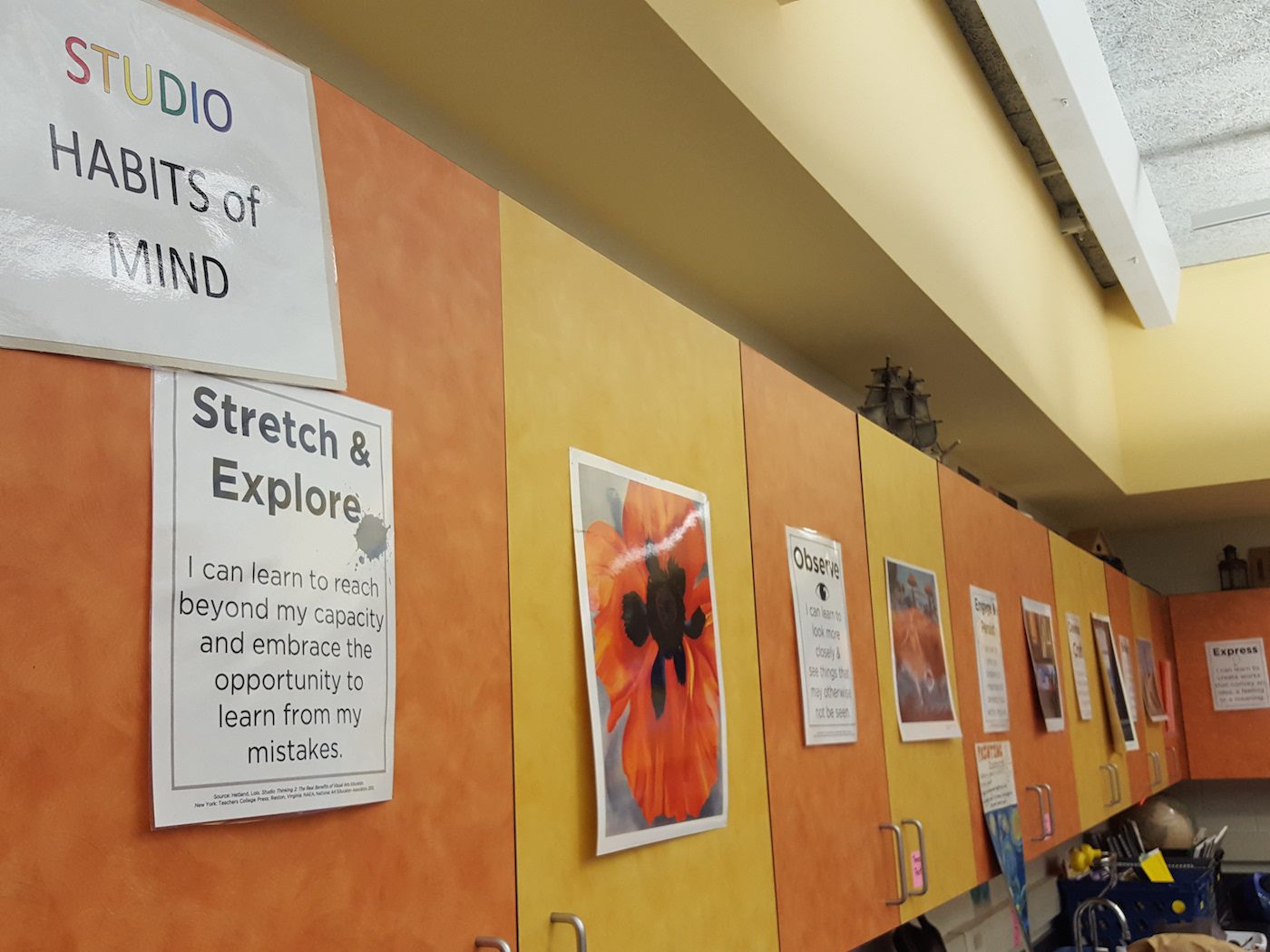
These days, it sometimes feels art education is under attack. The culture of high-stakes testing has increased over the last decade. In this climate, art educators need to justify our programs more than ever before. How can we help people understand why art education is important?
We’ve all seen the data suggesting students who take art classes have higher SAT scores. It is an argument used often to defend our place on the educational landscape. “Kids who take art classes receive higher standardized test scores.” “Art students have higher GPAs than students who do not take any art classes.” These are common arguments for the importance of art classes.
The thing is, these arguments miss the point. The arts are valuable. They should be an important element in any well-rounded education. The importance of art education does not lie in its ability to raise test scores.
Here is why we need to change our argument for the importance of art education.
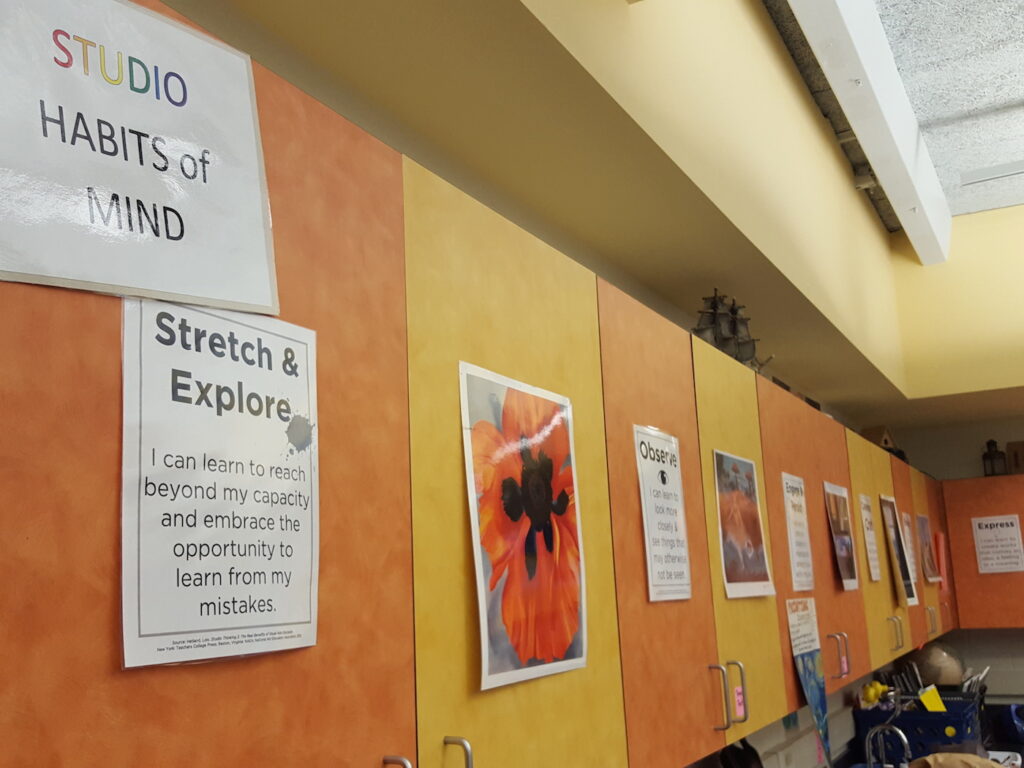
There is only a correlation between test scores and art classes.
A correlation means there is a connection between two things. But it doesn’t mean we know why that connection is there.
If you remember statistics class, you know there is a big difference between correlation and causation . Just because there is a connection (correlation) between art classes and test scores, it does not mean the arts are the cause of the increased scores (causation).
Students who take art classes may already be high achievers. Or perhaps students with lower GPAs are not taking art classes because their schedule is filled with remedial academic classes. There just isn’t data to support the idea that arts classes actually cause higher test scores or GPAs.
By arguing the arts increase scores on standardized tests, we are missing the point.
If art education’s only importance were to increase scores in other subjects, then why not just cut art entirely? Then schools could increase math or science instruction time.
Did that give you chills? Yeah, me too. Because when we frame our argument only around test scores, it opens the door to this bleak option.
Art education has many unique qualities. Students develop skills in art that help them find success in many other areas of life. These skills help students well after the tests and schooling are done. The argument that our classes help students achieve higher test scores distracts from the true value of art education.
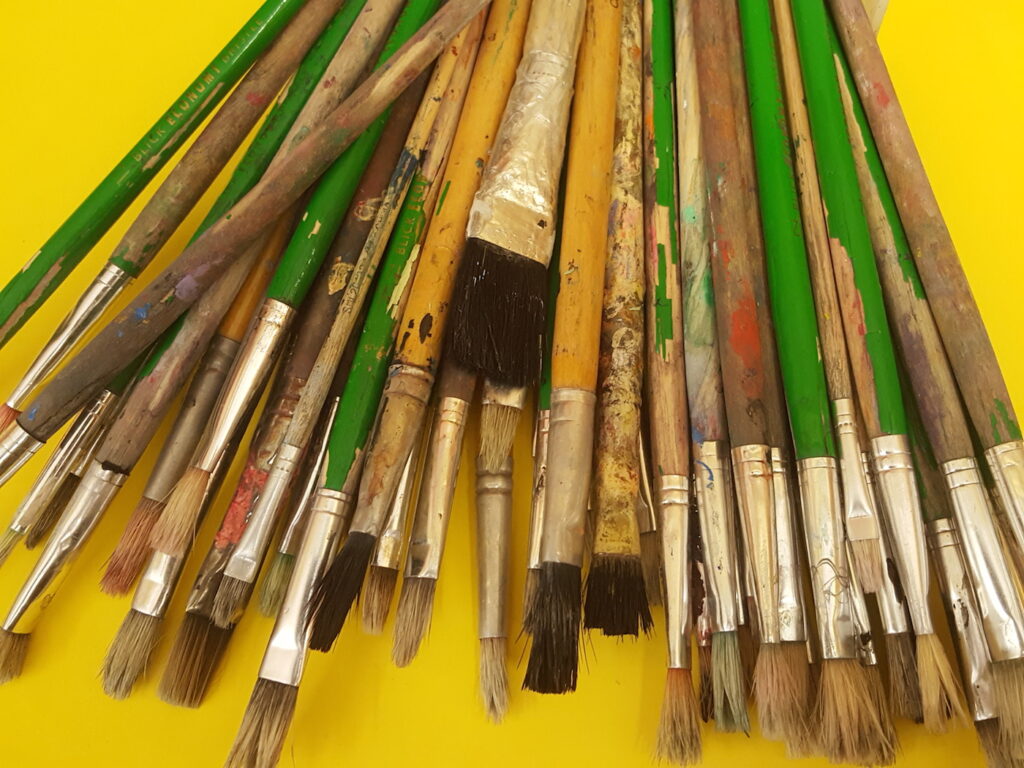
So, what should we be saying instead?
Instead of explaining art’s value to other disciplines, we should be focusing on the unique qualities of art class. There are many examples of valuable skills taught in art.
Art develops unique “habits of mind.”
Harvard’s Project Zero developed the Studio Habits of Mind nearly a decade ago. These habits develop naturally when engaging in art-making.
These habits of mind provide art educators with a strong framework outlining the unique skills developed in art class. These habits include the ability to:
- Develop Craft
- Engage & Persist
- Stretch & Explore
- Understand Art Worlds
These habits transfer to many other areas of school and life. They are also highly valued by employers.
Art builds students’ capacity for critical thinking, self-directed learning, and problem-solving.
Critical thinking and problem-solving are alive and well in the art room. The process of analyzing and creating art challenges students to develop these skills. Art students are given open-ended problems to solve. This encourages them to think critically to solve problems in their own unique way.
These skills transfer to many other areas of life. And they cannot be assessed on a standardized test.
Art helps students understand cultures beyond their own.
We live in an increasingly global world. It is important for our students to leave school with a broad understanding of the world and its cultures. Art classes expose students to art from all over the world. This exposure helps them understand our shared humanity. The study of art history also helps highlight the issues of the past and the present.
Art develops communication skills.
When art students analyze an artwork, they use art vocabulary to express their ideas. Discussions about art build students’ capacities to listen to and learn from one another. When a student creates an artwork, they make careful choices to communicate their ideas. And when reflecting about art-making through artist statements, students are further developing these skills.
Art activities consistently rank highest on Bloom’s Taxonomy.
I often attend professional development meetings with colleagues from other disciplines. In these meetings, I hear leaders encourage teachers to hit the higher levels of Bloom’s Taxonomy in their lesson plans.
In art class, we are always engaging our students in these highest levels of thinking. Art students are analyzing, evaluating, and creating every day. High order thinking is naturally present in art classes.
As art educators, it is important to articulate why our class is important. We all know the value of art for our students. We need to communicate this value to our stakeholders.
We do not need to justify art in relation to other disciplines; art class has its own qualities, and we need to share why those qualities are so valuable.
How do you communicate the value of art education to your community?
What other arguments for art education did we miss?
Magazine articles and podcasts are opinions of professional education contributors and do not necessarily represent the position of the Art of Education University (AOEU) or its academic offerings. Contributors use terms in the way they are most often talked about in the scope of their educational experiences.

Anne-Marie Slinkman
Anne-Marie Slinkman, an elementary school art educator, is a former AOEU Writer. She is passionate about providing relevant and meaningful art experiences for all students.
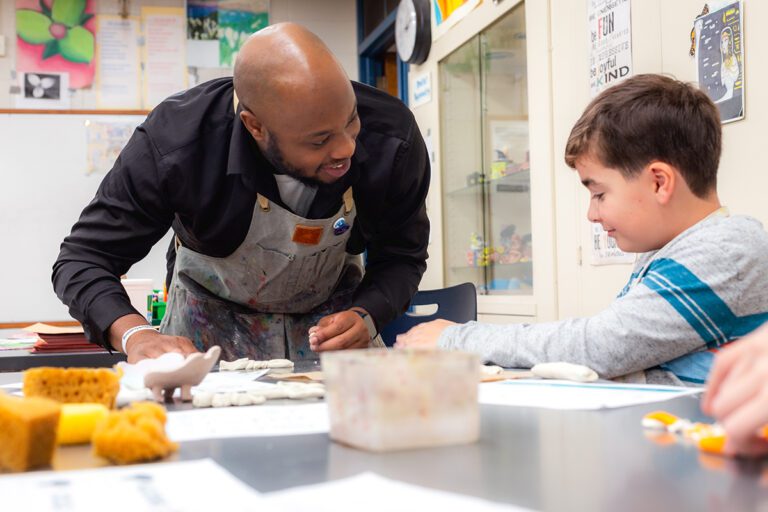
Why Art Teachers Stay: A Guide for Longevity in Art Education

15 Genius Ways to Advocate for Your Art Program During Youth Art Month (YAM)

How to Harness Data to Confidently Advocate for Your Art Program: State of Art Education 2024

12 Ways Your Nontraditional Art Background Prepared You To Teach Art
The importance of the arts in meaningful education.
The arts have long been perceived as a desirable add-on to teaching and learning, but not central to curriculum or schooling. All too often arts education is cut during economic hard times. What has led to this "dis-integration" of the arts from schools?
When I was a child in Chicago in the 1950s every classroom had a piano, and every teacher knew how to play it. Including the arts in teaching and learning was assumed and even taken for granted; but budget cuts, a "back-to-basics" movement, and a mania for reducing all education to maths and reading test scores has eviscerated arts education in public schools across Australia, and all over the United States.
Why should we care? There are the usual reasons: arts education is necessary for educating the whole child as part of a well-rounded education. The arts form the enduring legacies of all civilisations. The arts provide insight into the cultures of other periods and geographies. Arts education introduces talented students to career options. The arts bring beauty and joy.

Arnold Aprill asks what has led to the 'dis-integration' of the arts from schools.
While all these are true, in an information age dependent on innovation, creativity and a constantly changing body of knowledge, there is much more at stake. We live in a world of radical shifts in populations, identities, and cultures, of massive amounts of ever evolving, hyperlinked information, and of distributed means of cultural production. Learners are not only consumers of culture they are producers of culture. The arts are one of the few places where a wide range of learners can make meaningful choices about their own learning. The arts are essential arenas for young people to develop their capacities to manage change, to collaborate with others, and to participate in and make contributions to their communities. We live in an image-based world where the ability to shoot and edit video is as powerful a force in global communication as the ability to write and edit text.
Young people are not, as is commonly assumed, disengaged from the arts. They are deeply involved in the arts - just not in our educational institutions. It is our schools that have become disengaged - and they will need to catch up with our students if we don't want to see our children's hunger for learning and expression continue flowing out of our schools like water through a sieve.
And while young people may be endlessly resilient and resourceful, there are inequities in who gets access to the arts. This is simply unjust. This is aesthetic apartheid. And our access needs to be about more than young people becoming audiences to the arts. We need to move from narrow concepts of arts access to broader concepts of democratic participation in the arts - in which our students not only become informed audiences, but also, as Harvard scholar Howard Gardner has suggested, critics, composers, and performers.
The arts, like reading and writing, are not only about content knowledge or even skill development. The arts are not simply another fish in the curricular sea. They are the water we swim in. We would never consider limiting the teaching of reading and writing to future Booker Prize awardees, but we often act as if arts education is only for the gifted and the privileged. But the arts are for everyone, not just those of us who think of ourselves as creative. They expand everyone's options for thought and perception. They are modes of expression that cross all disciplines, and are the birthright of all learners.
In Chicago an organisation called the Chicago Arts Partnerships in Education (CAPE) has, for over two decades, been studying what happens when the arts are placed at the centre of public education. Classroom teachers, arts teachers and visiting artists have collaborated in over 130 Chicago Public Schools to connect arts learning to learning across the entire public school curriculum. Sculptors work with geography teachers to investigate concepts of mapping. Dancers work with science teachers to represent natural phenomenon. Actors work with social studies teachers to explore historical conflicts. Video artists work with students to interpret literature through animation. CAPE's website documents research about and examples of effective arts-integrated classroom practice. Teachers are re-invigorated, students are re-engaged, arts teachers and visiting artists form collaborative relationships with classroom teachers, and parents and community members become involved in the life of their neighbourhood schools.
All too often we hear teachers and parents, policymakers and administrators bemoaning the challenge of chronic educational problems: "Our students are too apathetic, our teachers are uninspired, our communities are disengaged." This makes those of us involved in sustained arts education partnerships in Australia and the US feel like pulling our hair out. Pioneering arts education partnerships among a wide range of artists, schools, and communities in both countries have already developed an evolved set of strategies for actively addressing these "unsolvable" problems. I have been privileged to become part of emerging exchanges between promising practices in both countries. A richer discourse needs to be established between those who bemoan the state of public education and those who have placed the arts at the centre.
Arnold Aprill is the Founder and Lead Consultant for the Chicago Arts Partnerships in Education (CAPE). He is working as a Fulbright Senior Specialist with the University of Sydney, the University of Tasmania, and the University of Melbourne.
Putting the Arts at the Centre of Curriculum and Schooling , a Sydney Ideas lecture, co-presented with the Faculty of Education and Social Work .
Related articles
$100,000 writer in residence fellowship to combat obesity.
Expressions of interest have opened for a $100,000 Writer in Residence Fellowship to join the fight against obesity, diabetes and cardiovascular disease.
Draft plan to bring SCA onto main campus
The University has released a draft change proposal that aims to fulfill a vision to bring SCA into the Faculty of Arts and Social Sciences (FASS) to Camperdown/Darlington campus.
Margaret Harris to be Acting Dean of SCA
Professor Margaret Harris, the former Acting Dean of the Sydney College of Arts, will resume the role, taking over from Professor Colin Rhodes who has decided to move to a new role after 10 years.
The Importance of Arts Education Essay
- To find inspiration for your paper and overcome writer’s block
- As a source of information (ensure proper referencing)
- As a template for you assignment
Introduction
The importance of teaching arts education.
Art has been in existence for since the beginning of human civilisation. The field, in most cases, is viewed as a way of action and knowing. Art has played a key role in the development of human identities. It has also been significant to the evolution of cultural practices in all human societies. Consequently, art is regarded as one of the defining elements of humanity. To some advocates of this field, art is believed to be the window to the soul of humanity. According to Nathan (2008), art is used to communicate and provide a framework for the understanding of passions, emotions, and the enduring conflicts that humans have always indulged in. The scholars who advocate for the centrality of arts in the development of humanity observe that even the cavemen recorded their history, experiences, and events through drawings of pageants that marked the passing of time and seasons (Anderson, 2014).
In this paper, the author explores the importance of art its contribution in the development of cognitive and cultural attributes among children. To this end, the author will demonstrate that art provides human societies with lens through which they can view both historical and contemporary issues. Finally, the paper will be used to support the argument that teaching art processes can improve the ability of students to shape the learning process and the way it is conceived in schools.
Arts in Traditional and Contemporary Societies
Arts are a common feature in both traditional and modern societies. In most traditional communities, trumpets and drums were used to herald the commencement of battle. In addition, birth and death in these societies were received with songs and dance. Consequently, theatre was viewed as an avenue through which solutions to dilemmas faced by mankind were provided. It can also be observed that in most communities, the portraits of heroes, kings, villains, and other important figures in the society were painted to record these particular moments in time ( Learning area, n.d).
To recognise the centrality of arts to experiences among humans, the Universal Declaration of Human Rights was adopted several decades ago ( The future of the Australian curriculum, 2014). The declaration observed that everybody has a right to participate in the cultural life of their community. In addition, each person should be able to enjoy and share arts in the scientific advancement of its benefits. In the western world, arts subjects have been neglected and pushed to the periphery of the academic field in favour of the sciences. The curriculums used in most schools focus on literacy, sciences, and numeracy. However, in the last few decades, the intrinsic values of arts have been recognised (Ross, 2014).
According to some advocates of this field, arts have the ability to release people’s imaginations to new perspectives. In addition, they can help people identify new solutions and alternative views to life. As a result, the vistas that could be opened, as well as the connections that could be made, are phenomenal. It is also noted that the encounter between the individual and the world around them would be newly informed with the help of arts. In addition, immersion in arts has been found to improve individuals’ sense of enjoyment and identity. The immersion can also offer positive changes in the direction taken by the life of the individual (Anderson, 2014). In most cases, it is argued that arts can transform learning in education contexts. They can also ensure improve the link between the learners and the curriculum.
A Working Definition of Arts
There are many ways through which arts can be defined. According to Bamford (2006), arts can be used to reflect the uniqueness of the cultural circumstances of a particular nation. Bamford (2006) further observes that art is characterised by fluidity and dynamism. In their attempts to arrive at a working definition of arts, Bamford (2006) recognises the impossibility of giving static definitions to this field. The reason is that the definitions become obsolete as soon as they are provided. As such, scholars should be conscious of the dynamism of contemporary art practices. In addition, the art terminology can be used to represent the important creative disciplines. The disciplines include dance, literature, drama, music, visual arts, film, as well as other forms of media arts. All these disciplines have a significant role in formal education contexts. They also play a significant role in the cohesion of the community.
The forms of art described above can be viewed as a representation of different languages. Their varying modes are used to communicate a wide range of skills, knowledge, and symbols. In light of this, it is imperative to study each form of art (Burton, 2010). Each form of art should be explored for its intrinsic values. The reason is that each of them has different ways of creating knowledge and improving communication (Sinclair & O’Toole, 2008). The various forms of art should be viewed and understood as different types of literary elements. However, it is important to note that all of them involve some kind of design, experimentation, play, provocation, and exploration. In addition, they entail expression, communication, representation, and visualisation. All these elements are used to shape other forms of media (Ross, 2014).
Developmental Benefits of Arts
Arts play a significant role in the development of a child’s motor skills. For instance, most of the motions involved in the creation of art, such as scribbling with a pencil or a crayon, are important in the development of fine motor skills ( The future of the Australian curriculum, 2014). Participation helps learners to improve their skills in mathematics and reading. It also improves one’s cognitive and verbal competencies. According to Burton (2010), engaging in arts has a positive correlation with verbal capabilities. Learning these subjects is also associated with an increase in levels of motivation and enhanced confidence. It also improves concentration and teamwork among the learners ( Why art matters, 2011).
Many scholars observe that the intrinsic pleasures derived from arts entail more than just the ‘sweetening’ of a person’s life (Burton, 2010). Such experiences help to deepen the connection between the individual and the world around them. They also provide them with new ways to view the world. The development lays the foundation for strong social bonds and improved cohesion in the community. A strong programming of arts within the curriculum also helps to close the intellectual gap that has made many children lag behind in intellectual achievement. It is noted that the children from affluent backgrounds are exposed to arts through visits to museums and attending Mozart concerts and other platforms. As a result, their interaction with the arts is assured regardless of whether or not the subjects are provided in their schools. However, teaching arts in schools provides children from poor economic backgrounds a level playing field (Nathan, 2008).
Arts Education and Academic Achievement
A new picture is emerging in the new educational era. School districts have started to focus on the field of arts. The emerging models are anchored on new brain research findings and cognitive development. The new models have embraced a variety of approaches that regard arts as a significant learning tool. For instance, musical notes are increasingly being used to teach fractions (Nathan, 2008). The models have also incorporated arts into the teaching of the core classes. For example, the teaching of slavery and other historical themes can be delivered by having the students act a play that dramatises those events.
In the US, Australia, and Europe, it is widely acknowledged that the students exposed to a learning process embedded in arts achieve improved grades and better test scores compared to those who are not exposed to this field. The students are less likely to play truants. In addition, they are rarely bored and have a healthy and positive self concept (Marshall, 2010). They are also most likely to participate in community service. Nascent studies have demonstrated that learning through arts can improve educational outcomes for other academic disciplines (Burton, 2010). For instance, the studies have observed that the students who partake in drama and music attain higher levels of success in reading and mathematics than those who do not take part in such ventures. Consequently, arts are seen as strategies to engage difficult students. The subjects connect learners to self, others, and the world. Engaging in arts also helps the teacher to transform the classroom environment. Most importantly, it challenges the students who may already be successful to work harder (Burton, 2010).
Specific Connections
Experimental evidence demonstrates a strong link between non-arts and arts skills. For example, I carried out an experiment on 10 children who were involved in a family theatre program. The program demonstrated that an exposure in theatrical activities for a year improves the empathy and emotional regulation among the children. For the adolescents involved in a similar program, it was shown that arts helped them improve their empathy. It also improved their understanding and appreciation of the mental status of other participants. The linkage makes sense to the advocates of arts education (Marshall, 2010). Training in arts, acting, and theatre puts the participants in other people’s shoes. The experience helps them to imagine how other people feel. In addition, it enables them to understand their emotions and view the world differently. After undertaking the program, I concluded that students should be given the opportunity to study arts in school irrespective of whether or not the subjects have discernible positive effects.
Cognitive Benefits of Arts
The cognitive benefits that are derived from arts include the development of skills needed in learning, improvement of academic performance, as well as enhancement of reading and mathematical capabilities. In addition, arts improve creative thinking among the learners (Marshall, 2010). The experiment mentioned above also showed that participation in theatre helped students from low socioeconomic backgrounds improve their academic performance. Consequently, I can conclude that the effects of arts education are transformative. The effects hold true across the socioeconomic divide. The impacts are cumulative and increase as the students from poor background get more exposure to the study of arts. It can also be emphasised that the students who are exposed to arts had better scores, which are higher than those of learners who are less engaged. The scores are especially better in such educational areas as creative thinking and originality (Burton, 2010).
The Benefits of Arts with Regards to Behaviour and Attitude
The study of arts has a positive impact on the attitudes and behaviour of the students. The benefits of behavioural and attitude change include improved self-efficacy and self-discipline. The advantages are easily associated and directly linked to improved school attendance, as well as reduced rates of drop-outs (Burton, 2010). In addition, the benefits are associated with the development of social skills. Such social and life skills include better understanding and appreciation of the consequences of an individual behaviour. The students also portray an increased ability to participate in teamwork, acceptance of constructive critiquing from fellow students, and the willingness to adopt pro-social behaviours.
Health Benefits of Arts Education
I must recognise that art has many health benefits. The therapeutic effects include improved physical and mental health. In Australia, the benefits are beginning to be recognised with several ongoing projects in schools reporting positive outcomes. It is argued that people who engage in relaxing activities, such as reading a novel, playing a musical instrument, painting, or singing, develop a healthy mind ( Why art matters , 2011). It is also observed that people who enjoy attending a good concert, a dance, a movie, or an art exhibition exercise their body and mind through the enjoyment, social inclusion, and relaxation. The individuals also improve their confidence, resilience, and self-esteem (Marshall, 2010). An art-mental paradigm can deliver significant health benefits to the students at school and in their adult life.
Arts Education in Australian Curricula
There are three different approaches to the learning of arts in Australia. The first can be described as the appreciation of Australian arts heritage. In this approach, the field is conceptualised as a domain for the talented. The approach points to the belief that the talented artist will provide the Australian society with its cultural artefacts ( Learning area , n.d). The second approach is the identification of the students who demonstrate artistic potential. The teachers focus on these learners and prepare them for future careers. The third approach is the desire to avail every student with an opportunity to engage with art and to appreciate it (Marshall, 2010). As such, the Australian curriculum anticipates that the students will actively learn, engage in artistic activities and processes, as well as appreciate the works of art done by others.
It must be remembered that the role of arts is to enhance learning by increasing enjoyment, fostering creativity, and enhancing imaginative activities. The objectives can only be achieved through participation in arts programs. It is also observed that students become more cognisant of the larger spectrum of world experiences by engaging in this field. The role of arts is to transform the students’ learning experiences by celebrating creativity. As such, teaching of arts should be encouraged and promoted at all levels of learning. Every student should be provided with the opportunity to participate in arts so as to improve their academic performance and develop into healthy adults with enhanced social skills.
Anderson, M. (2014). Why this elitist attack on arts education is wrong . Web.
Bamford, A. (2006). The wow factor: Global research compendium on the impact of the arts in education . Berlin, Germany: Waxmann Verlag.
Burton, B. (2010). Dramatising the hidden hurt: Acting against covert bullying by adolescent girls: Research in drama education. The Journal of Applied Theatre & Performance, 15 (2), 255-278.
Learning area. (n.d). Web.
Marshall, J. (2010). Five ways to integrate: Using strategies from contemporary art. Art Education, 63 (3), 13-19.
Nathan, L. (2008). Why the arts make sense in education. Phi Delta Kappan, 90 (3), 177-181.
Ross, M. (2014). The aesthetic imperative: Relevance and responsibility in arts education. New York: Pergamon.
Sinclair, C., & O’Toole, J. (2008). Education in the arts: Teaching and learning in the contemporary curriculum: Principles and practices for teaching. South Melbourne, Australia: Oxford University Press.
The future of the Australian curriculum: The arts: A response to the review of the Australian curriculum . (2014). Web.
Why art matters . (2011). Web.
- "The Human Side of School Change" by Robert Evans
- Supervisory and Its Relationship to Change
- Art Education Principles Analysis
- Discipline and Managing Behavior in the Classroom
- Visual Arts in Australian Secondary Education
- "Assessment Balance and Quality" by Commodore et al.
- Cognitive Coaching: A Foundation for Renaissance Schools
- Teaching and Research Philosophy
- The Culture of Smartness in Education
- Inclusion Aspect in the Modern Early Childhood Education
- Chicago (A-D)
- Chicago (N-B)
IvyPanda. (2020, October 22). The Importance of Arts Education. https://ivypanda.com/essays/the-importance-of-arts-education/
"The Importance of Arts Education." IvyPanda , 22 Oct. 2020, ivypanda.com/essays/the-importance-of-arts-education/.
IvyPanda . (2020) 'The Importance of Arts Education'. 22 October.
IvyPanda . 2020. "The Importance of Arts Education." October 22, 2020. https://ivypanda.com/essays/the-importance-of-arts-education/.
1. IvyPanda . "The Importance of Arts Education." October 22, 2020. https://ivypanda.com/essays/the-importance-of-arts-education/.
Bibliography
IvyPanda . "The Importance of Arts Education." October 22, 2020. https://ivypanda.com/essays/the-importance-of-arts-education/.
Connect with us to understand how we can help you.
State* Andhra Pradesh Chhattisgarh Delhi Gujarat Haryana Himachal Pradesh Karnataka Madhya Pradesh Maharashtra Odisha Punjab Rajasthan Tamil Nadu Telangana Uttar Pradesh Uttarakhand Others
- Solution Products* School Loans Smart Learning Maths and Science labs Digital Smart Classroom School ERP and Fee Management Integrated Curriculum Solution School Bus Insurance School Uniform
- I authorize Varthana to connect with me over call and WhatsApp overriding my registration with NDNC

- Board of Directors
- Our Investors
- School Solution
- VCARE – Varthana care for you

Arts education in the classroom: 7 reasons why it’s important
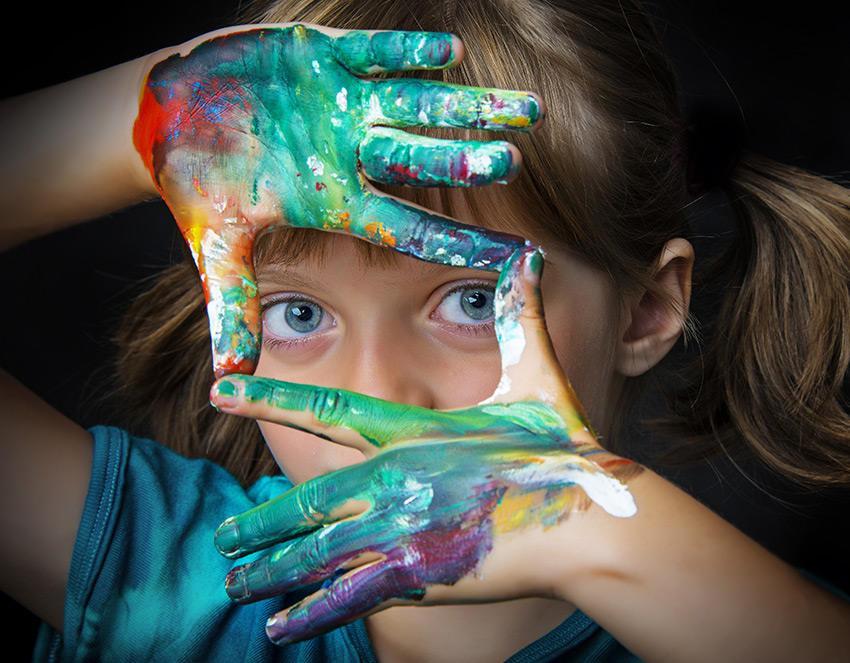
- by Team Varthana
- Posted on January 6, 2023
- in Classroom Management
Although there’s a lot of information available on how important arts integration is in creating well-prepared learners and leaders, a lot of institutions consider arts education a luxury and skip it from their curriculum in order to focus on or complete the syllabus.
However, there is also a visible trend of many other schools turning their focus onto overall student development, with art being an integrated part of the curriculum. Arts education helps students think outside the box and explore topics in an unfamiliar way.
What is Art Education?
Students who receive an arts education have access to a creative outlet that can help them solve problems more effectively. It encompasses a variety of disciplines, including drawing, painting, sculpture, music, theater, dance, photography, and digital media. They acquire the ability to think creatively and approach subjects in different ways while also fostering their cognitive, emotional, and social development.
Significance of Art Education in Students’ Lives
1. creativity.
Art enhances creativity, which in turn fosters problem-solving skills. By participating in arts and learning activities, children develop confidence in their abilities and learn new things. Arts also promote risk-free exploration, and it is this freedom that inspires confidence. It allows children to see things from their viewpoint.
For instance, Students tasked with creating a mural for their school use their imagination to design a piece that represents their school environment or community. This project encourages them to think outside the box and develop original ideas.
2. Improve Academic Performance
Students who study arts show improved language, reading, and math skills, as well as a greater ability for higher-order thinking skills such as analysis and problem-solving. Students also develop skills such as resilience, courage, and an improved mindset to help them learn professionally, perform well academically, and have a successful life after high school. Learning art is not only through creativity but also improves learning in fields such as mathematics and science and in the field of literature. Any skill that students learn through art education allows them to apply the same in academics, resulting in improved academic performance.
For example, when a student learns to play an instrument, they are not just developing their reading comprehension skills but also enhancing spatial-temporal skills, which are crucial for understanding complex mathematical concepts.
3. Self-Reliance
Students become self-reliant when they start depending on their own strengths, knowledge, skills, and resources rather than the strengths of others. Creating art can confirm one’s uniqueness while also providing a sense of accomplishment and self-esteem. Furthermore, arts education has been proven to support a sense of social identity, encourage goal-directed behavior, and increase social resilience.
For example, offering access to a variety of resources, such as art books, online tutorials, and materials, and encouraging students to pursue independent research projects. A student interested in digital art might explore different software programs and techniques on their own time.
Also Read : How teachers can use the best tools and resources available to create a modern classroom?
4. Teamwork
A unique approach to teaching teamwork and communication skills is the use of visual , and performing arts. The larger the creative team, the more valuable the art project is for open-minded people who are willing to learn, expand, integrate, and succeed.
Collaboration creates a sense of comradeship and belonging to the community as young artists work towards a common goal. Researchers have found that students who worked collaboratively on an art project and engaged in a discussion were more thoughtful than those who worked alone.
For example, a theater production requires students to work together, from actors and directors to set designers and stagehands. This collaborative effort teaches them to communicate effectively, resolve conflicts, and appreciate teamwork.
5. Decision-Making
Art education is how children can be encouraged to choose their own subjects, colors, and interpretations of art. This allows children to make their own decisions in various areas of life. It will open up children’s imaginations and ensure that they have plenty of time to practice their decision-making skills. They may make mistakes, but they will learn to overcome them and move on from their failures. This will help the child develop the courage to make decisions without developing the fear of failure.
For example, during a painting project, students might be given the autonomy to select their materials and designs. They learn to make decisions about which materials best suit their vision and how to execute their ideas effectively.
6. Leadership Skills
When children are encouraged to make their own decisions, they begin to understand that they can update and interpret the world around them. These skills will make the child a leader rather than a follower. Arts education encourages higher-level thinking to explore academic subjects and life outside of school. No matter what profession or career the child chooses when they grow up, leadership qualities will ensure that they succeed in their chosen field.
For instance, in a visual arts class, students analyze famous paintings, learn to observe details, question techniques, and interpret meanings. This practice sharpens their ability to think critically and solve problems creatively.
7. Motor Skills
Motor skills in the classroom give students the ability and skill to work independently. Drawing lines, picking up small objects, tearing paper, and holding a pencil are examples of their importance. This is especially true for young children, because art classes exercise and strengthen the small muscles in the child’s fingers, hands, and wrists, making it easier to learn to write.
For example, activities like drawing, painting, or sculpting improve hand-eye coordination and fine motor skills, which are essential for younger students as they develop physically.
Understanding the Crucial Role of Arts in Education
Understanding the importance of art in education, the focus on creativity becomes vital to a comprehensive learning experience. Art offers students a distinct way to express themselves, promoting critical thinking and problem-solving skills. Beyond its visual appeal, incorporating art into education enhances students’ communication abilities, stimulates innovation, and fosters a greater appreciation for different viewpoints. The inclusion of art not only adds depth to the academic journey but also develops skills necessary for navigating the complexities of the modern world, making education a dynamic and well-rounded journey.
This table highlights the crucial role of arts in education and emphasizes why arts are a necessary and fundamental part of education, focusing on the broader educational goals and purposes.
| Creativity and Imagination | Encourages students to think creatively and develop original ideas. | Students create a mural representing their environment or community, using imaginative designs. |
| Academic Performance | Provides cognitive benefits that enhance performance in other academic subjects, integrating arts as a foundational element of a well-rounded curriculum. | Learning music improves spatial-temporal skills beneficial for understanding complex math concepts. |
| Critical Thinking and Problem-Solving Skills | Teaches students to analyze, interpret, and solve problems creatively. | Analyzing famous paintings to understand techniques and meanings, sharpening critical thinking. |
| Confidence and Self-Esteem | Builds confidence through successful artistic expression and positive feedback. | A student excels in drama class, gaining confidence that translates to other academic areas. |
| Emotional Expression and Mental Health | Provides a medium for expressing emotions and managing stress. | Art therapy programs help students express emotions through drawing or sculpting, reducing stress. |
| Collaboration and Social Skills | Key for teaching collaboration and social interaction, which are fundamental skills in education. | Theater productions require students to work together as actors, directors, and set designers. |
| Cultural Awareness and Appreciation | Crucial for developing an understanding and appreciation of diverse cultures and historical contexts, integral to a comprehensive education. | Studying art from different cultures, such as African masks or Japanese ukiyo-e prints, fosters cultural sensitivity. |
| Preparation for Future Careers | Essential for equipping students with skills necessary for careers in creative industries. | Students interested in designing gain essential skills through art education. |
| Development of Fine Motor Skills | Fundamental for developing fine motor skills in younger students, which are critical for overall physical development. | Drawing and painting improve fine motor skills crucial for younger students’ development. |
| Personal Enjoyment and Fulfillment | Offers personal satisfaction and a lifelong hobby. | Students find joy in playing an instrument, painting landscapes, or dancing, leading to lifelong passions. |
Benefits of Art Education for Students
Involving students in diverse art forms goes beyond fostering creativity, but acts as a driving force for refining observation, interpretation, and evaluation skills, empowering students to approach challenges with a thoughtful and smart mindset. Art education aspires to develop students capable of navigating complexities, thinking independently, and making meaningful contributions to society. Let us understand what students gain from arts education. Here are the positive outcomes and benefits that result from engaging with the arts.
- Improved ability to brainstorm and come up with unique solutions in various contexts.
- Better grades and understanding in subjects like math and science due to improved cognitive abilities.
- Enhanced ability to analyze complex situations and develop creative solutions in everyday life.
- Increased confidence in presenting and defending their ideas in various settings.
- Better hand-eye coordination and dexterity.
- Reduced stress and better emotional management through creative expression.
- Improved teamwork and communication skills in group settings.
- Increased personal joy and fulfillment from participating in artistic activities.
- Greater cultural sensitivity and appreciation for diversity.
- Preparedness for careers in fields such as design, music, theater, and visual arts.
Active participation in arts means learning skills and relevant tasks in the process of creativity. Being an active participant in arts means learning to create and appreciate visual aesthetics that contribute to a better understanding of culture and the world around us!
1. Why is arts education important in the classroom?
By engaging with the arts, students enhance their cognitive abilities, improve academic performance, and develop fine motor skills. It is important in the classroom because it fosters creativity, critical thinking, and emotional expression, essential skills for holistic student development. It encourages students to explore diverse perspectives and histories and supports social and emotional learning by providing outlets for self-expression and collaboration.

2. What are the benefits of integrating arts into the curriculum?
Integrating arts into the curriculum offers numerous benefits that enhance students’ overall educational experience. It encourages creativity and imagination, allowing students to think outside the box and develop innovative solutions. Academic performance improves as it enhances cognitive abilities and supports learning in subjects like math, science, and literacy. It also fosters critical thinking and problem-solving skills, essential for navigating complex challenges. Social skills are strengthened through collaborative projects, while exposure to diverse artistic traditions promotes cultural awareness and sensitivity.
3. How does arts education contribute to overall student development?
It enhances critical thinking and problem-solving abilities through the analysis and creation of art, encouraging students to explore various perspectives and solutions. It fosters emotional intelligence by providing a safe space for self-expression and emotional exploration, promoting mental well-being. It cultivates cultural awareness and appreciation, broadening students’ understanding of diverse cultures and histories. Finally, arts education shapes well-rounded, creative, and empathetic individuals prepared for both academic and life challenges.
4. What role does creativity play in arts education?
Creativity plays a crucial role in arts education, serving as the driving force behind exploration, innovation, and expression. It encourages students to think imaginatively and approach problems with a vibrant perspective, fostering originality and inventive thinking. Through creative processes in various artistic disciplines such as visual arts, music, theater, and dance, students learn to experiment, take risks, and adapt to new ideas. This strengthens their problem-solving skills and adaptability in other areas of life. Creativity allows students to express their individuality and emotions, contributing to their personal and emotional growth.
5. What impact does arts education have on student engagement and motivation?
It captures students’ interest through hands-on, creative activities that connect with their personal experiences and passions. Engaging with the arts allows students to express themselves freely and see tangible results from their efforts, which boosts their confidence and enthusiasm for learning. Moreover, arts-integrated lessons often involve collaborative projects that foster a sense of teamwork and shared purpose, further motivating students to participate actively. It has a profound impact on student engagement and motivation by making learning more dynamic, interactive, and enjoyable.
The importance of art education in schools
7 Unconventional Teaching Methods That Actually Works
Latest Blogs
This hyderabad educator with a doctorate offers a range of opportunities to children at an affordable cost, july 26, 2024, how is project-based learning helpful for students, july 11, 2024, building a brighter future: how parent involvement boosts student achievement, july 12, 2024, most viewed blogs, this software engineer from up now leads a school, bringing quality education to every village child, bloom’s taxonomy: your guide to designing powerful learning activities, july 17, 2024, level up learning: how to improve memory for studying, july 15, 2024.
- Activities (8)
- AI in Education (1)
- Announcement (1)
- Career Guidance (9)
- Classroom Management (35)
- Courses (2)
- Customer stories (126)
- Customer Story (3)
- Diversity in Education (10)
- Education (367)
- Education Awareness (4)
- Examination (3)
- Festive Learning (1)
- Financial Literacy (1)
- Mental health (15)
- Parent's Guide (10)
- Parents engagement (1)
- School finance (32)
- School Guide (16)
- School Infrastructure (11)
- School Leadership (19)
- School Loan (30)
- School Management (3)
- STEM Learning (11)
- Student Apps (1)
- Student loan (1)
- Student Productivity (11)
- teacher training (1)
- Teacher's Guide (21)
- Teachers training (2)
- Technology in Education (15)
- Uncategorized (7)
Dear Varthana Customer,
We have an information update regarding your loan/s with us.
Your details are submitted successfully.
You can see how this popup was set up in our step-by-step guide: https://wppopupmaker.com/guides/auto-opening-announcement-popups/
Talking Point
Why study art?
Find out why art education is important from artists, young people and major cultural figures
Art in schools shouldn’t be sidelined… it should be right there right up in the front because I think art teaches you to deal with the world around you. It is the oxygen that makes all the other subjects breathe Alan Parker, filmmaker
Arts education is in crisis. In the UK, school time and budgets are under pressure and school inspections increasingly value ‘core’ subjects as the indicators of school level and success. Subjects including art, music and drama are often sidelined in the curriculum. This has led to a steady decline in the number of students choosing to study arts subjects at school.
In 2018 a landmark research project commissioned by Arts Council England, and undertaken by the University of Nottingham, called Tracking Learning and Engagement in the Arts (TALE) outlined the overwhelmingly positive benefits of arts and cultural education for young people. The research drew from the experience and voices of thousands of young people and their teachers in secondary and special schools.
We have pulled together some of these voices and findings from TALE and other research, as well as helpful resources on studying art.
Whether you’re choosing art as a GCSE; would like to study art or design at university; or are a parent or teacher interested in arts education: explore, join in and have your say!
Why is it important to study art?
School in general is so stressful… this is the one lesson I look forward to every week because I know it’s not going to majorly stress me out. Student, Three Rivers Academy, Surrey
[School is] all very robotic. It’s all very, it needs to be this, this and this. You can’t do this because it is wrong. It’s all following a strict script. That’s not what we’re made to do. We’re made to be our own person, we’re made to go off and do something that someone else hasn’t done before. Student, Ark Helenswood, Hastings
Creativity is critical thinking and without it how are you going to open up and ask harder questions? Art opens up those… possibilities to think beyond what we already know. Catherine Opie, artist
Learning through and about the arts enriches the experience of studying while at school as well as preparing students for life after school.
- Arts subjects encourage self-expression and creativity and can build confidence as well as a sense of individual identity.
- Creativity can also help with wellbeing and improving health and happiness – many students in the TALE study commented that arts lessons acted as an outlet for releasing the pressures of studying as well as those of everyday life.
- Studying arts subjects also help to develop critical thinking and the ability to interpret the world around us.
What are art lessons like? What do you learn?
You feel free because it’s just you sitting down, doing your work. No one is there to tell you what to do. It is just you, sitting there and expressing yourself, and sometimes we listen to music, which is helpful because you get new ideas. Student, Archbishop Tenison School, south London
Art is a non pre-prescribed dangerous world full of possibilities. Cate Blanchett, actor
The art room is a very different space to other spaces in the school. On her visit to Archbishop Tenison School in London TALE researcher Lexi Earl describes the bustle of the art classroom:
‘There are piles of sketchbooks, jars with pencils, paintbrushes, sinks splattered with paint. There are large art books for students to reference. Often there is a kiln, sometimes a dark room too. There are trays for drying work on, or work is pegged up over the sink, like clothing on a washing line.’
- The art room is a space where students have the freedom to express their ideas and thoughts and work creatively.
- The way art is taught means that interaction with other students and with the teacher is different in art and design classes. Students comment on the bonds they form with classmates because of their shared interests and ideas. The art teacher is someone they can bounce ideas off rather than telling them what to do.
- Studying art and design provides the opportunity to acquire new skills. As well as knowledge of different art forms, media and techniques you can also gain specialist skills in areas such as photography and digital technologies.
Tate champions art in schools
ASSEMBLY at Tate Modern © Tate
Every year Tate Modern hosts ASSEMBLY, a special event for around 1500 London school students and their teachers. The students are invited to occupy, explore and take part in activities in Tate’s Blavatnik building and Turbine hall – which are closed to all other visitors.
This annual event, first staged in 2016 which invited schools from all over the UK, reflects Tate’s mission to champion the arts as part of every child’s education. The project aims to highlight not only the importance of visual culture in young people's lives, but the importance of those young people as future producers of culture.
Research at Tate
Tracking Arts Learning and Engagement (TALE) was a collaborative research project involving Tate, The Royal Shakespeare Company (RSC) and the University of Nottingham. The research focused on thirty secondary schools spread across England and included three special schools.
Over three-years (2015 – 2018) the research investigated four main questions:
- What do teachers learn from deep engagement with cultural organisations?
- How do teachers translate this learning into the classroom?
- What do pupils gain from these learning experiences?
- What do the two different models of teacher professional development at Tate and RSC offer and achieve?
See the findings of the project and explore fascinating insights through the project blogs that feature the voices of students and teachers interviewed during the research.
I don’t want to be an artist – why bother studying art?
It doesn’t matter if you’re going to study history or geography or science, you still need to be creative because the people who are the outliers in those fields are the most creative people. To have art eroded in schools is disastrous… Cornelia Parker, artist
Those skills go with you for the rest of your life as well. If you go for an interview, if they can see that you’re confident it is better for them because they know that they can ask questions that need to be asked. Student, Ark Helenwood, Hastings
Art may not be your favourite subject, but studying the arts alongside other subjects significantly boosts student achievement. Schools that integrate arts into their curriculum show improved student performance in Maths, English, critical thinking and verbal skills.
Arts education can also help with developing skills and ways of working that will benefit you in the future in whatever career you choose.
- The leading people in any field are those who can think creatively and innovatively. These are skills that employers value alongside qualifications. Making and participating in the arts aids the development of these skills
- When you study art you learn to work both independently and collaboratively, you also gain experience in time management – skillsets valued by employers
- Studying the arts teaches determination and resilience – qualities useful to any career. It teaches us that it is okay to fail, to not get things totally right the first time and to have the courage to start again. As a drama student at King Ethelbert’s School, Kent commented: ‘Like with every yes, there is like 10 nos… It has taught me that if I work on it, I will get there eventually. It is determination and commitment. It has definitely helped’
Is art good for society and communities generally?
You don’t have innovation if you don’t have arts. It’s as simple as that Anne-Marie Imafidon, CEO of Stemettes which encourages girls to pursue careers in science and technology
It was really when I was at art school that I started to see the relationship between history, philosophy, politics and art. Prior to that I thought that art was just making pretty pictures – actually art is connected to life. Yinka Shonibare, artist
Art and cultural production is at the centre of what makes a society what it is Wolfgang Tillmans, artist
Arts and cultural learning is more important than ever for the health of our communities and our society
Creativity is essential in a global economy that needs a workforce that is knowledgeable, imaginative and innovative. Studying arts subjects also increases social mobility – encouraging and motivating students from low-income families to go into higher education. Studying the arts can also help with understanding, interpreting and negotiating the complexities and diversity of society
- Students from low-income families who take part in arts activities at school are three times more likely to take a degree
- By making art a part of the national curriculum, we give the next generation of artists, designers, engineers, creators and cultural leaders the opportunity to develop the imagination and skills that are vital to our future
- Engagement with the arts helps young people develop a sense of their own identity and value. This in turn develops personal responsibility within their school and wider community
- Arts and cultural learning encourages awareness, empathy and appreciation of difference and diversity and the views of others
Tate Collective
Tate Collective is for young people aged 15 to 25 years old. Its aim is to facilitate new young audiences in creating, experimenting and engaging in our galleries and online with Tate's collection and exhibitions.
In 2018 Tate launched £5 exhibition tickets for Tate Collective members. If you are 16 to 25 sign-up free to Tate Collective. You don’t have to live in the UK – young people anywhere in the world can join! Enjoy the benefits of exhibition entry for £5 (you can also bring up to three friends to shows, each for £5); as well as discounts in Tate’s cafes and shops.
I love art – but can it be a career?
Studying art and design at school opens the door to a range of careers in the creative industries. The creative industries, which include art, design and music, are an important part of the British economy – one of the areas of the economy that is still growing.
Art lessons at school include teaching functional and useful skills that prepare students for future careers in the arts. Art departments also forge links with arts organisations and creative practitioners, companies and agencies. They organise visits and workshops which provide inspiring opportunities to for students to see what it’s like to ‘do’ a particular job and hear how artists and designers got where they are. As a student at Uxbride High School commented:
When it is from someone who has actually been through it and does it now you get the push where you’re like ‘oh, so I could actually genuinely do that myself’, without having a teacher say it to you.
If you are interested in pursuing a career in art and design explore our art school and art career resources:
Working at Tate
Find out about working at Tate including how to apply, current jobs or vacancies and what we do
Art School Debate
Battling about where to study art or whether it's a good idea? Get a second opinion from those in the know...
Explore more
Student resources.
From GCSE and A level exam help and advice on applying for art school, to fun resources you can use when you visit our galleries.
Play, make and explore on Tate Kids
This site uses various technologies, as described in our privacy policy, for personalization, measuring website use/performance, and targeted advertising, which may include storing and sharing information about your site visit with third parties. by continuing to use this website you consent to our privacy policy and terms of use ..
COVID-19 Update: To help students through this crisis, The Princeton Review will continue our "Enroll with Confidence" refund policies. For full details, please click here.
We are experiencing sporadically slow performance in our online tools, which you may notice when working in your dashboard. Our team is fully engaged and actively working to improve your online experience. If you are experiencing a connectivity issue, we recommend you try again in 10-15 minutes. We will update this space when the issue is resolved.
Enter your email to unlock an extra $25 off an SAT or ACT program!
By submitting my email address. i certify that i am 13 years of age or older, agree to recieve marketing email messages from the princeton review, and agree to terms of use., the importance of arts education for high school students.
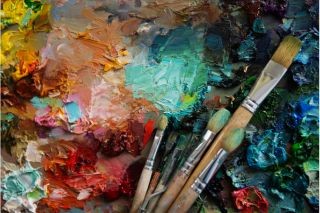
Art is an essential part of the human experience. It enables us to communicate with one another, express ourselves, and get new perspectives on the world. Arts education can help high school students develop their creativity, critical thinking skills, and problem-solving abilities. It can also help build self-confidence and resilience.
What is arts education?
Arts education is a broad term that encompasses all of the different ways that students can learn about and engage with the arts. This can include classes in painting, drawing, sculpture, music, dance, theater, and more. Arts education can also be more informal, such as taking part in an art club or attending a museum or concert.
Free Digital SAT Practice Tests & Events
Evaluate and improve your Digital SAT score.
Why is arts education important for high school students?
For high school students, arts education is crucial for a variety of reasons. Here are a few examples:
Creativity: By allowing students to express themselves in a variety of ways, arts education can aid in students’ creative growth by generating fresh ideas and problem-solving techniques.
Critical thinking: Analyzing and interpreting different works of art can help students better understand the world around them and make informed decisions.
Problem-solving: As students develop skills to come up with solutions to creative challenges, they can better deal with challenges in their everyday lives.
Self-confidence: Arts education can help students to develop self-confidence by giving them the opportunity to succeed in a challenging environment. This can help them believe in themselves and their abilities.
Resilience: Teaching students how to cope with failure and disappointment can help them bounce back from setbacks and persevere in the face of challenges.
Growth mindset: This is the belief that you can learn and improve with effort. Arts education can help students develop a growth mindset by providing them with opportunities to challenge themselves and learn new things.
Well-rounded individuals: Many students can explore and discover their interests and talents outside of the classroom. This can make them more well-rounded individuals and give them a competitive edge in college and the workforce.
Concrete Benefits for Students
Arts education can benefit high school students in many ways. Here are just a few examples:
A student who is struggling in math may be able to better understand the concepts by creating a visual representation of them.
A student who is shy may be able to come out of their shell by participating in a drama class.
A student who is struggling with their self-esteem may be able to boost their confidence by learning to play an instrument or by participating in a dance class.
A student who is interested in pursuing a career in the arts may be able to get the training and experience they need through arts education.
A student who is interested in a particular field, such as science or business, may be able to use the skills they learn in arts education to better understand that field.
A student who is simply looking for a way to express themselves creatively may find that arts education provides them with the outlet they need.
The Benefits of Arts Education for the Individual
In addition to the benefits that arts education can have for students' academic performance, there are also many personal benefits that students can gain from participating in the arts. These benefits include:
Increased self-esteem: Arts education can help students develop a positive sense of self-worth by giving them opportunities to express themselves creatively and to achieve success.
Improved social skills: Arts education can help students develop their social skills by requiring them to work together with others and to communicate effectively.
Reduced stress and anxiety: Arts education can help students reduce stress and anxiety by providing them with a creative outlet and by helping them to relax and de-stress.
Improved mental health: Arts education can help improve students' mental health by providing them with a sense of purpose and belonging.
Increased happiness: Arts education can help increase students' happiness by giving them a sense of joy and satisfaction.
The Benefits of Arts Education for Society
The benefits of arts education extend beyond the individual student. Arts education can also benefit society as a whole. These benefits include:
A more creative and innovative society: Arts education can spark creativity and enrich the community by encouraging people to think outside the box.
A more tolerant and understanding society: Arts education can help create a more tolerant and understanding society by exposing people to different cultures and perspectives.
A more civic-minded society: Arts education can help create a more civic-minded society by teaching people about the importance of civic engagement.
A more economically vibrant society: Arts education can help create a more economically vibrant society by producing skilled workers and by attracting businesses and tourists.
The Importance of Arts Education in High School and Future Planning
Arts education is especially important in high school, when students are making important decisions about their future. Arts education can help students explore their interests and talents, and it can also help them develop the skills they need to succeed in college and the workforce.
How to Get Involved in Arts Education
There are many ways to get involved in arts education. You can take classes at your school, join an arts club, or attend a museum or concert. You can also volunteer your time at an arts organization.
The Future of Arts Education
The future of arts education is bright. There is growing recognition of the value of arts education, and there is a movement to make arts education more accessible to all students. There have been efforts to promote additional funding for arts education as well as advocacy to provide more support for the proliferation of the field.
Arts education is an essential part of a balanced education. It can help students develop their creativity, critical thinking skills, and problem-solving abilities in order to make them well-rounded individuals and prepare them for a bright future ahead. If you are a high school student, it would be wise to get involved in arts education, an investment in your personal growth and future.
Brookings Arts Edutopia

Explore Colleges For You
Connect with our featured colleges to find schools that both match your interests and are looking for students like you.

Career Quiz
Take our short quiz to learn which is the right career for you.

Get Started on Athletic Scholarships & Recruiting!
Join athletes who were discovered, recruited & often received scholarships after connecting with NCSA's 42,000 strong network of coaches.

Best 389 Colleges
165,000 students rate everything from their professors to their campus social scene.
SAT Prep Courses
1400+ course, act prep courses, free sat practice test & events, 1-800-2review, free digital sat prep try our self-paced plus program - for free, get a 14 day trial.

Free MCAT Practice Test
I already know my score.

MCAT Self-Paced 14-Day Free Trial

Enrollment Advisor
1-800-2REVIEW (800-273-8439) ext. 1
1-877-LEARN-30
Mon-Fri 9AM-10PM ET
Sat-Sun 9AM-8PM ET
Student Support
1-800-2REVIEW (800-273-8439) ext. 2
Mon-Fri 9AM-9PM ET
Sat-Sun 8:30AM-5PM ET
Partnerships
- Teach or Tutor for Us
College Readiness
- International
Advertising
Affiliate/Other
- Enrollment Terms & Conditions
- Cigna Medical Transparency in Coverage
Register Book
Local Offices: Mon-Fri 9AM-6PM
- SAT Subject Tests
Academic Subjects
- Social Studies
Find the Right College
- College Rankings
- College Advice
- Applying to College
- Financial Aid
School & District Partnerships
- Professional Development
- Advice Articles
- Private Tutoring
- Mobile Apps
- International Offices
- Work for Us
- Affiliate Program
- Partner with Us
- Advertise with Us
- International Partnerships
- Our Guarantees
- Accessibility – Canada
Privacy Policy | CA Privacy Notice | Do Not Sell or Share My Personal Information | Your Opt-Out Rights | Terms of Use | Site Map
©2024 TPR Education IP Holdings, LLC. All Rights Reserved. The Princeton Review is not affiliated with Princeton University
TPR Education, LLC (doing business as “The Princeton Review”) is controlled by Primavera Holdings Limited, a firm owned by Chinese nationals with a principal place of business in Hong Kong, China.
Seneca Academy
Preserving the Wonder of Childhood
Arts Integration in School: 10 Reasons Why It’s Important
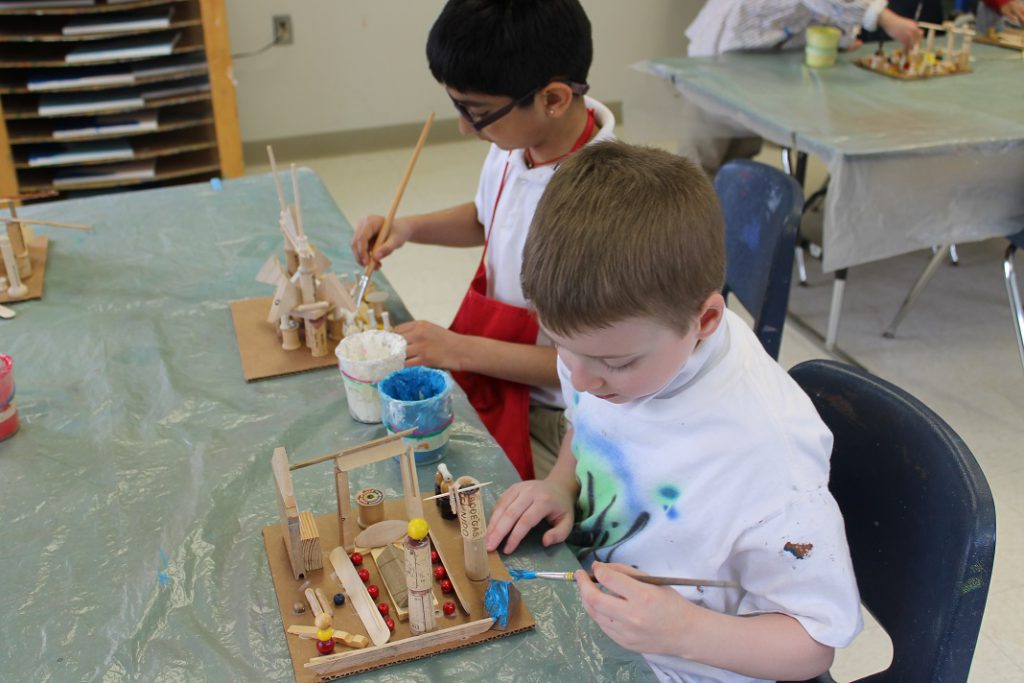
It was not long ago that arts education in schools was thought to be a luxury, and arts classes were cut from the curriculum to make room for more time to prepare for standardized tests. Currently, there is more and more information available that shows how crucial arts integration is to creating well-rounded, well-prepared learners and leaders. Articles with titles such as “ Teachers are using theater and dance to teach math — and it’s working ,” and “ Arts-Based Education Will Power the Creative Economy ” discuss the theory and research behind such claims.
At Seneca Academy, the arts (fine arts, drama, music, movement) have always been an integrated part of our curriculum . We weave the arts into our core classroom curricula as well as teach specific artistic skills and abilities.
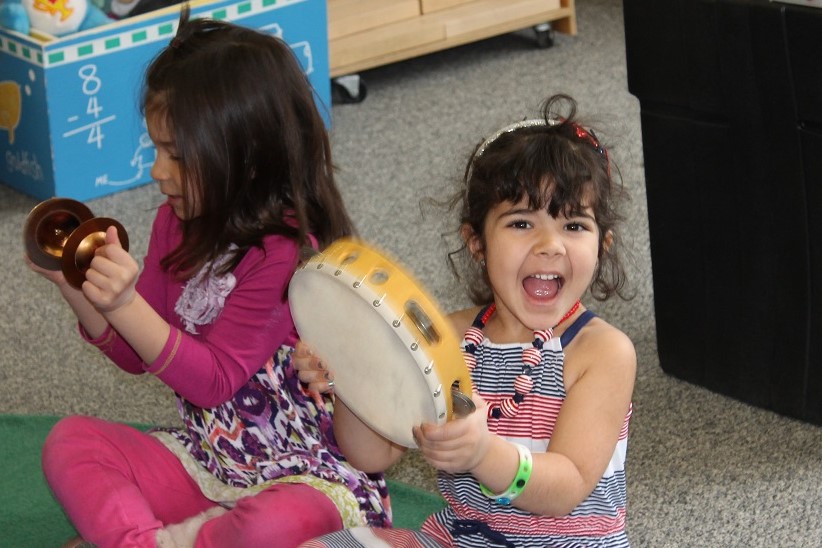
Here is what we’ve learned through experience about why arts integration is so important:
- Working in the arts helps learners to develop creative problem-solving skills.
- Teaching through the arts can present difficult concepts visually, making them more easy to understand.
- Art instruction helps children with the development of motor skills, language skills, social skills, decision-making, risk-taking, and inventiveness.
- Visual arts teach learners about color, layout, perspective, and balance: all techniques that are necessary in presentations (visual, digital) of academic work.
- Integrating art with other disciplines reaches students who might not otherwise be engaged in classwork.
- Arts experiences boost critical thinking, teaching students to take the time to be more careful and thorough in how they observe the world.
- The arts provide challenges for learners at all levels.
- Art education connects students with their own culture as well as with the wider world.
- A report by Americans for the Arts states that young people who participate regularly in the arts (three hours a day on three days each week through one full year) are four times more likely to be recognized for academic achievement, to participate in a math and science fair, or to win an award for writing an essay or poem than children who do not participate.
- A study of Missouri public schools in 2010 found that greater arts education led to fewer disciplinary infractions and higher attendance, graduation rates, and test scores.
Learn More About Seneca Academy Curriculum
Read More About Arts Integration:
Champions of Change: The Impact of the Arts on Learning
Early Childhood Arts Education Improves Vocabulary, Communication, and Memory in Young Children
High Arts Involvement Among Disadvantaged Students Is Related to Finding a Better Job, Earning Degrees, and Volunteering
Students with High Levels of Art Involvement Are Less Likely to Drop Out of School
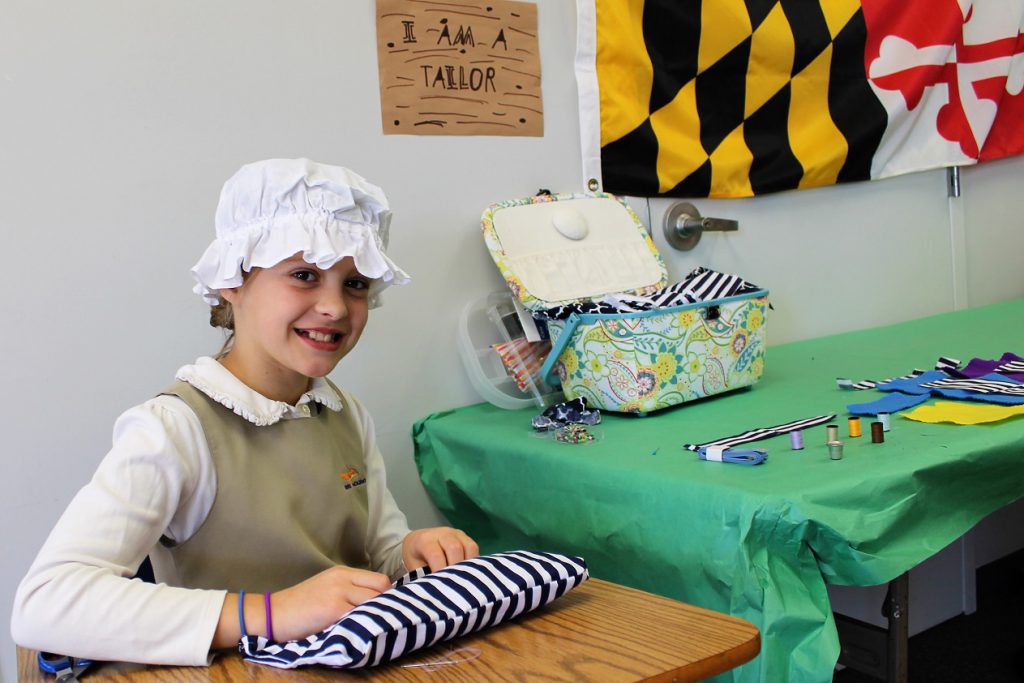
Seneca Academy is an International Baccalaureate Primary Years Program (IB PYP) World School that fosters children’s natural curiosity and ignites a love of learning through a collaborative, inquiry-based program in a dynamic and welcoming community.
15601 Germantown Road, Darnestown, MD 20874 Phone: (301) 869-3728 • Fax (301) 869-3348

You have successfully submitted your Parent’s Day Out application for the 2020-2021 school year! Once again, we appreciate you being a part of the Seneca Academy village.
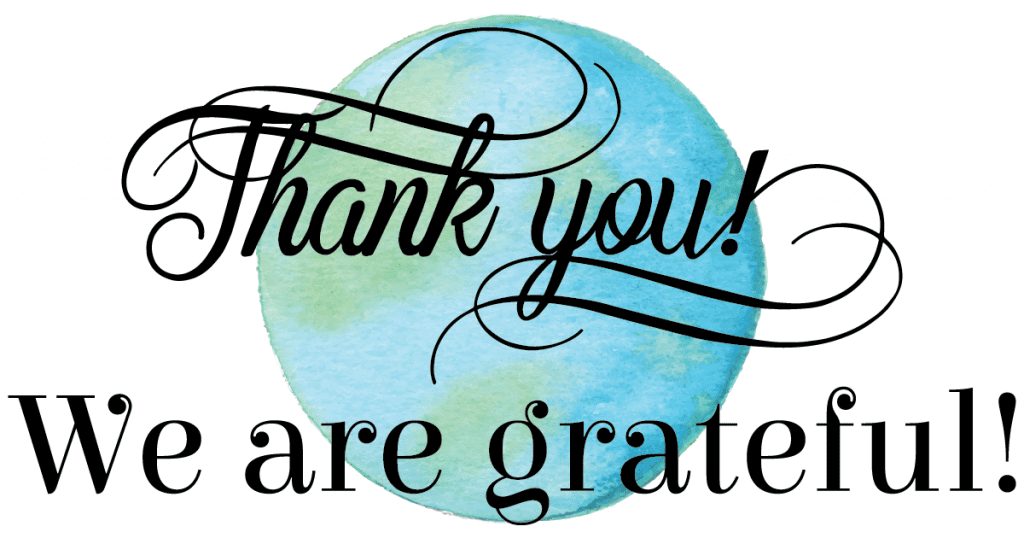
Thank you so much for your sponsorship of Seneca Academy’s 2020 auction and gala, “Around the World.” Because of you and other generous supporters, we are able to continue serving the children and families in our school as well as the community at large. We appreciate your gift to help us preserve the wonder of childhood for years to come!
Thank you so much for your donation to Seneca Academy’s 2020 auction and gala, “Around the World.” Because of you and other generous supporters, we are able to continue serving the children and families in our school as well as the community at large. We appreciate your gift to help us preserve the wonder of childhood for years to come!
National Endowment for the Arts
- Grants for Arts Projects
- Challenge America
- Research Awards
- Partnership Agreement Grants
- Creative Writing
- Translation Projects
- Volunteer to be an NEA Panelist
- Manage Your Award
- Recent Grants
- Arts & Human Development Task Force
- Arts Education Partnership
- Blue Star Museums
- Citizens' Institute on Rural Design
- Creative Forces: NEA Military Healing Arts Network
- GSA's Art in Architecture
- Independent Film & Media Arts Field-Building Initiative
- Interagency Working Group on Arts, Health, & Civic Infrastructure
- Mayors' Institute on City Design
- Musical Theater Songwriting Challenge
- National Folklife Network
- NEA Big Read
- NEA Research Labs
- Poetry Out Loud
- Save America's Treasures
- Shakespeare in American Communities
- Sound Health Network
- United We Stand
- American Artscape Magazine
- NEA Art Works Podcast
- National Endowment for the Arts Blog
- States and Regions
- Arts & Artifacts Indemnity Program
- Arts and Health
- Arts Education
- Creative Placemaking
- Equity Action Plan
- Historically Black Colleges and Universities (HBCUs)
- Literary Arts
- Native Arts and Culture
- NEA Jazz Masters Fellowships
- National Heritage Fellowships
- National Medal of Arts
- Press Releases
- Upcoming Events
- NEA Chair's Page
- Leadership and Staff
- What Is the NEA
- Publications
- National Endowment for the Arts on COVID-19
- Open Government
- Freedom of Information Act (FOIA)
- Office of the Inspector General
- Civil Rights Office
- Appropriations History
- Make a Donation
Why The Arts Matter
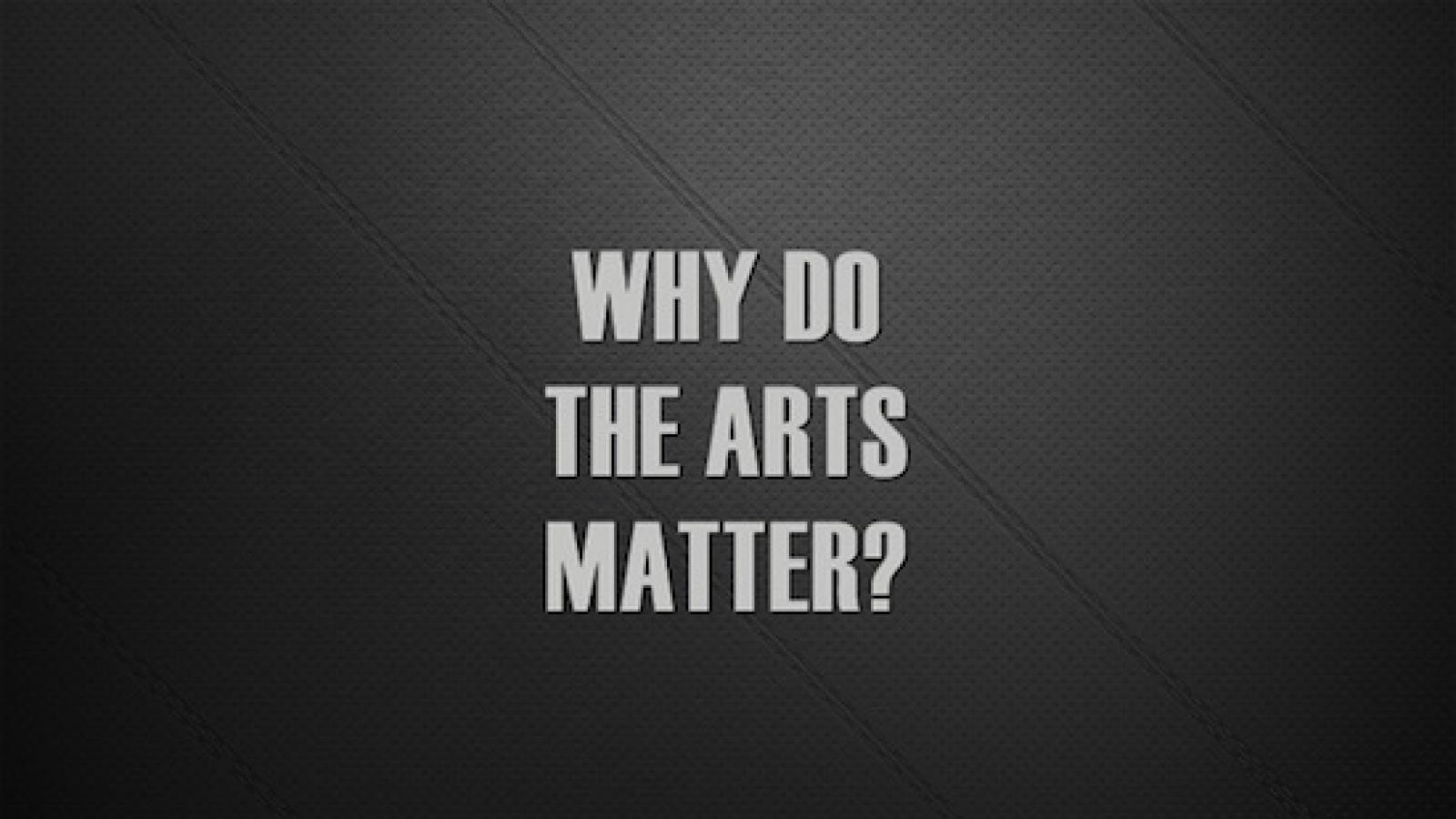
Recent Blog Posts

Stay Connected to the National Endowment for the Arts
Essay Service Examples Education Study
Why is Art Education Important in Schools Essay
Critical Discussion
- Proper editing and formatting
- Free revision, title page, and bibliography
- Flexible prices and money-back guarantee

- Atkinson, D., & Dash, P. (2005). Social and critical practice in art education. Trentham Books Ltd.
- Bartlett, S. and Burton, D. (2012). Introduction to education studies (3rd ed.). Sage Publications Ltd.
- Herne, S., Cox, S., & Watts, R. (2009). Readings in primary art education. Intellect Books.
- Hickman, R. D. (2010). Critical studies in art & design education. Intellect Books.
- Hill, D., & Robertson, L. H. (2011). Equality in the primary school: Promoting good practice across the curriculum. Continuum International Publications.
- Kelly, A. V. (2004). The curriculum: theory and practice (5th ed.). Sage Publications Ltd.
- Kenyon, G. (2019). The arts in primary education: Breathing life, color, and culture into the curriculum. Bloomsbury Education.
- Ofsted. (2018). An investigation into how to assess the quality of education through curriculum intent, implementation, and impact. Retrieved from https://assets.publishing.service.gov.uk/government/uploads/system/uploads/attachment_data/file/766252/How_to_assess_intent_and_implementation_of_curriculum_191218.pdf
- Rayment, T. (2007). The problem of assessment in art and design. Intellect Books.
- Wiles, J. and Bondi, J. (2006). Curriculum development: A guide to practice (7th ed.). Pearson Merrill Prentice Hall.
- Wilson, A. (2015). Creativity in primary education. Learning Matters Ltd.
Our writers will provide you with an essay sample written from scratch: any topic, any deadline, any instructions.
Cite this paper
Related essay topics.
Get your paper done in as fast as 3 hours, 24/7.

Most popular essays
- Blood Pressure
- Hypertension
Hypertension is one of leading illnesses in America: one out of every three Americans has this...
- Growth Mindset
Developing a growth mindset can help students set high expectations for themselves, focus on...
- Lung Cancer
Natural resources are simply the naturally occurring of resources where. People use these natural...
- Mental Illness
Is the world ready for you if you have a disability? Dyslexia is one of the learning challenges...
- Metamorphosis
Have you ever seen a human transform into a monstrous verminous bug in real life and act like one?...
Love, respect, and forgiveness are the fundamental values that every family should have. When a...
- Organizational Structure
The organizational structure is concerned with the mapping of the various organizational...
- White Collar Crime
White Collar crime generally encompasses a variety of non violent crimes that are usually...
White collar crimes are generally committed by businesses and government professionals. There are...
Join our 150k of happy users
- Get original paper written according to your instructions
- Save time for what matters most
Fair Use Policy
EduBirdie considers academic integrity to be the essential part of the learning process and does not support any violation of the academic standards. Should you have any questions regarding our Fair Use Policy or become aware of any violations, please do not hesitate to contact us via [email protected] .
We are here 24/7 to write your paper in as fast as 3 hours.
Provide your email, and we'll send you this sample!
By providing your email, you agree to our Terms & Conditions and Privacy Policy .
Say goodbye to copy-pasting!
Get custom-crafted papers for you.
Enter your email, and we'll promptly send you the full essay. No need to copy piece by piece. It's in your inbox!
5 Reasons Why Arts Education Is Important For EVERYONE

Art prodigy Autumn de Forest takes a quick break to have some fun with the Savoy Elementary students. (Photo courtesy of Relevant Communications)
“Ya gotta have art!” That was the slogan for the Detroit Institute of Arts back in the 1970s (forever immortalized by this joyfully catchy commercial ), but the sentiment regarding arts education has never been more true.
You do need arts education. We all do, and not just for high-brow reasons.
Over the past few decades, there has been a growing movement in public education and government circles to cut funding to the arts.
However, if you actually take the time to look at the data available, you’ll find the arts have a very tangible, measurable, and essential impact on our lives. It doesn’t matter if you’re an elementary school student or if you haven’t been in school for decades—the arts enrich all of us, sometimes in ways we’d never suspect.
Here are five BIG reasons why art and arts education are more important now than ever
1) Art Education Benefits Students… ALL Students
You’ve probably heard that arts education is beneficial to students, but did you know that it benefits all students, even the ones who aren’t particularly artsy?
The work of advocacy organizations like the Park West Foundation and Turnaround Arts —programs that specialize in bringing the arts to underperforming schools—has proven that both right- and left-brained kids really do benefit from arts education.
A two-year study revealed that students who participated in programs like Turnaround witnessed an overall 22.5 percent increase in math scores and 12.6 percent improvement in reading scores. If that wasn’t enough, there is further evidence that schools with arts programs do better on standardized test scores as well.
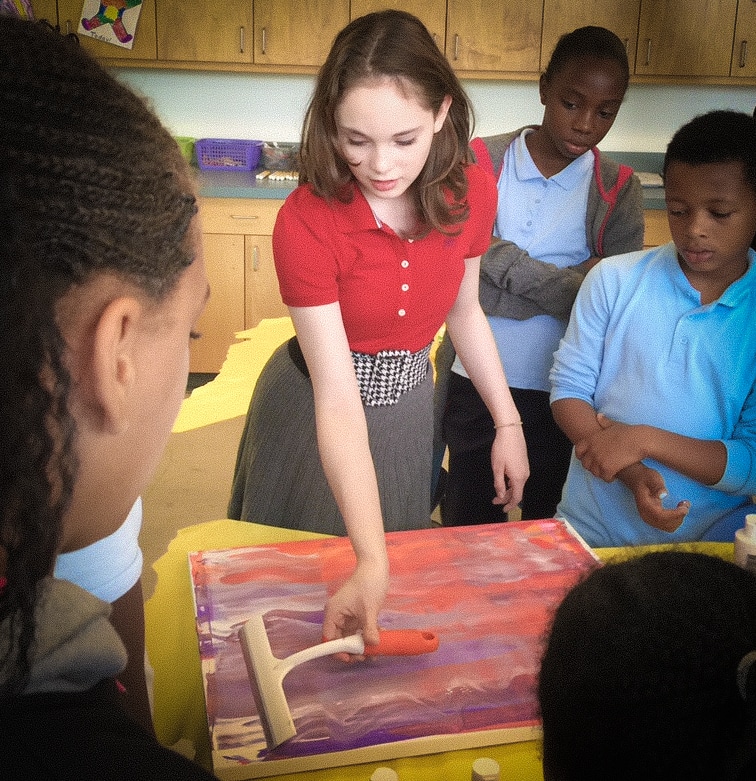
Autumn demonstrates “pull painting” to students at Savoy Elementary School with Turnaround Arts. (Photo courtesy of Doug de Forest)
2) Art Makes You Healthier
The National Endowment for the Arts recently released research from the University of Michigan, which notes that: “Older adults who both created art and attended arts events reported higher cognitive functioning and lower rates of both hypertension and limitations to their physical functioning than did adults who neither created nor attended art.”
It’s nice to know continued involvement in the arts doesn’t just benefit youngsters. Even when you’re grown, art literally makes your smarter, stronger, and faster!

“Speed of Light” (2015) Dominic Pangborn
3) The Arts Put America to Work
Yes, art can nourish our souls, but it can nourish our families as well. The next time you hear someone suggest that funding for arts education isn’t an essential expense, remind them that the nonprofit arts and culture industry drove $166.3 billion of economic activity during 2015, according to the Americans for the Arts’ fifth Arts & Economic Prosperity study .
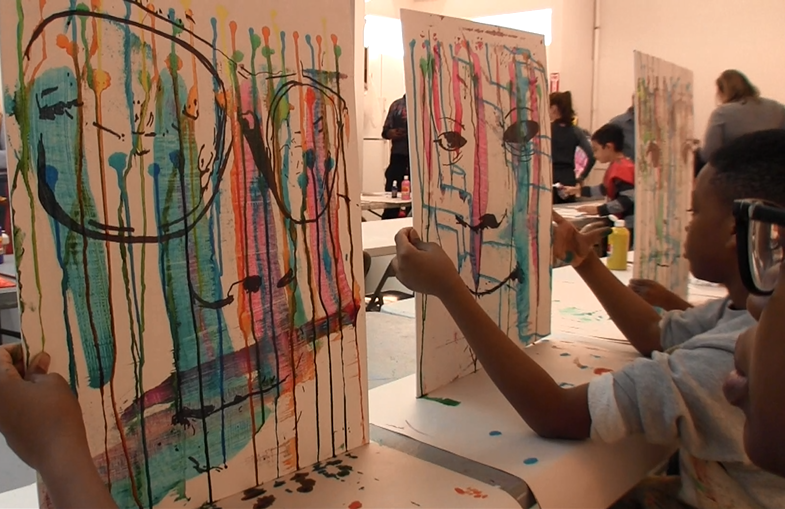
Autumn de Forest contributed her time and talents to youth in Harlem at the Art Horizons LeRoy Neiman Art Center during her exhibition “Autumn de Forest: Selected Works” held December 2, 2016 to January 31, 2017.
This activity includes 4.6 million jobs and $27.5 billion in government revenue every year. (Wow.)
4) Art Makes Us Happier
The arts can make your kids smarter, they can make you stronger, and they can put money in your pocket, but they’re not done yet—they can also make you feel better too.
Research from the University of Western Australia suggests that exposure to the arts for just two hours every week can drastically improve your mental health and overall well-being. It can be active exposure, like painting a picture, or passive exposure, like strolling through a gallery or museum.
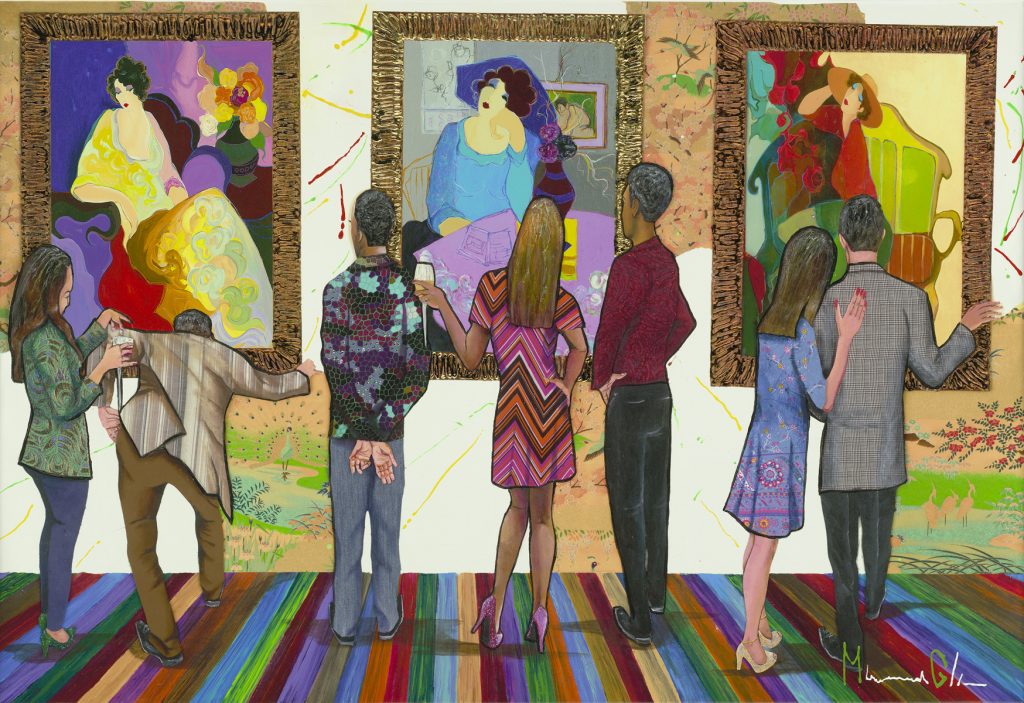
“Stepping out at the Gallery with Tarkay” (2015), Glenn Marcus
Regardless, in the words of the researchers, “engagement with art increases happiness, confidence, self-esteem and reduces stress and social isolation.”
5) Art Education Teaches Us How to Dream
We’re reminded of this fact on a daily basis at Park West Gallery—how art has that unique ability to inspire deeper meanings. Take, for example, this picture sent to us from one of our collectors, Rebecca Blackman, of her young son Romeo:
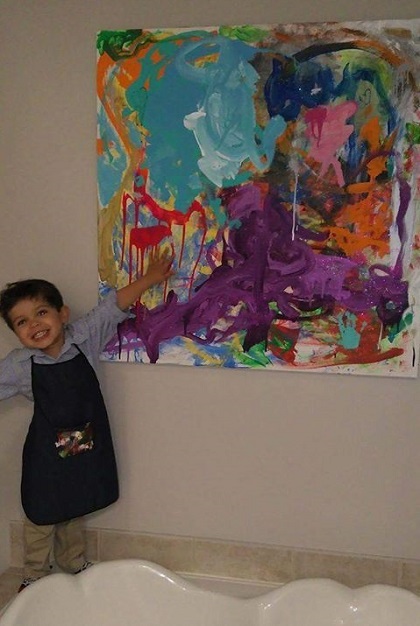
“From an early age we encouraged Romeo to express his deepest feels with his art, way before he could even speak, and because of this he has grown very fond of art and the art world alike,” Blackman says. “Every passing day, new creations are being made by Romeo, which is really amazing to see, his imagination taking off, and his natural talents flourishing.”
Even if you’re not as talented an artist as Romeo, there’s something about art that teaches us to imagine, aspire, and dream. Can you think of anything more important than that?
Whether you appreciate art on a physical or a metaphysical level, we hope everyone realizes the importance of arts education for people of all ages and continues to support the arts in all its wonderful forms. Because, remember, ya gotta have art!
Every year, we observe National Arts in Education Week , a celebration of “the transformative power of the arts in education,” which truly stresses how vital the arts can be to young people and society as a whole.
You can learn more about National Arts in Education Week here and, if you’d like to know more about the work being done by the Park West Foundation to support arts education and the welfare of young adults, you can learn more here.
To start your art collection with Park West Gallery, register for our exciting online auctions or contact a gallery consultant at [email protected] .

for breaking news, artist updates, and special sale offers

SIGN UP FOR THE PARK WEST NEWSLETTER
- Comments This field is for validation purposes and should be left unchanged.
Receive exclusives, special offers, & more!
- Career Opportunities
Join the Park West Mailing List and receive newsletters, sale updates, and $100 in Free Collectors Cash when you attend one of our live online auctions!
Terms & conditions apply

- Elevated Printing Services
- Museum Partnerships
- Our Technology
- National Gallery of Canada Collaboration
- National Gallery of Canada
- Museum Collection
- Your Cart is Empty
- Museum Collections
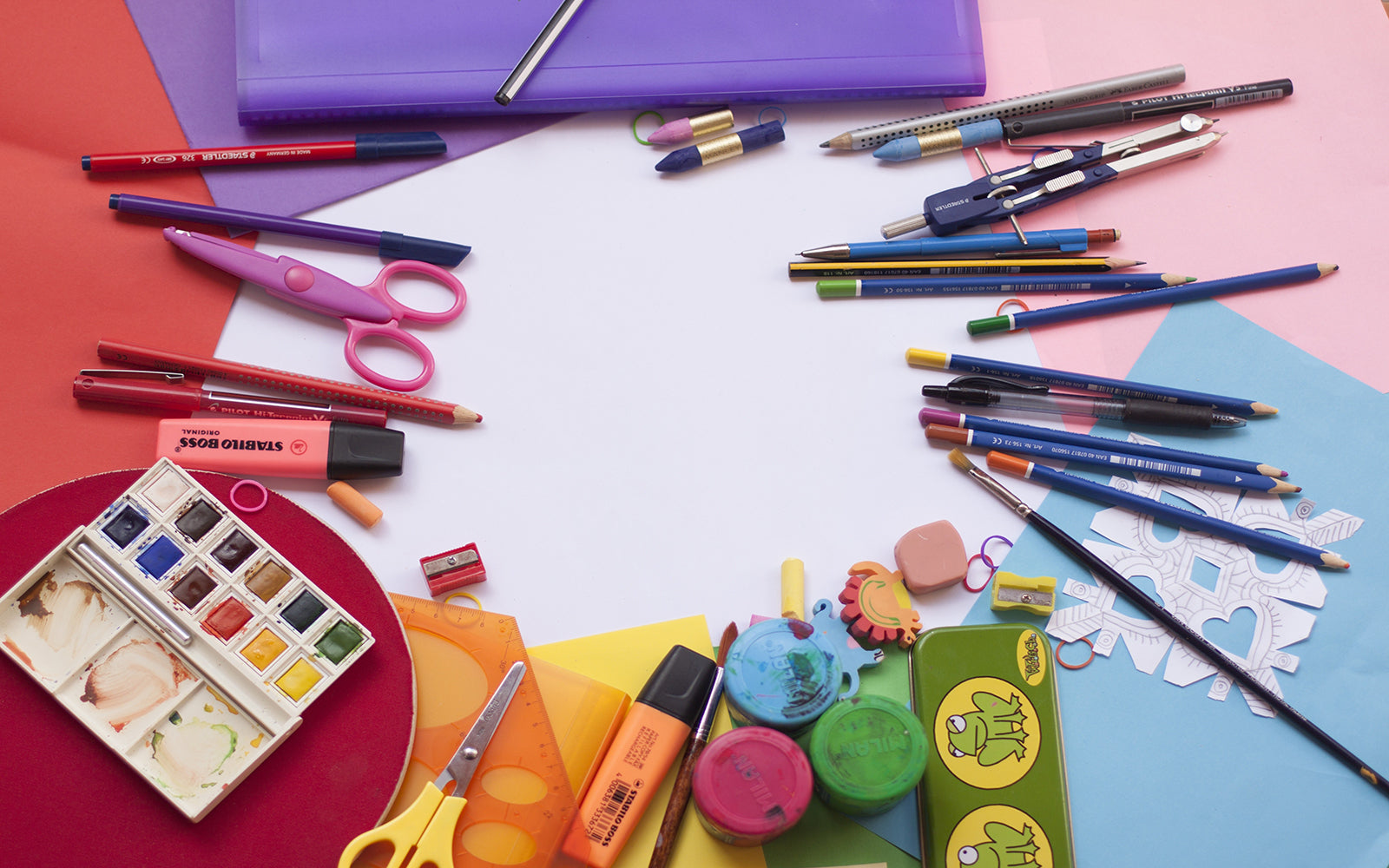
10 Reasons Why Art Education is Beneficial to Childhood Development
Culture is defined as the beliefs, customs and arts upheld in a group within society. Access to an arts education is crucial to a child’s development as it develops the child’s earliest notions of culture. For years, many have worried that schools around the globe are facing funding cuts to arts programs, while witnessing a shift in support for STEM (Science, Technology, Engineering and Math) related fields. In order to help level up arts education, we need to transform STEM into STEAM (Science, Technology, Engineering, Arts and Math).
To make the equation complete, we need to spread the message within our communities, helping society understand how crucial it is for arts education to be implemented in curricula. To help save you time researching the topic, we’ve highlighted ten ways that arts can help children understand what culture is and the fundamental skills that come with an arts education:
1. Creativity
Through arts, children can express themselves in whichever way they want! In many arts programs, instructors may ask their students to do different variations of a piece of art that may already exist. This could be in the form of taking a painting from the Renaissance such as the Leonardo da Vinci’s Mona Lisa and painting it in an expressionist manner, or taking a musical composition like Beethoven’s Für Elise and rearranging it in a different style such as hip hop.
This process is called remixing, and through these processes, children are taught to tap into their innovative side to think creatively and out of the box, in search for new ideas and concepts.

2. Cultural Awareness
Experiences that take place through the arts boost critical thinking and engages children to be careful and thorough about how to observe the world. Society overall has never been so diverse as it is now. This enables all kinds of messages and perspectives to reach and influence children. They need to critically think about them and see how they correlate to their developing world views.

Through the arts, there is access to other cultures and their art forms, which children can contextualize into their understandings, at the same time, they are also developing an insight into other, modern, ways of being.
3. Improved Academic Performance
The arts inherent creativity and with that children learn an essential skill set for success! A report done by PBS states: “A report by Americans for the Arts states that young people who participate regularly in the arts (three hours a day on three days each week through one full year) are four times more likely to be recognized for academic achievement, to participate in a math and science fair, or to win an award for writing an essay or poem, than children who do not participate.”

Photo by Pixabay on Pexel
4. Motor Skills
Art in many forms is hands-on. There are lots of physical motions involved in a creative process s uch as holding a paintbrush, scribbling with a crayon, and holding an instrument, which are all examples of a child developing their motor skills.

The National Institute of Health states that around age three is when a child should be able to draw a circle and start using safety scissors. Around age four is when they should be able to draw a square and cut straight lines
5. Visual Learning
Through processes of drawing, reading a script, and looking at a sheet of music, children can develop visual-spatial skills.

Dr Kerry Freedman, who is Head of Art and Design Education at the Northern Illinois University states that the world is much more than just text and numbers. Through processes of creating art, children can interpret, criticize and use visual information at their disposal for stylistic and aesthetic choices. Having developed a sense of visual literacy will help children and young adults navigate their way through a world that is bombarded with thousands of media messages and images by becoming smart consumers of media products and other commodities in general.
6. Problem Solving
Creative and critical thinking go hand in hand in all forms of the arts. Both sides of the brain are engaged, which happens when having to deal with a problem. Exercising both sides helps children understand that problems can have more than one solution and questions might have more than one answer.

Elliot Eisner, a Professor of Education at Stanford University states that this concept has a global scale as there are many ways to see and interpret the entire world. This view of the arts leads us away from the fact that art is only for aesthetic and provides entertainment, and parents are also able to understand that art is quite innovative.
7. Decision Making
We’ve already learned that art strengthens problem-solving and critical thinking skills, which are both a part of decision making. As artists, children have the freedom to make any choices they want when it comes to their artwork.

Questions such as: How do I express sadness in my dance routine? What colour should I paint the character’s dress? How should I play this character? or How should I change my tone to convey different emotions? are all questions an artist, and children, can ask themselves. Learning to make these decisions early on can pay off later in other areas of their life and since that skill is learned so early on, it carries over into adolescence when life can feel a little unstable at times.
8. Perseverance
Taking up and ‘mastering’ anything will be a time-consuming process. Many people have the misconception that "it can’t be very hard to draw, paint, act, play an instrument", etc. That misconception is tested when the concept of “practice makes perfect” comes into the equation.

Photo by rawpixel.com from Pexels
Children are more susceptible to feeling frustrated, and even quitting, when learning a skill doesn’t come to them right away, since all they want to want to do draw, play, sing or dance to their fullest potential. Through constant reminders that it takes time and practice, they learn that hard work and perseverance eventually pays off. This mindset is essential in higher levels of academia and in a workplace, as they will constantly be learning new skills and working through difficult processes on a journey of career development and progression.
9. Collaboration
The arts heavily rely on collaboration to make great things happen. In groups such as theatre, choir, or band, children are required to constantly work together. They are also required to share the responsibility for the work and compromise certain elements to meet a common goal among all members.

Through collaboration, children can understand that their role in the project impacts the overall success of everyone! As adults, we know all too well that collaboration becomes fundamental in home life, the workforce and in later education.
10. Accountability
Accountability is a huge factor in the arts, especially if the work is to be completed as a group. When a child is accountable for their own part or contribution within a group they learn about responsibility and dependency. If they choose to not to participate with a performance/project, they often realize how impactful it can be to let others down and what it feels like to take ownership of such outcomes.

Accountability in school and in the workforce is highly imperative if you are working in collaboration or if there is a deadline approaching. If nothing is met at the end of the day, the entire structure has fallen because they relied on the individual and all the onus is on them. Making mistakes is a part of being human, but so is learning to accept them and take ownership in order to fix them.
Start Today!
The common phrase we kept stating over and over is that art is a process and that’s because it is. Being an active participant in the arts means learning the skills and tasks that all fit into the overarching process of being creative. Becoming an active participant of the arts also means having a better understanding of culture and learning to create and appreciate visual aesthetics, which contributes to having a better understanding of the world around you!
Simple things such as going to the local museum or performing arts center with your children and attending local events centered around art appreciation are great ways to develop an early onset appreciation around art! Get a head start this summer by enrolling your child in a local arts education program, whether it be art, music, dance, theatre, all these programs contain the same benefits!
Featured photo credit to Pixabay from Pexel
"Arts Integration In School: 10 Reasons Why It’s Important." www.senecaacademy.org .
"Developmental Milestones Record: Medlineplus Medical Encyclopedia." Medlineplus.gov .
Robertson, Katrin. "The Arts And Creative Problem Solving." Tidewater Family .
"The Importance Of Art In Child Development." Education .
West, Cairo. "The Importance Of Art Education In Academic And Career Success." www.cairowestmag.com .
Leave a comment
Comments will be approved before showing up.
Also in News

Turning Back Time on Turner - An Arius Technology Digital Restoration Prototype

The Art of Insuring Art: A Practical Guide for Insuring Your Art Collection

Top 10 Most Expensive Paintings Sold at Auction in 2019
- Shipping Info
- Product FAQs
- Returns & Exchanges
- Terms of Service
- Privacy Policy
- Cookie Policy
- Refund policy
- Do not sell my personal information
Sign up to get the latest on sales, new releases and more…
© 2024 Verus Art, an Arius Technology Company .

Empirical evidence supports these claims: Among adults, arts participation is related to behaviors that contribute to the health of civil society, such as increased civic engagement, greater ...
In addition, a recent study conducted in Houston public schools showed that students who participated in arts education see the following benefits: Improved writing achievement. Reduced disciplinary infractions. More student engagement. Improved college aspirations. No drop in standardized test scores.
While arts programs often fall victim to budget cuts, they can be an important contributor to students' overall success at school. Arts education can help kids: Engage with school and reduce ...
Education: The Fundamental Importance of the Fine Arts . By Christos A. Makridis and Soula Parassidis August 2021. Key Points • Despite overwhelming support for arts education, an increasing share of children is growing up without any exposure to the arts. • Empirical evidence demonstrates a causal effect associated with arts education on cog-
Involvement in the arts is associated with gains in math, reading, cognitive ability, critical thinking, and verbal skill. Arts learning can also improve motivation, concentration, confidence, and teamwork. A 2005 report by the Rand Corporation about the visual arts argues that the intrinsic pleasures and stimulation of the art experience do ...
On top of the obvious development of individual creativity and self-expression, the arts can increase young people's confidence and motivation which in turn improves well-being and school attendance. Hands-on learning is enjoyable and engaging, helping students learn through experimentation and making mistakes.
In art class, we are always engaging our students in these highest levels of thinking. Art students are analyzing, evaluating, and creating every day. High order thinking is naturally present in art classes. As art educators, it is important to articulate why our class is important. We all know the value of art for our students.
There are the usual reasons: arts education is necessary for educating the whole child as part of a well-rounded education. The arts form the enduring legacies of all civilisations. The arts provide insight into the cultures of other periods and geographies. Arts education introduces talented students to career options.
Developmental Benefits of Arts. Arts play a significant role in the development of a child's motor skills. For instance, most of the motions involved in the creation of art, such as scribbling with a pencil or a crayon, are important in the development of fine motor skills (The future of the Australian curriculum, 2014).Participation helps learners to improve their skills in mathematics and ...
Significance of Art Education in Students' Lives. 1. Creativity. Art enhances creativity, which in turn fosters problem-solving skills. By participating in arts and learning activities, children develop confidence in their abilities and learn new things. Arts also promote risk-free exploration, and it is this freedom that inspires confidence.
Making and participating in the arts aids the development of these skills. When you study art you learn to work both independently and collaboratively, you also gain experience in time management - skillsets valued by employers. Studying the arts teaches determination and resilience - qualities useful to any career.
Here is what we've learned through experience about why arts integration is so important: Working in the arts helps learners to develop creative problem-solving skills. Teaching through the arts can present difficult concepts visually, making them more easy to understand. Art instruction helps children with the development of motor skills ...
Abstract. This review synthesizes previous research findings regarding the benefits of arts education, particularly in the visual arts, to suggest future educational directions in the United States. It recognizes the current trend in public education emphasizing accountability, which has resulted in diminishing attention to arts education.
Many of these arguments hinge on the belief that arts education is linked to academic attainment. But a systematic review carried out by myself and Dimitra Kokotsaki suggests that evidence for the ...
The arts are transformative.". - Beth Bienvenu "The arts matter because they allow you to experience different ways of seeing and thinking about life.". - Don Ball "The arts matter because life is dull without perspective. All art, good and bad, made by an individual or a team, brings the perspective of an artist to others.
Art education began to flourish as the importance of art involvement became known (DeHoyas). Figure 1 represents the answers of 97 people when they were asked whether art education was important in school from kindergarten through the twelfth grade. 100% of them answered that art education was important. This poll was conducted using people of ...
Another element in art education is music. It is so profoundly rooted in our lives. It is one of the basic ways humans create and communicate meanings. Music helps us learn about others and ourselves. It helps us to understand other cultures beliefs and traditions. Through music, students are able to be creative and imaginative, it teaches ...
Moreover, art instruction in primary school has become instrumental when it comes to the aspect of helping children in the development of language skills, motor skills, decision-making, social skills, risk-taking, and inventiveness. The transformation in the curriculum that has been undertaken in recent years regarding art education can be ...
The benefits of art education and art history go beyond the classroom. There's a multitude of reasons and study support for the implementation or art education. Not only the active art class that involves making things, but learning art history and era details can improve executive functioning in all other core subjects of schools.
3) The Arts Put America to Work. Yes, art can nourish our souls, but it can nourish our families as well. The next time you hear someone suggest that funding for arts education isn't an essential expense, remind them that the nonprofit arts and culture industry drove $166.3 billion of economic activity during 2015, according to the Americans ...
However, they are not necessary to the success of students. One of the biggest argument for art education is that it results in better test scores and higher grades. The simple fact that this is the best point art-education advocates can make is very telling. If the classes are considered essential due to their positive impact on grades, then ...
Get a head start this summer by enrolling your child in a local arts education program, whether it be art, music, dance, theatre, all these programs contain the same benefits! Footnotes: Featured photo credit to Pixabay from Pexel "Arts Integration In School: 10 Reasons Why It's Important." www.senecaacademy.org.

Home The Latest OC 50 HH50 HH55 HH66 HH77 HH88 PC48 Literature About Contact

The new HH Catamarans HH50
HH 50 Models
Privacy Policy
Purchase Process
HH 55 Interior
HH 55 Rigging
HH 55 Systems
HH 55 Sunrise
Videos Factory
HH50_update
HH CATAMARANS with SCOTT ROCKNAK
hh catamarans offered by scott rocknak, interactive fall 2020 boat show options, updated frequently, subscribe here for alerts, hh catamarans hh55 carbon fiber performance cruiser.

presented by your host and guide Scott Rocknak
Click event text below for more details, youtube live hh55, individual interactive virtual walkthroughs, individual interactive test sails, in person visits, private boat show, september 2 & 3 ( click for times ) , september 1, 2, 3 ( email for available slots), september 4 & 5 ( email for available slots), inquire, we are working on the dates, [email protected], hh catamarans hh50 carbon fiber performance cruiser.

YouTube Live HH50
September (announced soon), september (announced soon), hh catamarans oc50 e-glass performance cruiser.

presented by our guest host on site and also remotely with Scott Rocknak
Youtube live oc50, september or october (announced soon), discussion on the oc50 and how it compares to the hh50. this will be filmed aboard an hh50 with multimedia simultaneously presented on the oc50., in person visits can be arranged for qualified customers who able to visit france. our french and english speaking representative will guide you through the boat and scott will be linked virtually onboard with you for additional questions you may have. email [email protected] for details..

Join Scott Rocknak on the HH55 YouTube Live September 2 & 3.
Broadcast 1 sept. 2 & 3 (on the dock), 10:00 new york, 07:00 san francisco, 15:00 london, 16:00 paris, 17:00 moscow, 22:00 hong kong, broadcast 2 sept. 2 & 3 (underway), 18:00 new york, 15:00 san francisco, 08:00 sydney (sept 3 & 4 local).

Check back or email for the YouTube Live Links

Join Scott Rocknak on the HH50 YouTube Live September TBA
(announcement on dates soon), broadcast 1 (on the dock), broadcast 2 (underway), 08:00 sydney.

YouTube Live
Anyone with access to youtube can watch a live video. during the event your comments can be responded to in real time by us if you have questions, observations, and yes, even comments., the event becomes a standard youtube video later and is available to watch again., links will appear in the red text in the section that shows the events., hh55 september 2 & 3, hh50 (to be announced).

Personal Virtual Showings
This is a one-on-one live showing of the boat where you interact with scott and see what you want to see and ask what you want ask. jut like at a boat show but you are front of a computer or device. we will be using professional equipment and sound to mimic the way you actually see and hear., your choice of facetime, zoom, facebook messenger, or what’s app, qualification level 1 or 2 or 3.

Personal Virtual Test Sails
This also is a one-on-one live showing. this time though, we are actually sailing the boat. discover how this boat performs. since this space is rather limited we ask participants to be:, qualification level: 1.

Private in-person showings.
Here you would physically visit the boat. there are certain local requirements due to covid-19. tell us where you’re from and we can guide you how to visit and follow the guidelines., once onboard we adhere to the safety protocols set by the cdc or equivalent local authorities. , typically it takes at least an hour to thoroughly go through the boat in a precursory manner. if we are actually sailing the boat then expect to plan on at least three hours., because of the logistics and time allotments we ask you are:, qualification level 1 or 2..

Private Invitational Boat Show
Following the guidelines of the recent canceled boat shows we will be adhering to a personal experience which would be:, (1) couple and/or immediate family down below or in the cockpit at one time., (1) couple and/or immediate family on the foredeck at one time., these visits will be scheduled as best as possible, (schedule to announcement soon), qualification level 1, 2, or 3, qualifications for certain events, since the time to show boats personally are limited by the hours in the day and the limited availability of the boats we ask you adhere to the following for personal virtual showings:, level 3: interested in purchasing a catamaran within the next three years and will have the purchase funds to do so within those three years., level 2: interested in purchasing a catamaran within the next two years and will have the purchase funds to do so within two years., level 1: interested in ordering a catamaran within the next year and have funds in place to do so., hh catamarans (realistically) range from $1.6m to $4.6m us depending on the model. the size range is 50’ to 66’. there is the ability to build a 77’ and 88’ boat. an 88’ is under construction now., you should calculate in your plans to order a boat at least a year before your anticipated delivery., this website makes use of cookies. , please see our privacy policy for details..
hh catamaran for sale used
words for paper presentation

IMAGES
COMMENTS
The HH44 features luxury unlike any other 44' catamaran. Special attention has been paid to achieving a level of luxury not typically found on a cruising catamaran of this size. Headroom exceeds 2m (6'6") in the salon and 1.96m (6'4") in the hulls. ... "HH Catamarans is on a mission to redefine the concept of a luxury performance ...
The HH44 features luxury unlike any other 44' catamaran. Special attention has been paid to achieving a level of luxury not typically found on a cruising catamaran of this size. Headroom exceeds 2m (6'6") in the salon and 1.96m (6'4") in the hulls. ... HH Catamarans' award winning designs are built to exacting specifications using ...
Displacement: 9,390kg 20,701lb. Engines: 2x beta 30 + 2x 10kW hybrid drives. Base price SC: US$1,325,000 ex VAT. Builder : www.hhcatamarans.com. Disruptive, innovative, and contemporary in style ...
The carbon composite parallel hybrid HH44 is a game changing, eco-friendly cruising yacht, poised to win the hearts and minds of early tech adopters, world cruisers and serious sailors alike. The HH44 incorporates all the features that set HH Catamarans apart: excellent sailing performance, robust carbon fiber and epoxy composite construction ...
Sailing World Magazine's 2024 Boat of the Year is the HH44 Sport Cruiser, a high-tech 44-foot sailing catamaran with hybrid engines, solar arrays and more. ... but according to HH Catamarans ...
Innovative and contemporary in style and technology, this electrified HH44 takes premium end fast multihull cruising to a new level for this size says Toby H...
The HH44 is a 46ft 8in multihull with two versions: OC for ocean cruising and SC for sports cruising. It offers lightweight design, solar panels, hybrid system and custom options.
HH44. The first HH44 was launched in 2023 and premiered at the Cannes International Yachting Festival. This innovative design is the "baby" of the HH Catamarans range and has some interesting features such as her closed transoms, swing aft helms and a side boarding gate aft. She's a very pretty cat and will turn heads in the marina.
June 26, 2024. The HH44-SC's tiltable wheels let the skipper lean out in the breeze or stand inboard under cover, with a clear view through the salon's vertical windows. Walter Cooper. There are many outstanding, even outrageous, things one can say about the HH44-SC catamaran. It's the latest in a series of upscale boats conceived by HH ...
2025 HH Catamarans 44. Request price. Rossinante Yachts BV | Oostmahorn, Netherlands. Sponsored Boats | related to your search. 2024 Sea-Doo Switch Cruise Limited 21. US$48,999. Performance East Inc | Goldsboro, North Carolina. 2023 Silver Wave 2410 SW3 RLP. US$52,999. Performance East Inc | Goldsboro, North Carolina.
What HH Catamarans model is the best? Some of the most widely-known HH Catamarans models currently listed include: 44, 66, HH52 and OC 50 (Inquire). Specialized yacht brokers, dealers, and brokerages on YachtWorld have a diverse selection of HH Catamarans models for sale, with listings spanning from 2017 year models to 2026.
Poised to appeal to early tech adopters, world cruisers and serious sailors alike, the HH44 is a disruptive new entry in the catamaran market, as CW's editor...
Explore HH Catamarans, the premier builder of luxury performance cruising catamarans. Discover award-winning designs and innovative carbon construction. ... Our award winning models range from 44 to 88 feet: HH44. The 2024 "Boat of the Year" is a disruptive new market entrant designed for those seeking the perfect balance of style, performance ...
In this video, we'll take you on a tour of HH 44 catamaran, the world's first parallel hybrid catamaran! The Hybrid details are at the end of the video, ENJO...
The HH 44 is a classy sports catamaran with two full-sized helm stations in the cockpit. The starboard side features the primary plotter and all control panels for anchor windlass, all electric winches (which can also be operated by foot) and some secondary displays for wind and log-data. Like on the Outremer 52, the steering wheels are mounted ...
Boats Group does not guarantee the accuracy of conversion rates and rates may differ than those provided by financial institutions at the time of transaction. Find HH Catamarans Catamaran 44 boats for sale in your area & across the world on YachtWorld. Offering the best selection of HH Catamarans boats to choose from.
The HH44, with its sleek lines, advanced materials, and cutting-edge technology, has rightfully secured its place among the top contenders. Redefining what is expected in a catamaran of this size, the HH44's range of features are inspired by the HH Catamarans ethos. The HH44 is robustly built, delivers superb light air performance, features ...
We take a sneak preview at the innovative OC44 and HH44 from HH Catamarans. To download an info pack visit: https://www.multihullcentral.com/boat/oc44/ or em...
Boats for Sale; HH Catamarans; New and used HH Catamarans boats for sale. United States; HH Catamarans HH Ocean 50; Find your dream HH Catamarans on TheYachtMarket today. We have
The new HH Catamarans HH50. HH 55. HH55_Main
Boats for Sale; HH Catamarans; New and used HH Catamarans boats for sale. United States; HH Catamarans HH Ocean 50; Find your dream HH Catamarans on TheYachtMarket today. We have
The all new HH Catamarans HH44 is a ground breaking yacht with many innovations standard. It features 100% electric propulsion with a Diesel Hybrid backup, 3...
Asking Inquire for price. HH CATAMARANS HH55 Yacht for Sale. HH Catamarans HH55 Performance Luxury Catamaran offered by Worldwide Agent Rocknak's Yacht Sales. Specifications. Acco